R a r e B o o k s L t d

BRYAN, Margaret A compendious system of astronomy, in a course of familiar lectures, In which the Principles of that Science are clearly elucidated, so as to be intelligible to those who have not studied the Mathematics: also trigonometrical and celestial problems, with a key to the ephemeris, and a vocabulary of the terms of science Used In The Lectures, Which latter are explained agreeably to their Application in them. By Margaret Bryan.

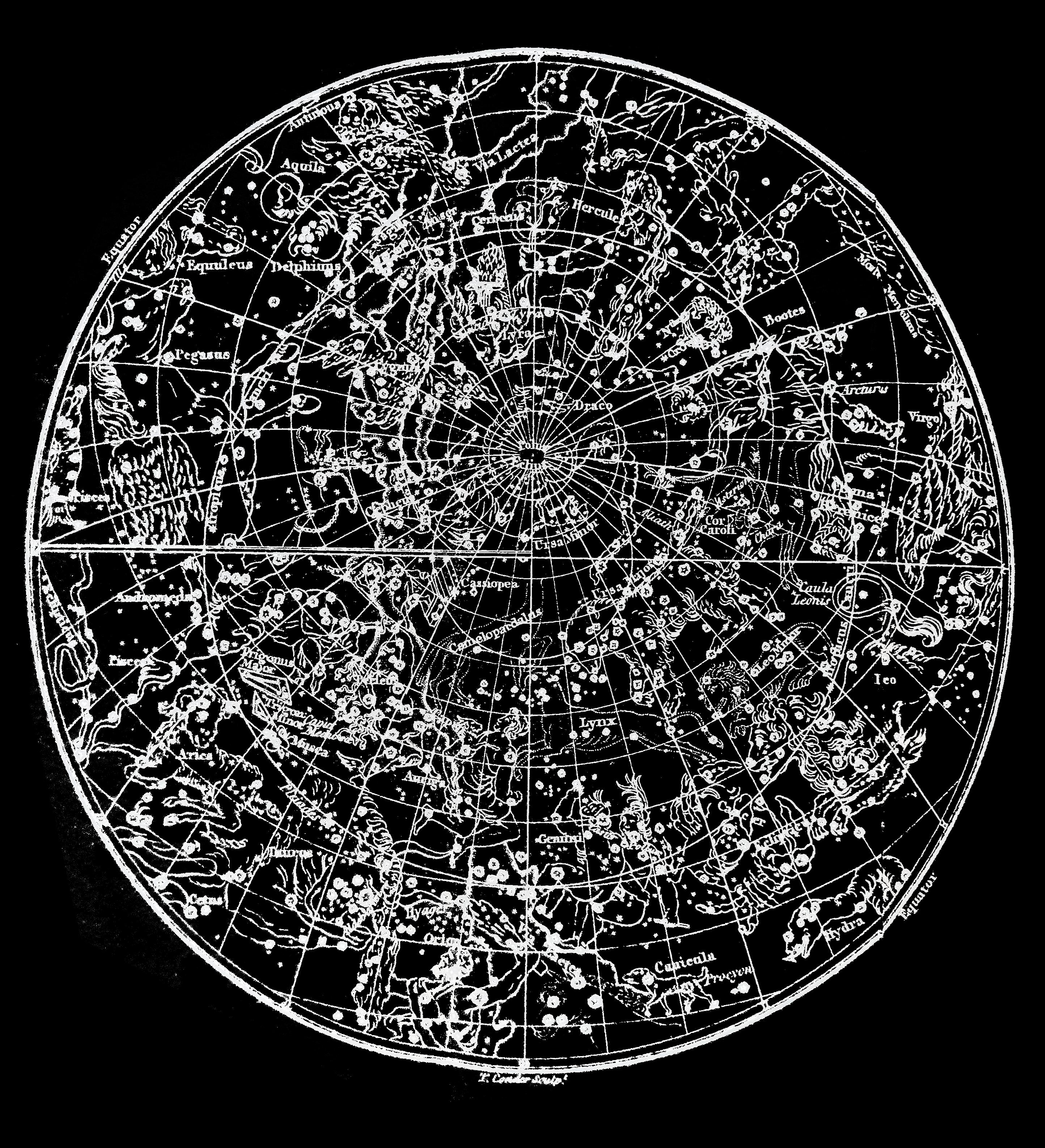
London: printed, by H.L. Galabin, Ingram-Court, Fenchurch-Street, for J. Wallis, NO. 46, and Wynne and Scholey, NO. 45, Paternoster-Row, 1799. Second edition.
Octavo. Pagination xxxviii, [2], 415,[1] 17 engraved plates, of which 3 folding. Contemporary mottled calf, gilt, rebacked, red morocco label, corners restored, text and plates foxed and water-stained, some pencil markings to margins.
Provenance: engraved armorial bookplate to pastedown and inscription to title page (“C. L. Prince / Uckfield / 1843”) of Charles Leeson Prince (1821-1899). He had a medical practice at Uckfield, but retired in 1872 to create an observatory and pursue his interest in astronomy and meteorology. He was an early pioneer of photography, kept meteorological observations and published several works on astronomy and had a fine library. He was a Fellow of the Royal Meteorological and Astronomical Societies.
¶ Margaret Bryan suffered the fate of so many women, not just of her era but throughout most of history: in the words of ODNB, “Little is known about her life” – this despite her running several schools in London and Margate at the turn of the 18th century. That they were schools for girls may partly explain the obscurity surrounding her biography. But, as ODNB also records, she was “a noted early example of a woman teaching natural science to other women”.
This is the second edition of Bryan’s first book, A Compendious System of Astronomy, based on her lecture notes and first published in 1797. In her preface, she is at pains to disclaim any originality and expresses the hope that “those whose extensive learning and liberality lead them to judge impartially” will prove themselves superior to “the false and vulgar prejudices of many, who suppose these subjects too sublime for female introspection, (ascribing to mental powers the feebleness which characterizes the constitution)” and will bestow “their avowed patronage” upon Bryan’s sincere efforts, “acknowledging truth, although enfeebled by female attire”. The preface ends with an endorsement from one such learned liberal, the mathematician and educator Charles Hutton.
The book’s engraved frontispiece is another piece of careful positioning on Bryan’s part: she is pictured sitting among her instruments, holding the viewer’s gaze, as does one of her two daughters standing next to her. The twin spheres in which Bryan moves – the domestic and the scientific – are thus combined. Her trajectory may have left few biographical traces, but this portrait symbolises her trailblazing contribution to the scientific education of women.
£1,650 Ref: 8147
ONE


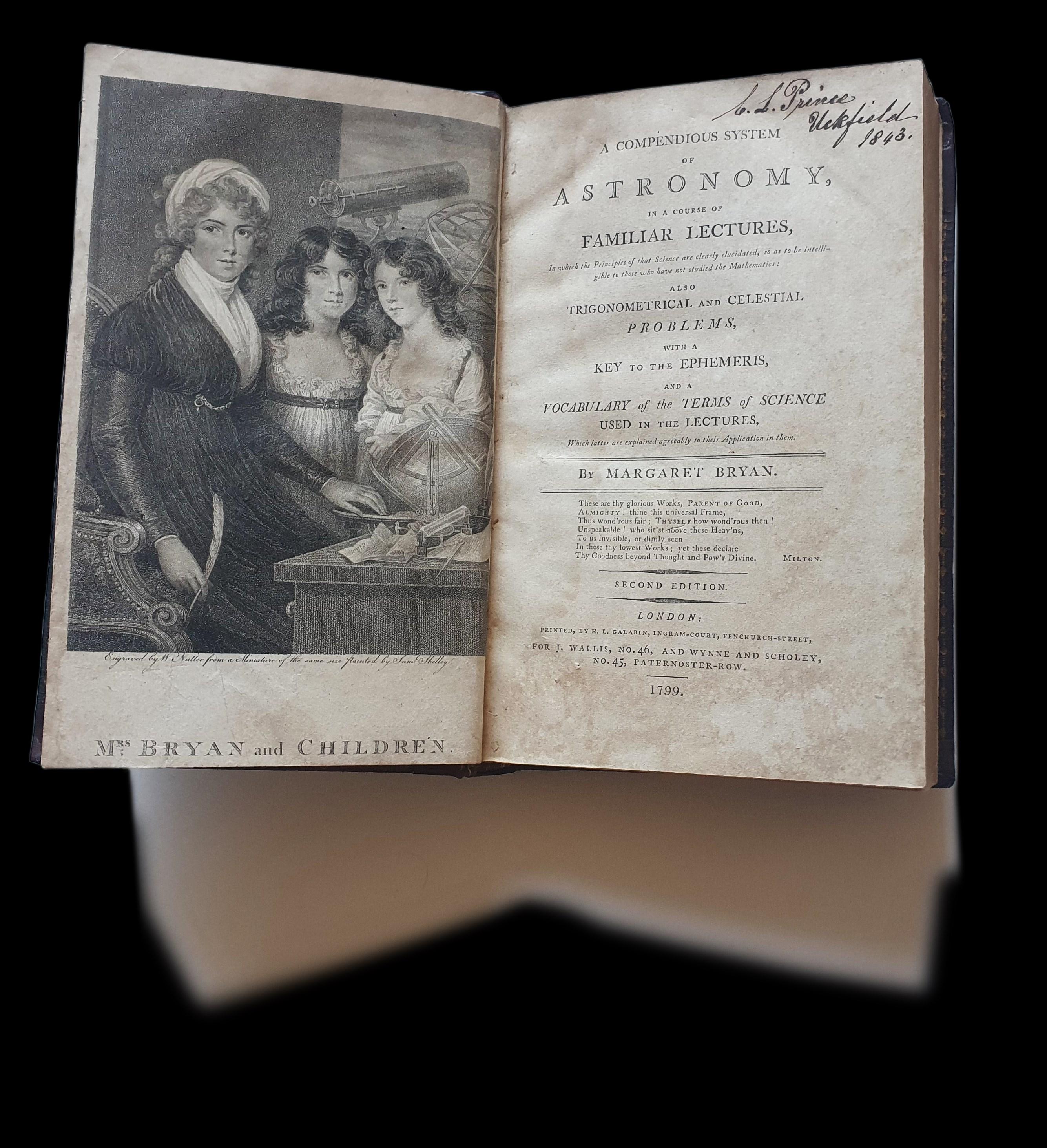
[CRAVEN, Elizabeth (née Skipworth) (1679-1704)] Late 17th-century culinary manuscript “The Lady Cravens Receipt-Booke”.
[Coome Abbey? Circa 1697-1704]. Folio (text block: 307 x 200 x 15 mm). [8 (title and index)], approximately 30 text pages, and over 130 blank pages. Contemporary panelled calf, neatly rebacked.
Watermark: Arms of Amsterdam (similar to Haewood 346-369, which he variously dates between 1670s and the 1710s); countermark: MHG interlinked. This combination is not in Haewood, but he does record a similar interlinked MHG in combination with a Fleur-de-lis (Haewood 1656, circa 1684).
Provenance: Title page reads “The Lady Cravens Receipt-Booke”. Unusually large armorial bookplate to paste-down of “The Right Honble William Lord Craven Barron Craven of Hamstead Marshall”, with the motto “Virtus in actione consistii”.
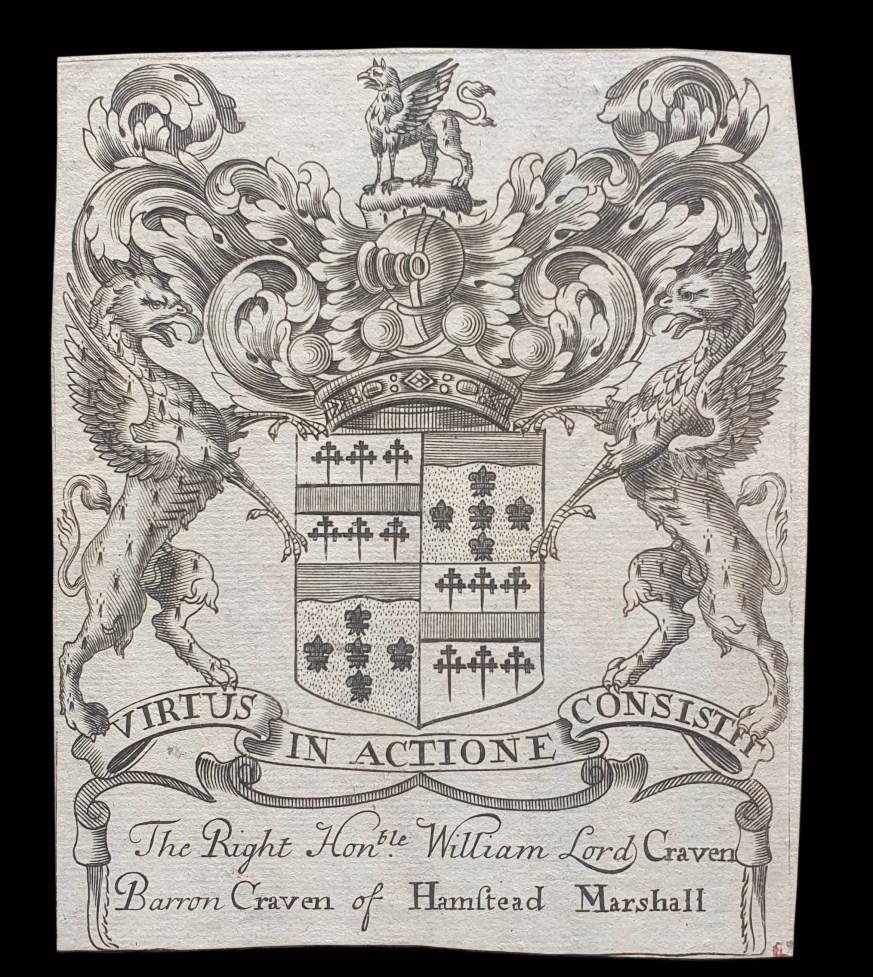
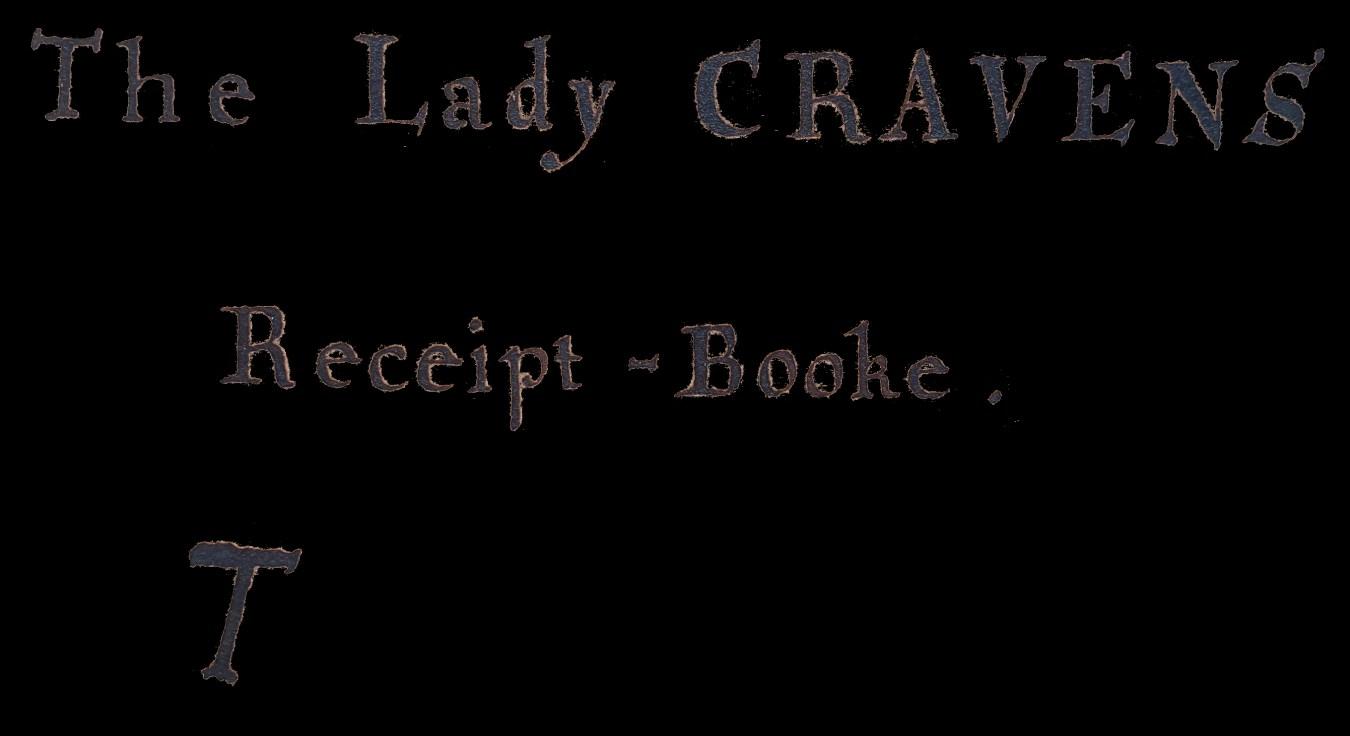
opportunity to see the original intentions of its compiler who has clearly planned her layout in advance. Sadly, Elizabeth Craven died at the age of 25, leaving many eloquently empty pages.
DATING THE MANUSCRIPT
Elizabeth styles herself “The Lady Craven” on the title page, so the manuscript must have been written sometime between the date of her marriage in 1691 and her death in 1704. One useful piece of evidence is the several mentions of “Lady Bridgman” in the manuscript – a reference to a relative by marriage who only started using that title in 1702, which narrows the dates our manuscript to the period 1702-4. This strongly suggests that the manuscript was commenced shortly before Lady Craven died and would explain the large number of unused pages.
TWO
ARRANGEMENT
Lady Craven begins her compilation with a six-page index and then carefully arranges her recipes into four sections, each of which is separated by around 20 pages.
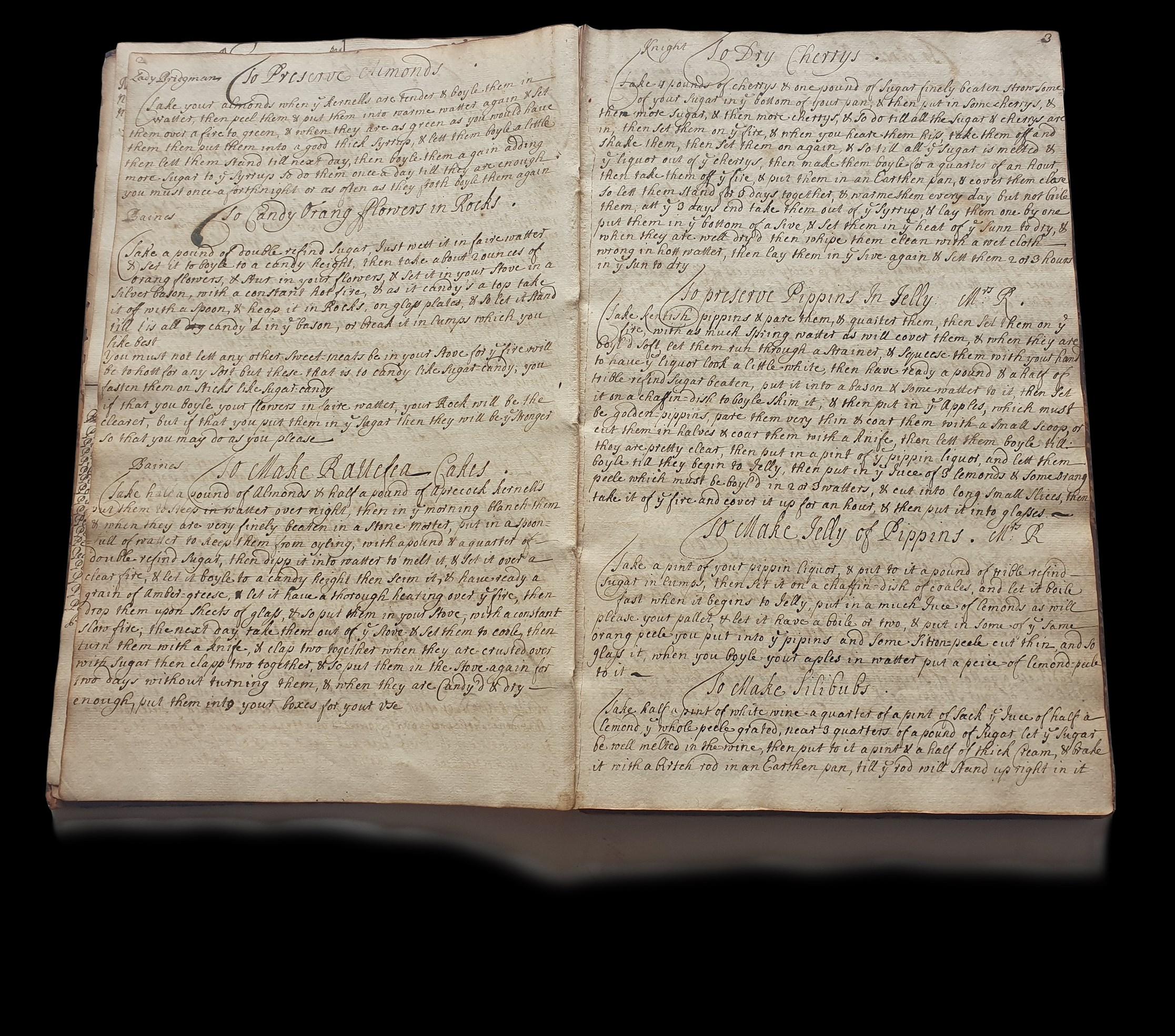
The first section (pp.1-7) contains 27 recipes for cakes, puddings and other sweet dishes including “To Candy Oranges Mrs Hudlestone”, “To make Comfitts”, “to Make Pistacho Cream”, “To preserve Pippins In Jelly: Mrs R”, “To make Silibubs”, “To Make Orang Cakes”, “Lady Anderson – To Make Fruite Biskett”, “The Spanish Cream”, “To Make Cloutted Cream”, “To Make Almond Cakes”, “Mrs Hudlestone – To Make Clear Cakes”, “To Make Cassia”, “To Make Pippin Marmelet R”, “To Make Lemond Cream”, “Lambert: To preserve Goodberry White”
The second section begins at p.55 and is represented by a single placeholder: presumably to have marked the beginning of a group of cordials and other medicaments.
After another 20 or so pages, Lady Craven created the third section, which begins with around 43 savoury dishes, but then pivots back to cakes and puddings. This shift from savoury to sweet occurs midway through a large group of recipes attributed to “Lord Craven”, so the explanation for such a disruption so soon after she began the book seems to be simply that she continued her task of copying a batch without stopping to consider the order of things. Regardless, these recipes make for interesting reading. While many are for traditional fare (“To Salt Hams – Lady Bridgman”, “Lady Duncombe – To Ragow Pidgions”, “Lord Craven’s For a Haunch or Shoulder of Venison”, “Lord Craven’s To Boyle a Legg of Mutton”), vegetables make unusually frequent appearances for an early-modern cookbook: these include “Lady: D: To Make a Ragow of Musheroms”, “Lady: Db: To Make Pottato Pye”, “To keep Artichoakes for fricaseys”, “French Beanes to keep all ye year”, and “To Dress Mushrooms”.
Following another gap of 22 blanks, Elizabeth moves to dairy produce, with directions “To Make the Angelote Chese”, “To Make a Winter Cheese”, “Make little straw Cheeses”, “Make a Slipe Coat=Cheese”, “To Make Summer Cheese”, and so on.
INGREDIENTS AND INSTRUCTIONS
The Cravens are obviously wealthy enough to afford sugar in different forms (“good loaf sugar”, “double refined sugar”, “brown sugar”, “sack-sugar”, ffine sugar”), along with a multitude of other ingredients that include “oranges”, “Lemonds” “Carroway seeds”, “Pistachos”, “Almonds”, “Aprecock kernalls”, “Candid Eringo Roots”, plenty of meat and fish, and – as indicated above
an uncommonly healthy range of vegetables. The grandly named “Beef Royall” indulges in both the specific and the casual, calling for the addition of “truffles, pestatia=nutts” and specifically, “portugall=pease” but concluding vaguely that it may be garnished with “Carrotts Lemonds, & wth else you thunk fitt”.
The methods of preparation, too, indicate a certain level of resource, whether in time, equipment or fiddliness. To “Salt hams”, the “Lady Bridgman” recommends that it be “hung up in ye Chimney to dry but not to be blake a month or six weeks will dry it”; and the recipe for “Peloe” requires “2 loynes of mutton [...] some Cubbebs, cloves, large Mace, & whole pepper, & a handfull of shallots”, seasoning and “2 pound of Indian rice”, all of which are to be cooked “for 3 hours” in “a pan that can be close riveted down that no steam can get out” – then take “a fatt fowle very handsomely boyle’d” and “put it in ye midle”
The sweet side of things is represented by the likes of “Chocolett Cream”, which mixes cream and “one spoonfull of chocolet, & ye yolks of 2 Eggs & the white of one, then sweeten to your taste, let it boyle up [...] serve when it is cold”. We assume they cooked with chocolate fairly frequently, judging by the deployment of the eponymous “Chocolet pot”. Also on offer is a recipe “To Candy Orang fflowers in Rocks”, in which the mononymic “Baines” instructs the reader “to set it to boyle to a candy height [...] with a spoon, & heap it in Rocks, on glass plates, & so let it stand till t’is all dry candy’d in ye bason, or break it in lumps which you like best”
Then there is the exotic and slightly baffling “To Dress Indian Birds Nest”, which we have not been able to trace elsewhere, but which advises that “before you boyle them doe not forgett to Cutt them Small Otherwayes they will Look Like tow and by Consequence Loathsom”.
CONNECTIONS AND CUISINE
Lady Craven’s liberal use of attributions in these recipes evokes a web of social connections; and her background confirms it. In 1697, Elizabeth Skipworth (1679-1704) married William Craven, 2nd Baron Craven of Hampsted Marshall (1668-1711) to become Lady Craven. They appear to have had four children: William Craven, 3rd Baron Craven of Hampsted Marshall (17001739) and Fulwar Craven, 4th Baron Craven of Hampsted Marshall (1700-1764), Robert Craven (1703-1715) and John (1704-?). John’s birth is recorded the same year as his Elizabeth’s death, so it is plausible that both mother and son died during or near the time of childbirth.
The Skipworths and Cravens were both wealthy, influential, land-owning families whose alliance through marriage would have been advantageous to both sides, and also branched out to other families, extending their power and influence. The ostensibly simple act of exchanging receipts forming part of the complex social web that helped maintain the threads that bound these families together and maintained their hold on power and influence. Several of their connections are traced in this manuscript. “Lady Bridgman”, for example, who provides methods “To Preserve Almonds” and “To Salt Hams”, was an acquaintance via Elizabeth’s sister-in-law Mary Dashwood, whose sister, Susanna Dashwood (c. 1685-1747), married Sir Orlando Bridgeman,
–
2nd Baronet, FRS (1649-1701) in 1702 to become Lady Bridgman. Other prominent names include “Lady Anderson” (To Make Fruite Biskett”), “Lady Duncomb” (a.k.a “Lady: Db:”, “Lady D:”) who provides at least seven recipes, including “To Dress Ealls a la Matelote”, “a Ragow of Musheroms”, and “To Make Oyster Loaves”
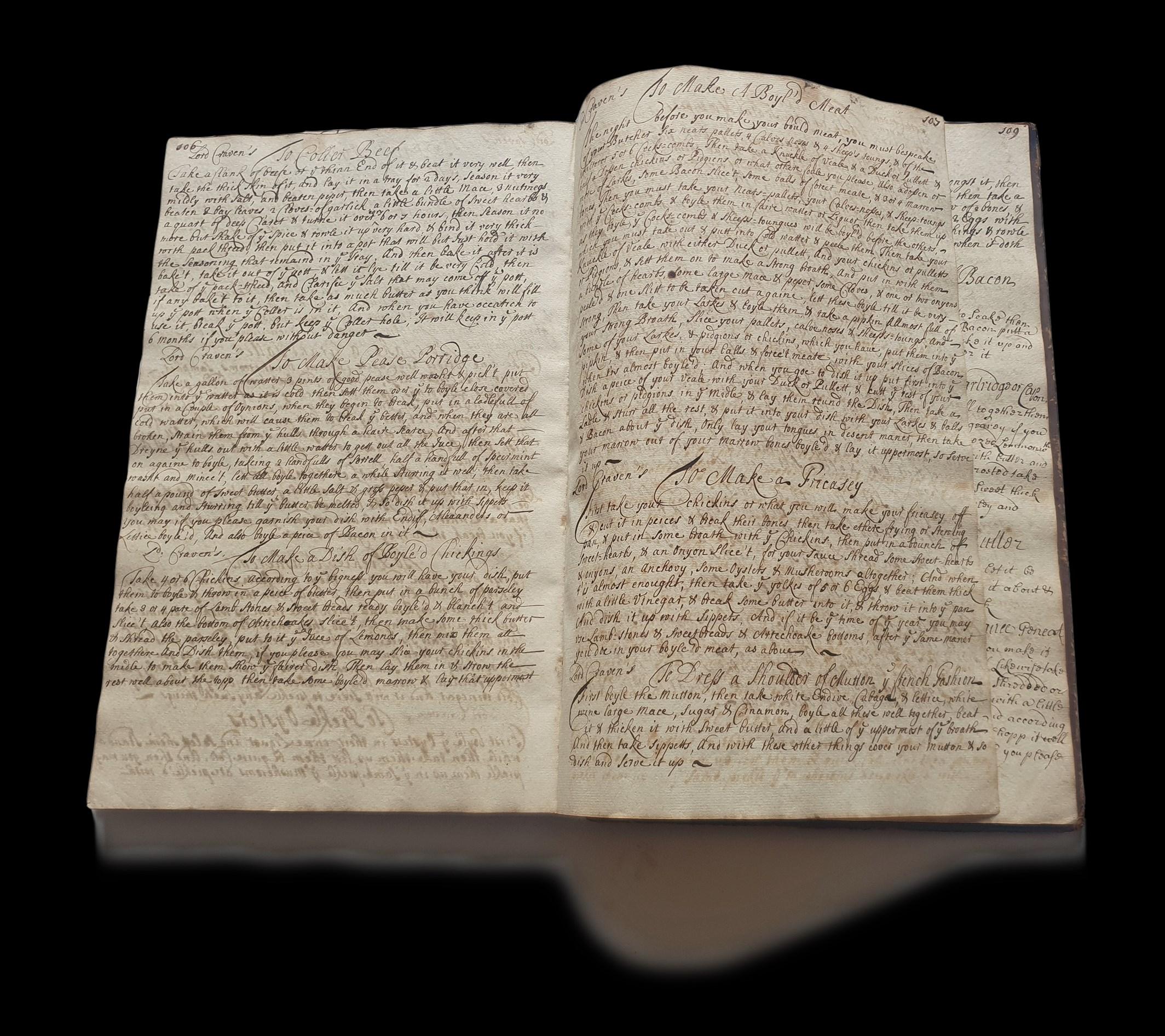
Closer to home is a “Mrs Skipwith” (sharing Elizabeth’s birth name) who knows how “To Order Bacon Like Wesfalia”, and, closer still, “Lord Craven”, who provides no fewer than 30 recipes, mostly arranged together (as mentioned above) as if copied out at the same time. These are arranged alongside lesser-known figures such as a “Mrs R”, “Lambert” (who can “Make Nuns Bisketts” or “Rattafia Cakes”) and “Baines” who, besides “To Candy Orang fflowers in Rocks” (above), also knows how to “Make rattefea Cakes”. The use of initials and untitled surnames suggest these were perhaps servants. The abundant peppering of names of eminent persons i books often acts as a form but Lady Craven herself had nothing to prove: she came f prominent family, so it seems likely that her mentions of titled relations are present more as a matter of record than a selfconscious flaunting of family connections. Although, for tragic reasons, the book does not appear to have had much practical use, it nonetheless offers an unusual glimpse of the ordering and rapid disordering of early-modern cookbooks. The blank sections between Elizabeth’s bursts of culinary ambition give this volume an unintended flavour of poignancy.
SOLD Ref: 8141
Lady Craven's family tree, whic https://www.ancestry.co.uk/family-tree/person/tree/119332615/person/372037331956/facts
[PALMER, Samuel] Early 19th century manuscript ciphering, scrap and gardening notebook
[Cira 1800-20]. Quarto (195 x 160 x 25 mm). 170 leaves (of which approximately 40 pages are in manuscript text or calculations and 68 pages of printed scraps), a few leaves excised. Contemporary green vellum. Watermark: Britannia, letters MB beneath.

Inscription to pastedown reds
“Samuel Palmer His Book”
¶ This Georgian green vellum stationer’s notebook began as the schoolboy Samuel Palmer’s ciphering book, around the beginning of the 19th century. Palmer seems to have decided he no longer needed these notes and has repurposed the volume into a scrapbook and horticultural notebook.
Many of the scraps have been pasted directly over the earlier mathematical exercises, showing how Palmer’s requirements and concerns may have altered with maturity. They have been cut from printed texts, including journals and newspapers. Clippings include articles on fashion (“Female Fashions for April”), reports of crime (John Kent was tried of assaulting, with intent to kill”, “A most barefaced robbery”, “Human Flesh market”, “A Bailiff Outwitted”), auctions (“Dr Parr We have authority to state that there is no truth in the report, of the valuable Library of this celebrated man being shortly brought to the hammer”), the arts (“Chatham Garden Theatre, This evening, Dec 10, will be presented the Comedy of The Wonder”, “New Opera called the Saw Mill”), sport (“Warwick Races”), travel (“Margate-Eclipse steam Packet”) and other newsworthy events (“Death of Lindley Murray, the Grammarian”, “Remarkable Capture of a Hare”, “Defeat of the Royalists in Peru by Bolivar”).
Palmer has flipped the volume to incorporate manuscript recipes (“Receipt for the White Scale”, “A Method of Raising Mushrooms”, “Receipt for growing Potatoes in Winter”) and notes on horticulture, including lists of plants (“List of Vines”, “List of the Bulbs sent from Town”) memoranda on work carried out (“Shifted Pines Succession 26 February 1821 [...] cut cucumbers, Planted out Melons”) and descriptions of varieties of pine trees (“the Silver Striped Pine”, “the Queen Pine”).
£450 Ref: 8123
THREE
[SPERLING, Mrs] Manuscript book of recipes and remedies.
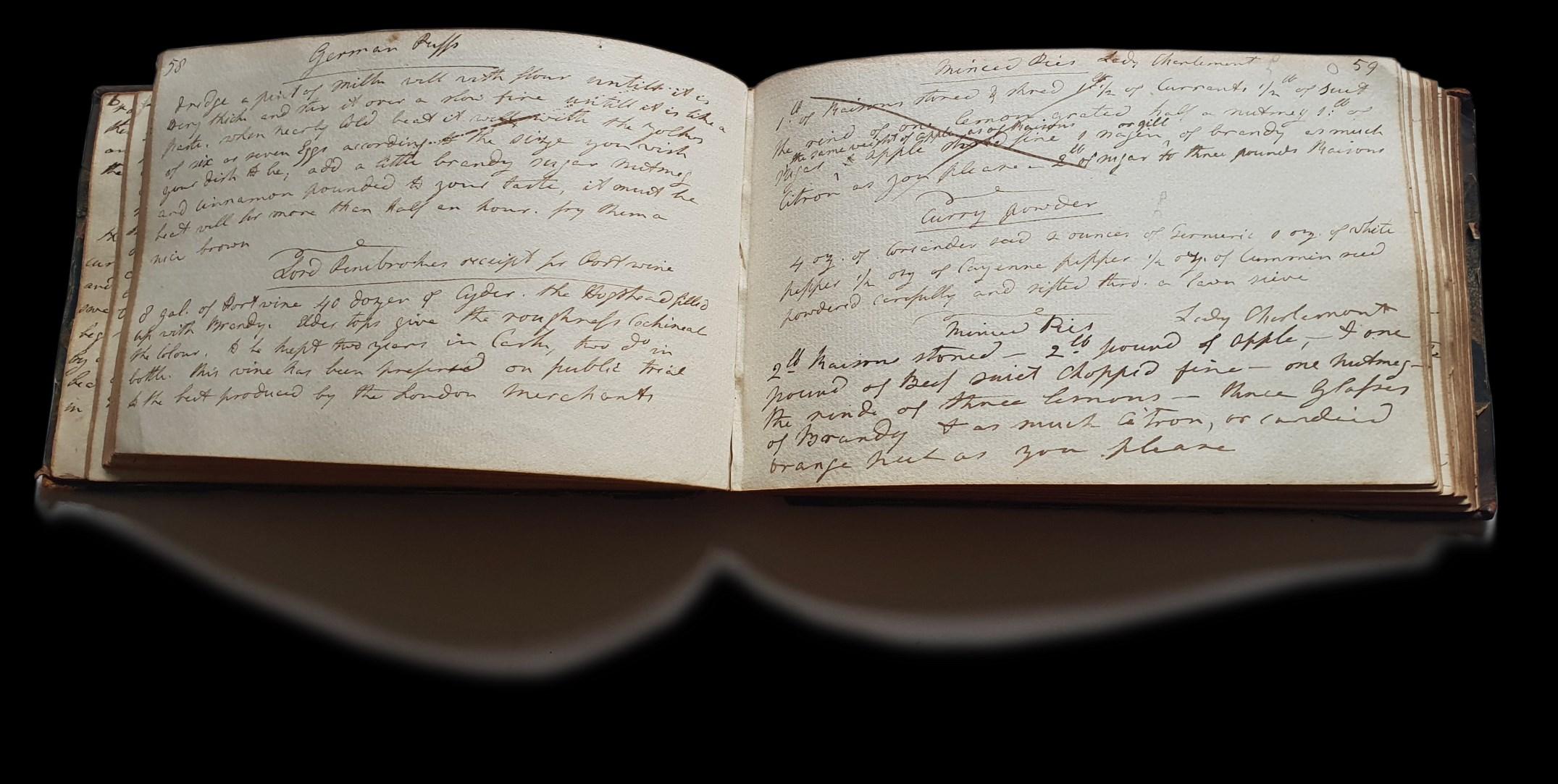
[Circa 1799-1815]. Oblong octavo (190 x 117 x 23 mm). Scraps pasted to front paste-down. [6, index] 177 numbered pages (included rear paste-down), a few newspaper cutting pasted in. Contemporary half calf, rubbed and worn., joints split Watermark: Fleurs-de-lis; J Whatman 1794. Inscription to front paste-down: “Mrs Sperling’s receipt book began about the year 1799”.
¶ This recipe book, belonging to a “Mrs Sperling”, takes the unusual format of an oblong octavo. The volume contains culinary recipes (written in multiple hands) as well household recipes and medical remedies. There are also a few culinary cuttings from newspapers which have been pasted in alongside the copied recipes.
Several of the culinary recipes are written for the “the poor” (“A Haggis for the poor”, “Cheap dish for the poor” p.45, “another cheap dish”), giving the impression that Sperling may, at least some of the time, have been cooking for others who were less fortunate. Some recipes are attributed (“Mrs Colville”, “Lady Charlemont”), but very few to specific publications, an exception to this being “Receipts for the Poor taken from The Cottage dialogues of Mary Leadbeater”.
Also included are a range of culinary recipes such as “Cheese on Toast”, “Chicken & Rice”, “Oyster Sauce”, “Milk Lemonade” and “Buttered Tart”. The volume has clearly seen action: some recipes have been crossed through, presumably where Sperling has found them unsatisfactory; others have small adjustments and notes added (“Instead of Turmeric and Keyanne Pepper, add two large tea spoonful of curry powder”) which further suggest that the volume was consulted frequently. Some recipes, in both the index and the pages, have been marked with “X” or “O” – probably to signify a pattern of usage (perhaps to indicate those to be shared with others). The latter half of the volume mainly contains medicinal remedies (“For a Cancer”, “Violets for coughs”, “Epilepsy”) and household recipes (“Wash Balls”, “Cleaning Linen by Steam”, “to die green”).
FOUR
SOLD Ref: 8143
FIVE
CORYATE, Thomas (approximately 1577-1617). [Coryats crudities; hastily gobled vp in five moneths trauells in France, Sauoy, Italy, Rhetia co[m]monly called the Grisons country, Heluetia aliàs Switzerland, some parts of high Germany, and the Netherlands; newly digested in the hungry aire of Odcombe in the county of Somerset, & now dispersed to the nourishment of the trauelling members of this kingdome.
[London: printed by VV[illiam] S[tansby for the author], anno Domini 1611]. FIRST EDITION.

Quarto. Pagination [196], 364, [23], 366-393, [23], 395-398, 403-655, [51] p., 4 engraved plates (3 folding: Clock, Stupendious Vessell, Amphitheatre of Verona), single plate present together with a copy of the same scene from the 1776 edition (both trimmed to plate edges and mounted), full-page sunburst woodcut of the Prince of Wales’ feathers, engraved portrait on p.496, text engraving of a dragon on Bbb3 verso, errata leaf at end. Text clean, a few small tears to margins very neatly repaired. Note: lacks the additional engraved title page, which is supplied in facsimile. Bound in 19th century morocco, rubbed and some wear, all edges gilt. [STC, 5808; Keynes, Donne 70; Pforzheimer 218].
¶ Thomas Coryate was perhaps one of the earliest models for our modern notion of ‘an Englishman abroad’ – well-connected, intrepid, learned, curious, foolhardy and often insensitive, Coryate travelled extensively, taking in continental Europe, Turkey, Persia and India. He often absorbed these environments at great length and made influential friends, before capping his archetype of the blithe British adventurer by dying of dysentery in Gujarat.
Coryats Crudities was the product of his first journey, in 1608, through France and Italy to Venice (en route becoming possibly the first of his countrymen to discover two Italian ‘innovations’, the table fork and the umbrella), then homewards via Switzerland and Germany. Written as a spur to his peers to broaden their outlook by undertaking such travels (anticipating the Grand Tour), the book “contains illustrations, historical data, architectural descriptions, local customs, prices, exchange rates, and food and drink, but is too diffuse and bulky […] to become a vade-mecum” (ODNB). The collector Carl Pforzheimer summarized both Crudities and its author when he remarked: “There has probably never been another such combination of learning and buffoonery as is here set forth”.
Coryate sought testimonials from fellow writers to include in the first edition of Crudities; the contributors of these mostly mock-heroic verse included Ben Jonson, John Donne, John Harington, Michael Drayton and other luminaries of the ‘Mermaid Tavern’ set of which he was also a member.
SOLD Ref: 8103

DOWNING, J. A treatise on the disorders incident to horned cattle, comprising a description of their symptoms, and the most rational methods of cure, founded on long experience. By J. Downing. To which are added, receipts for curing the gripes, staggers, and worms in horses; and an appendix, containing instructions for the extracting of calves.
[Stourbridge]: Printed and sold at Stourbridge. Sold also by T. Hurst, Messrs. Longman and Rees, Paternoster-Row; and Messrs. Rivington, St. Paul’s Church-Yard, London, 1797. Reissue of the first edition, published the same year. Octavo. Pagination xii, 131, [1], xiv (misnumbered ziv), [4] p. Lacking the half-title. Numerous blanks bound in at the end, with manuscript remedies to 14 pages. Modern half calf, marbled boards, endpapers renewed, some marks and browning to text.
¶ Downing’s treatise contains details of symptoms and treatments for diseases in cattle, together with a small number of remedies for maladies in horses. Of its over 250 listed subscribers, many are local to Stourbridge or Worcestershire generally, from where the author hailed. Many were presumably landowners, yeomen or people otherwise directly concerned with farming, but the list also includes professions such as surgeon and druggist, and of course booksellers.
Whichever of these groups our scribe belongs to, they have augmented the work into the 19th century, adding some 31 recipes and remedies (variously from 1803 to 1840) including “For Black Water in Cattle”, To Prevent Calves Striking”, “For a Gargett in a Cows
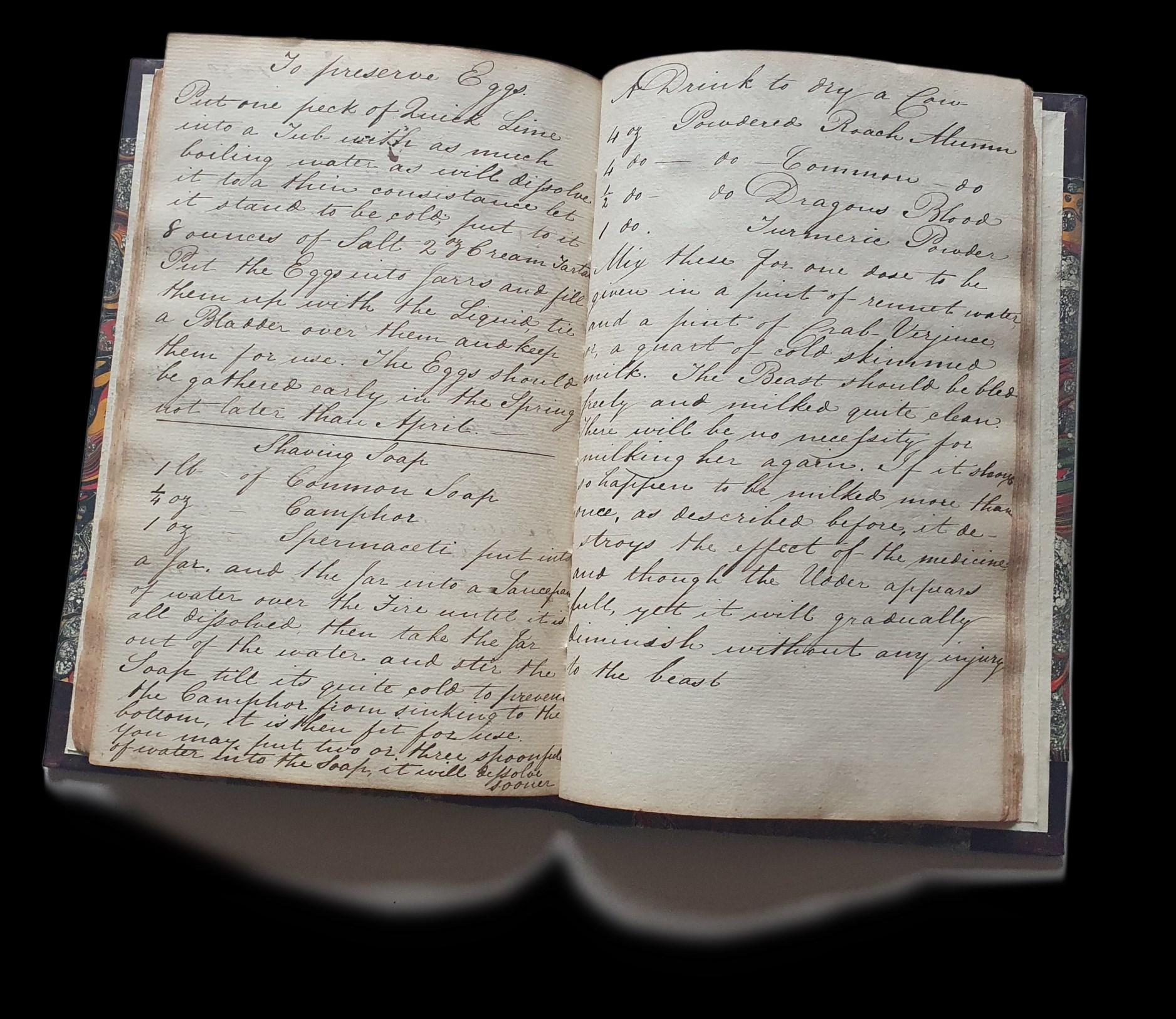
SIX
Elder”, “To take A kell of a Horses Eye”, “Diuretic for inflam’d Legs, on a Horse”, and “To prevent Sheep from striking”. Most simply list ingredients and quantities, but there are short notes (“the eye to be rub’d twice pr Day”), and some more detailed instructions like: “The Beast should be bled freely and milked quite clean. [...] If it should so happen to be milked more than once [...] it destroys the effect of the medicine [...] though the Udder appears full, yet it should gradually diminish without any injury to the beast.” Among all the practical remedies for animals, they’ve allowed themselves some indulgence, judging by “To make Punch Ice”

[WRIGHT, Rev. Thomas (c.1775-1841); PAXTON, Jonas] Claydon Rectory. Valuable and carefully selected library of upwards of 1,200 volumes, and other effects, of the late Rev. Thomas Wright, to be Sold by Auction, by Jonas Paxton. On the Premises, at Claydon aforesaid. [Claydon Rectory, Buckinghamshire. Circa 1841]. Slim quarto (193 x 162 x 4 mm). There are 21 sheets (plus a sliver of one sheet) of two octavo printed catalogues. These sheets have been trimmed and pasted to the versos of quarto stationer’s book. The title of one of the catalogues has been trimmed and pasted to the front cover, with details of the date of the sale added in manuscript.

¶ This unrecorded library catalogue chronicles the sale of the books of a largely little-known country parson. As such, it nicely reflects the reading or at least collecting tastes of literate and once-important local figures whose profiles dwindled posthumously to near anonymity, but who, through their acquisitive habits, contributed to the preservation and shaping of the wider culture and the formation of our collective memory.
THE BIBLIOPHILE
Thomas Wright was born circa 1775, the eldest son of Thomas Wright, a London merchant. As so often for the period, his mother’s name is not recorded. He was educated St. Paul’s School, London before matriculating at Pembroke College, Cambridge in 1794 (B.A. 1798; M.A. 1801). He was ordained deacon in 1798 (London), subsequently becoming rector of Otton Belchamp, Essex (1807-11), and of Little Henny (1811-20) before attaining the living as vicar of Middle and East Claydon, Buckinghamshire in 1820 until his death in 1841. Venn notes that he was the “Father of Thomas (1827)”. There are several possible matches for his marriage, but we have been unable to confirm the name of his wife or the date of their marriage with any degree of certainty. What we do know is that she predeceased him, since he requests in his will that he be “buried in the same grave as my beloved wife at Steeple Clayton”.
SEVEN
THE BOOKS
His books, however, seem to have left more of a trace in the “valuable and carefully selected library of upwards of 1,200 volumes” which lists 414 lots. The majority are individually lotted books, which usually include author’s name, title, date and very brief details (“Dryden’s Juvenal, 1713”, “Donne’s ditto [i.e. ‘LXXX Sermons’], folio, 1640”), while some lower-value items are grouped into titles of two or three (e.g. “27 Levizac’s French Grammar, hf. bd., Clef de Levizac’s 2 copies, and Boyer’s Dictionary, bd.”), and others of apparently nominal value do not justify naming (“School books”, “Ditto”).
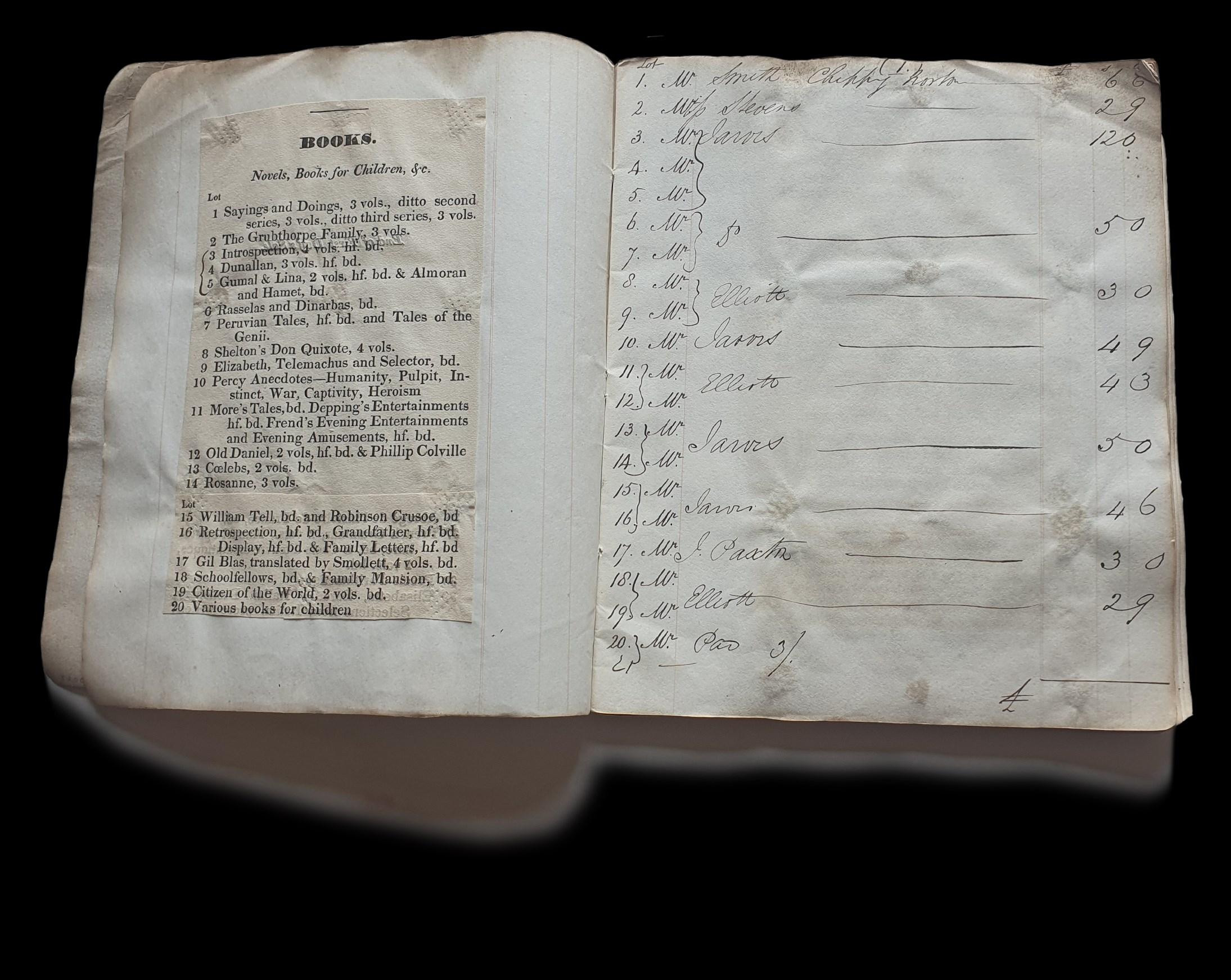
The collection has been grouped into nine categories arranged in the following order: “Novels, Books for Children, &c.” (125); “Works in Modern Languages Grammars, &c.” (26-43, plus one added in manuscript: “*43 Cobbetts Grammar”); “Works on Gardening, Botany, &c” (44-50); “Classics, School Books, &c” (51-104, although 54 is recorded as “no lot”); “Hebrew Works” (105); “Works on Law” (106-121); “Works on Divinity, Sermons, &c” (122-254*, this latter and six others extra lots are marked with an * or added in manuscript);
“Miscellaneous” (255 410); and “Odd Volumes or Imperfect Books” (411-414). The numbering is continued in manuscript to 431. These sundry lots include “Odd Books” (415-6), and five lots (427-31) of “Miscellaneous books” which were all bought by a “Mr Road” for “1.3.0”, and the others (417 -26) are left blank.
As the above list indicates, pride of place is given to novels and children’s books, although it is not certain that this reflects a value judgment by the auctioneer: of these first 25 lots, several are bundled up together (e.g. Lina, 2 vols. hf. bd. & Almoran and Hamet, bd.”, “11 More’s Tales, bd. Depping’s Entertainments hf. bd. Frend’s Evening Entertainments and Evening Amusements, hf. bd.” simply with “Ditto”. Books which warrant a single-entry name include “6 Rasselas and Dinarbas, bd”, “Shelton’s Don Quixote, 4 vols”, and “17 Gil Blas, translated by Smollett, 4 vols. bd.”
Wright kept several books on languages including Welsh, Italian, and French. The last of these is reflected in some of his books, but to judge from his collection, he preferred works in Latin or English.
Unsurprisingly for a man of the cloth, there are many theological books. These range from influential 17thcentury works like “Pearson on the Creed” in “2 vols. hf. bd”, “Butler’s Analogy” and “Taylor’s Holy Living and Dying, bd., and Pilgrim’s Progress, bd” (these latter lotted together), and important works from the 18 Theology” and “Wilberforce’s View”, through to contemporary authors such as Hannah More (here represented by “on St. Paul”, “Christian Morals”, “Moral Sketches”, and “Bible Rhymes”).
The “Miscellaneous” books encompass works of literature (including “293 Pope’s Odyssey, 5vs. bd. Ditto Iliad, 6 vols. bd. Ditto Works, 9 vols bound”, “294 Shakespeare, with notes, 8 vols. bd.”, and “329 Works of Rabelais, 1694”), travel books (“267 Maundrell’s Journey, Bingley’s Voyagers and ditto Travellers”, “283 Salame’s Algiers, bd”, “”286 Voyage to China, by M’Leod, hf. bd”), and scientific works (280 Plurality of Worlds, Fontenelle”, “325 Treatise in the Globes, 1639”, “358 Lavoisier’s Chemistry”). And Wright would have taken his place in the pantheon of the great and good recorded in “327 Graduati Canatbridgienses ab anno 1639 ad 1824”.
THE AUCTIONEER
We are confident that this was the auctioneer’s retained copy. As noted in the physical details above, it was collaged together from at least two printed copies of the catalogue and then mounted into a book to allow the scribe to record in manuscript the buyer’s names, the prices paid, and several other crucial details. These include manuscript notes such as “5 Lots of Miscellaneous works to be inserted as Lots 427, 428, 429, 430 & 431” – and the ‘clincher’ is the record of several instances of the buyer having settled their invoice (several lots are marked “Paid” or “Pd” next to the purchaser’s name).
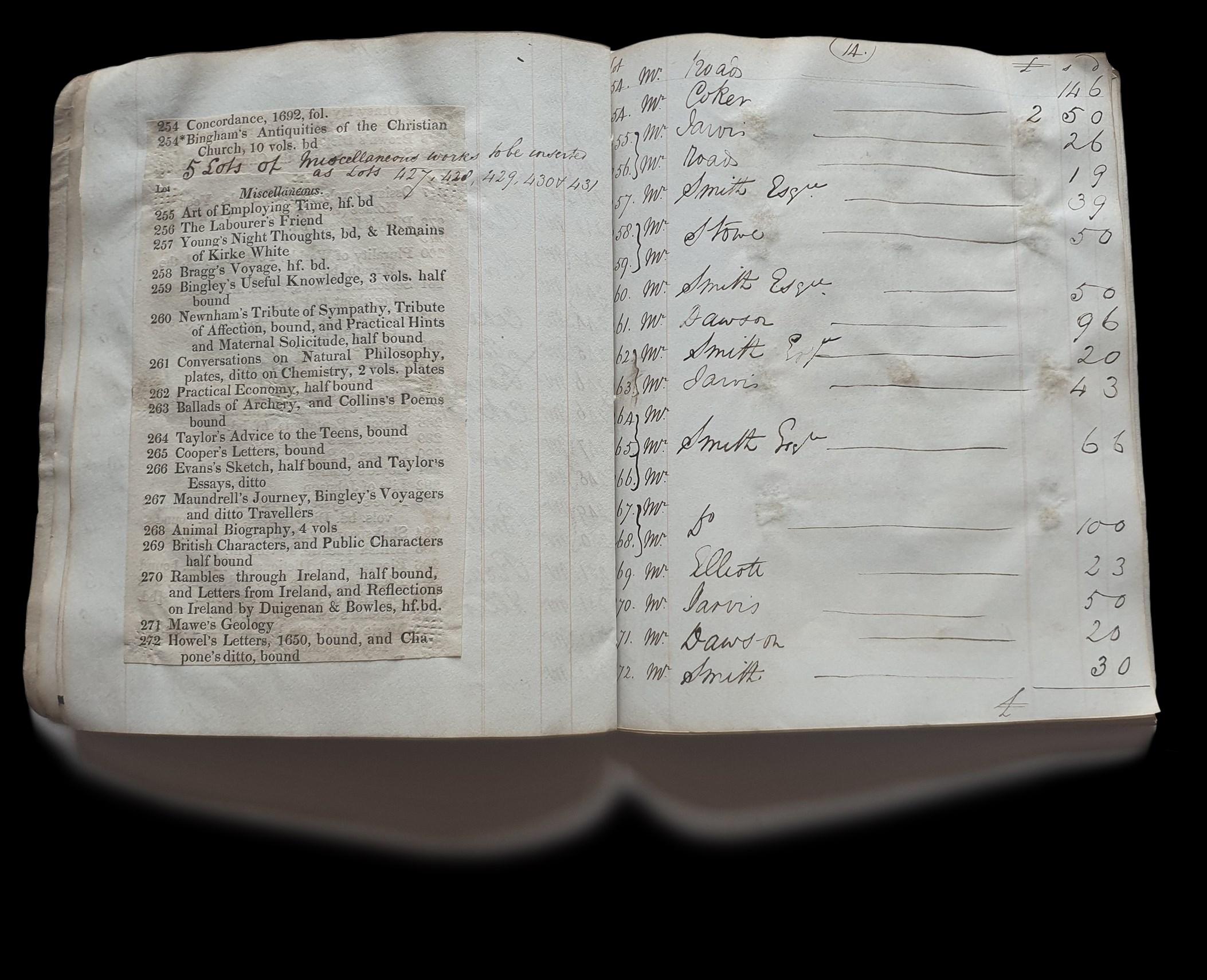
Jonas Paxton was an auctioneer based in Bicester, Buckinghamshire. From this rural market town, he held sales of farms and farmland as well as household dwellings and contents. The earliest record of his name as an auctioneer was in 1838, with the announcement in Jackson’s , of a sale to be held in Bicester. However, the earliest record for Paxton in library holdings is a catalogue for a sale held in 1849 (Particulars & conditions of sale of freehold and copyhold estates at Blackthorn and Fritwell in the County of Oxford). His son appears to have joined the firm around 1854, and Paxton senior sometimes worked in partnership with George Castle (library holdings record various combinations of Jonas, his son, and Castle). The early catalogues were often printed by “E. Smith and Son, printers and booksellers”.
As noted above, the earliest library holding for a Paxton sale catalogue is 1849. Although he travelled as far as Cambridgeshire on occasion, all his other sales were for land, dwellings, or house contents; this sale, therefore, not only marks his earliest recorded sale catalogue, but suggests a remarkably intrepid debut, involving as it did the taking on and cataloguing of a library as a stand-alone sale and conducting it in situ at Claydon Rectory.

THE BUYERS
The most voracious buyer was a “Mr Elliott”, who secured 107 lots – over a quarter of the total sale. Given the sheer quantity and range of his purchasing, we would assume he was a dealer. “Mr Rowsell” picked up 36 lots (again wide-ranging), and several buyers bought in the high teens to early twenties. A cluster of bidders secured around a dozen lots each, including a “Mr Child” who bought John Donne’s sermons for “7s”, along with several other books. After that, the purchases tail off into small amounts or even single books. Whether they were unsuccessful or highly focused in their buying is difficult to say at this distance, but a few are certainly worth drawing attention to. Paxton himself appears to have bought lot 17, “Gil Blas, translated by Smollett, 4 vols. Bd.”, for “3s” .
Paxton’s close colleague “Smith Printer” bought nine lots, including “297 Dictionary of Arts and Sciences, 8vs” for “15s” as well as Hind’s Arithmetic, Moore’s Juvenal, Edinburgh Dispensatory (342-344), and several others, so was perhaps selling books from his premises in Bicester as well as printing, among other things, Paxton’s sale catalogues. The scribe has prewritten “Mr” before each entry, but lot 35 (“Italian Pocket Dictionary and Zotti’s Italian Grammar”) has been amended to “Miss” followed by “Elliston” who paid “4s 6d” – an unusual, early record of a woman purchasing at auction.
The 1,200-plus volumes recorded in this sale catalogue offer a window onto the rich cultural and literary landscape of a rural clergyman in the early 19th century. Wright’s vocation may (or may not) have secured him eternal glory, but in the temporal realm, it was his passion for books that has left the clearest traces of his earthly existence.
£2,650 Ref: 8152
ROWLANDS, Samuel (1570?-1630?). Two editions of ‘The Famous History of Guy Earl of Warwick. Written by Samuel Rowland’
London: printed for G. Conyers, at the Gold-Ring in Little-Britain, [1680?];
London: printed for G. Conyers, at the Golden-Ring in Little-Britain, [1701?].
Octavo. Pagination 79, [1, adverts] (woodcut vignette to title page and 8 woodcuts in text); 30, [2, adverts] (woodcut vignette to title page and 7 woodcut vignettes in text). [ESTC, R218418 and T184950]. ESTC note to the latter: “NUC suggests [1690?].
G.Conyers active 1686-1712.” However, the advertisements include 19 books, some of which do not appear to be listed in ESTC, but those that do date to circa 1700-5 which supports the slightly later date.
18th-century half calf, marbled boards, rubbed and worn but sound. Title page to the 1680 edition torn at fore-edge with loss of a triangular section approximately 50 mm vertically diminishing to 25 mm into the woodcut image and a small hole (10 x 5 mm)to the upper section of the woodcut.
Provenance: inscription to verso of the 1701 edition: “Richd Paly his Book Stall not this Book for ffeear of Shame Over this there is my Name Mdcclviii”. The woodcut image has been crudely copied through in ink wash, probably by Paly. Ownership bland-stamp to first text leaf of Francis Henry Cripps-Day (1864-c.1945), antiquary, lawyer, and author of books on armour and pageantry.
Page from an old bookseller’s catalogue pasted to rear endpaper with address at its head: “66. Great Russell St., London, W.C. 1 Facing the British Museum” – probably that of James Tregaskis, who was, according to the British Museum website, a “Major London book dealer (1850-1926)” who “worked as printer in London until 1889 when he went to work in the bookshop of his wife, Mary Lee Bennett (1854?-1900) at 232 High Holborn, or “Caxton Head”, which became ‘J & M.L. Tregaskis’. In 1915 the Caxton Head moved to Great Russell St. […] His son from his second marriage to Eveline Belwood Davis (1877-1948), Hugh Frederick Beresford (1905-1983) helped run the firm with his father and it became ‘James Tregaskis & Son’”.
The catalogue clipping includes a reference to the similarly titled The heroick history of Guy Earl of Warwick. Written by Humphrey Crouch. ESTC records four editions of that work and observes that “The woodcuts are the same as those used in the 1635 edition of “The famous historie of Guy earle of Warwick” by Samuel Rowlands (a different work)”.
All editions are extremely rare: ESTC records 16 between 1609 and 1701, mostly only one or two copies of each (the two exceptions being the 1667 and 1689 editions which are represented by three copies each). Indeed, the two editions bound together here are no exception: ESTC locates 2 copies of the 1680 edition (British Library and Columbia University) and 2 of the 1701 edition (National Library of Scotland and the Bodleian).
¶ Two extremely rare editions of Rowlands’ poem The Famous History of Guy Earl of Warwick are here bound in one volume – a curious choice with no evident motivation. This was one of many renditions of the Guy of Warwick legend, so rooted in English folklore that the figure of Colbrand the giant, whom Guy slays in the narrative, is mentioned in two of Shakespeare’s plays (Henry VIII and King John).
EIGHT
The poem is also a notable sidenote to the vogue for ‘Turk plays’ largely launched by Christopher Marlowe’s Tamburlaine – a wave of dramatic renditions that included the anonymous The Tragical History, Admirable Atchievments and various events of Guy earl of Warwick. In these works, as in Rowlands’ verse retelling of the legend, as Annaliese Connolly remarks, “English conceptions of Anglo-Ottoman relations in the sixteenth century are superimposed on the medieval depiction of English or European crusaders and their Saracen enemies”

Samuel Rowlands was chiefly known as a satirist, and his earliest work in this vein became a succès de scandale after copies of his first two satires were publicly burned. He also published a handful of pious works, including The betraying of Christ (1598) (described by ODNB as “a somewhat sententious biblical paraphrase”); and The Famous History which was entered in the Stationer’s Register in 1608 and went through a number of editions during the 17 century, all of which are rare.
£2,750 Ref: 8149
1.‘Guy of Warwick, Godfrey of Bouillon, and Elizabethan Repertory’, Early Theatre. Vol. 12, No. 2 (2009), pp. 207
TANNER, John (approximately 1636-1715) The hidden treasures of the art of physick; fully discovered. In four books. Containing 1. A physical description of man. 2. The causes, signs and cures of all diseases incident to the body. 3. The general cure of wounds, tumors and ulcers. 4. A general rule, for making all kind of medicines; with the use and nature of distilled waters, juyces, decoctions, conserves, powders, electuaries, plaisters, &c. To which is added three necessary tables. 1. Sheweth the contents of the four books. 2. Explaineth all the terms of art which are used in physick and chyrurgery. Explaining the nature and use of simples what they are, and where they grow. A work whereby the diligent reader may, without the help of other authors, attain to the knowledge of the art above-named. The third edition, with additions. By John Tanner, student in physick and astrology.
London: printed by John Streater, and are to be sold by George Sawbridge, at the Bible on Ludgate-Hill, 1672. Octavo. Pagination [14], 324, [22] p. first leaf is blank. [Wing, T137A; Heirs of Hippocrates, 601]. Contemporary sheep, rubbed and worn with loss to corners, spine chipped.
¶ This is an early example of the production of medical texts for a popular readership. John Tanner, who held a licence from the College of Physicians and practiced in London in the mid-to-late17th century, first published this volume in 1656 (subsequent editions in 1659, 1667, and 1672), with a preface in which he describes how he “collected, out of the Works of most of the Ancient and Modern Physitians now extant among us, this Compendium or Abridgment of Physick”. The majority of the contents, he assures the reader, are “confirmed by the Probatum est of my own Experience”, and are intended not as “competition with the Works of so many more grave and Learned Rabbies; but for the good of those that want such helps, and are unacquainted with the Latine Tongue” – these including “industrious Students”, “People void of Learning, and of mean Capacities”, and “Ladies and Gentlewomen who are wont to tend to their poor

Tanner begins with “A Physical Description of down of human anatomy, before launching into the panoply of diseases affecting it. He then turns to the treatment of wounds, tumours, ulcers and fractures, and concludes with “The Faculty and Natural Operation of most of the Compound Medicines now in use amongst us […] together with a general Rule for the making of all such kind of Medicines”. Fittingly for a popular text, Tanner includes a glossary and a table of simples to aid the finding and using of medicinal plants.
£500 Ref: 8100
NINE
PHILIPS, Katherine (1631-1664) Poems by the most deservedly admired Mrs Katherine Philips the matchless Orinda. To which is added Monsieur Corneille’s Pompey & Horace, tragedies. With several other translations out of French. London: printed by J[ohn]. M[acock]. for H. Herringman, at the sign of the Blew Anchor in the lower walk of the New Exchange, 1669. Second edition. Folio. [36], 198, [8], 124, [2] p. : port. [Wing, P2034]. engraved portrait frontispiece, small hole, C1-2 & E1-2 with marginal hole just touching affecting odd letter, previous owner's late 18th/early 19th century copious manuscript notes in an academic hand to early blanks, one or two notes in margins, scattered spotting, occasional marginal staining, contemporary calf.
¶ Katherine Philips was one the most celebrated poets of the 17th century and a contemporary of Aphra Behn, Margaret Cavendish and other women writers and poets who flourished after the English Civil War. Born into a largely puritan family but developing royalist sympathies for a time, she married James Philips (c.1624-1674), a supporter of parliament who served as MP under both Cromwell and Charles II; some of her poetry shows her navigating the tricky terrain between their contrasting (albeit both moderate) political outlooks, sometimes defending her husband against his critics and distinguishing “her own ‘follies’ and ‘errours’ in loyalty to the dead monarch [Charles I] from her husband's views” (ODNB).
Philips is perhaps best known for her poems celebrating friendship – an interest she also pursued by establishing a close literary circle of associates, to whom she assigned coterie names (she herself famously took the name ‘Orinda’). Her reputation has survived into the 21st century, with renewed interest thanks to feminist scholarship.
This is the second edition of a posthumous collection first published in 1667, which, along with her poetry and translations, included fulsome tributes (“the honour of her Sex, the emulation of ours, and the admiration of both”) that nevertheless betrayed the patronising tone characteristic of the age: her close friend and frequent correspondent Charles Cotterell (whom she gave the coterie name ‘Poliarchus’) wrote of her poems that “there are none that may not pass with favour, when it is remembered that they fell hastily from the pen but of a Woman”.
£1,500 Ref: 8120
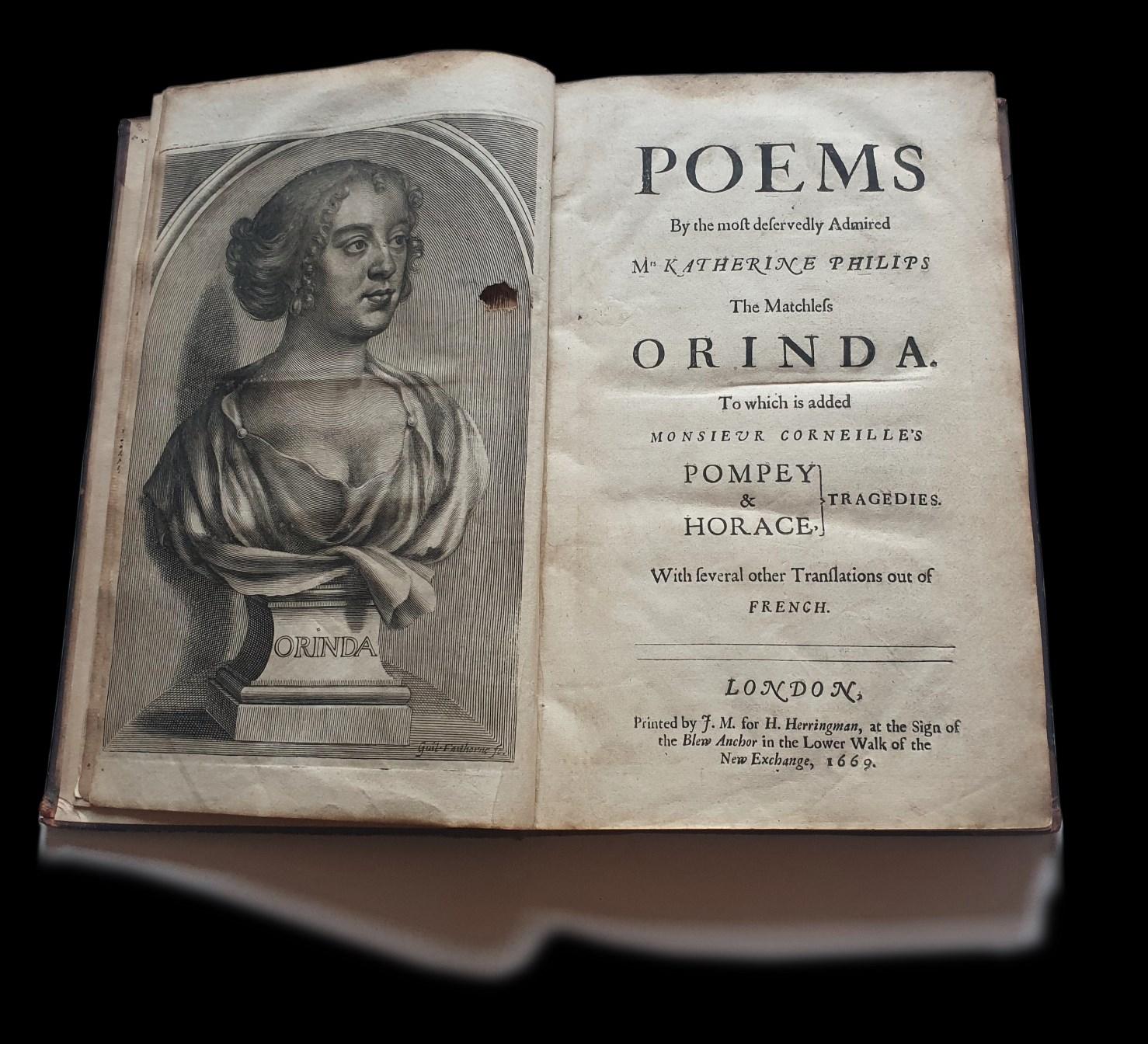
TEN
[CAMPBELL, John]. Manuscript entitled ‘Anecdotes relative to the Island of Jersey 1767’ and early ciphering book.

[Jersey. Circa 1770-79]. Quarto (195 x 160 x 12 mm). Dos-a-dos. Foliation Island of Jersey: [1, title and blank], 28 leaves (55 text pages); [Ciphering book]: 23 (several leaves excised, 39 pages of calculation and text). The two sections are separated by five blank leaves. Contemporary limp vellum, several slash marks to covers, amateur repairs (brown paper stuck to paste-down), horizontal cut to first three leaves of the ciphering section, neatly repaired.
¶ The Corn Riots of 1769 were a watershed moment in the history of Jersey, prompting a loosening of the semi-feudal conditions under which the Lemprière family had held sway over the island. Charles Lemprière and his brother Philippe had a monopoly of the judicial and legislative arms of government – Charles as Lieutenant Bailiff, Philippe as Receiver-General. The protests were centred on the repeal of a law banning the export of grain, which was seen as a ruse to create scarcity and thus increase the price of wheat; many Jersey landowners – foremost among them the Lemprières – stood to gain since the rents from their tenants were payable in wheat.
The acts of resistance that followed included the raiding by local women of a ship loaded with corn for export and an enmasse disruption of a Court session in which the protesters laid out their demands. Among these demands were that the price of wheat be lowered, tithes be reduced, and a range of oppressive fines and seigneurial rights be abolished. The Lemprières took their case to the Privy Council, prompting an investigation and, ultimately, the appointment of Colonel Rudolph Bentinck as Lieutenant-Governor. The ban on exporting crops was reinstated, and a Code of Laws in 1771 divided judicial and legislative powers between the States of Jersey and the Royal Court, ending the Lemprières’ monopoly.
This manuscript is a copy by “Ph: Carteret. R.N / Trinity” (as inscribed to the front free endpaper) of an extremely rare, printed book, Anecdotes relative to the Island of Jersey 1767, which describes events leading up to the unrest of 1769. Whether Carteret copied the text from another manuscript or from the published book remains unsettled. It was published anonymously in Southampton in 1773 at Southampton, and ESTC records only one surviving copy, at the British Library (Citation No: T92621). Among this handwritten copy’s points of interest is Carteret’s attribution of the previously anonymous work to “Col: John Campbell then Commander in Chief in the Island”.
From reading the text we learn that as commander in chief John Campbell played an active role in proceedings and had first -hand knowledge of events. He would have been ideally placed to report on them as, unlike most of the participants, he does not appear to have had any vested interest in the outcome and could provide something like an objective eye on proceedings.
ELEVEN
Philip Carteret (1733-96), a naval officer and explorer, was probably somewhat less objective. During a forced hiatus from the navy as a result of some bruising disputes with the Admiralty over the dilapidated state of a ship he commanded, Carteret returned to his native Jersey in 1770 to succeed his father as the seigneur of Trinity, “joining the rebels against the Lemprière family’s hold over the island” (ODNB). But why might he have wanted to make a copy of Campbell’s book –and why write it in an old ciphering book rather than start with a new, blank volume?
A possible answer to both questions lies in Carteret’s own situation between 1770 and 1779 (the period during which we assume the manuscript was written, since he left Trinity to take up command of another ship in 1779). According to the ODNB, Carteret left the navy in 1770 “with his health ruined and with scant reward from the Admiralty”, and moreover “he was left on half pay.” Since Trinity is known to have played an active role in the rebellion against the Lemprières, he may have wanted to find confirmation of a belief he already held about the Lamprières’ grip on power; or he may simply have wished to study the document in order to understand the situation better. In any case, it is exactly the kind of political text that would have engaged a man who had himself lately suffered from the heavy hand of aggressive authority. As to his use of his old schoolboy ciphering book, simple impecunity may well account for this decision.
His handwritten, contemporary copy of a very rare printed book speaks to the degree of feeling he – in common with his fellow islanders have felt about the situation; and his attribution of the work to John Campbell, which we have no reason to doubt, rescues a firstperson account of the events concerned from anonymity.
£1,750 Ref: 7896
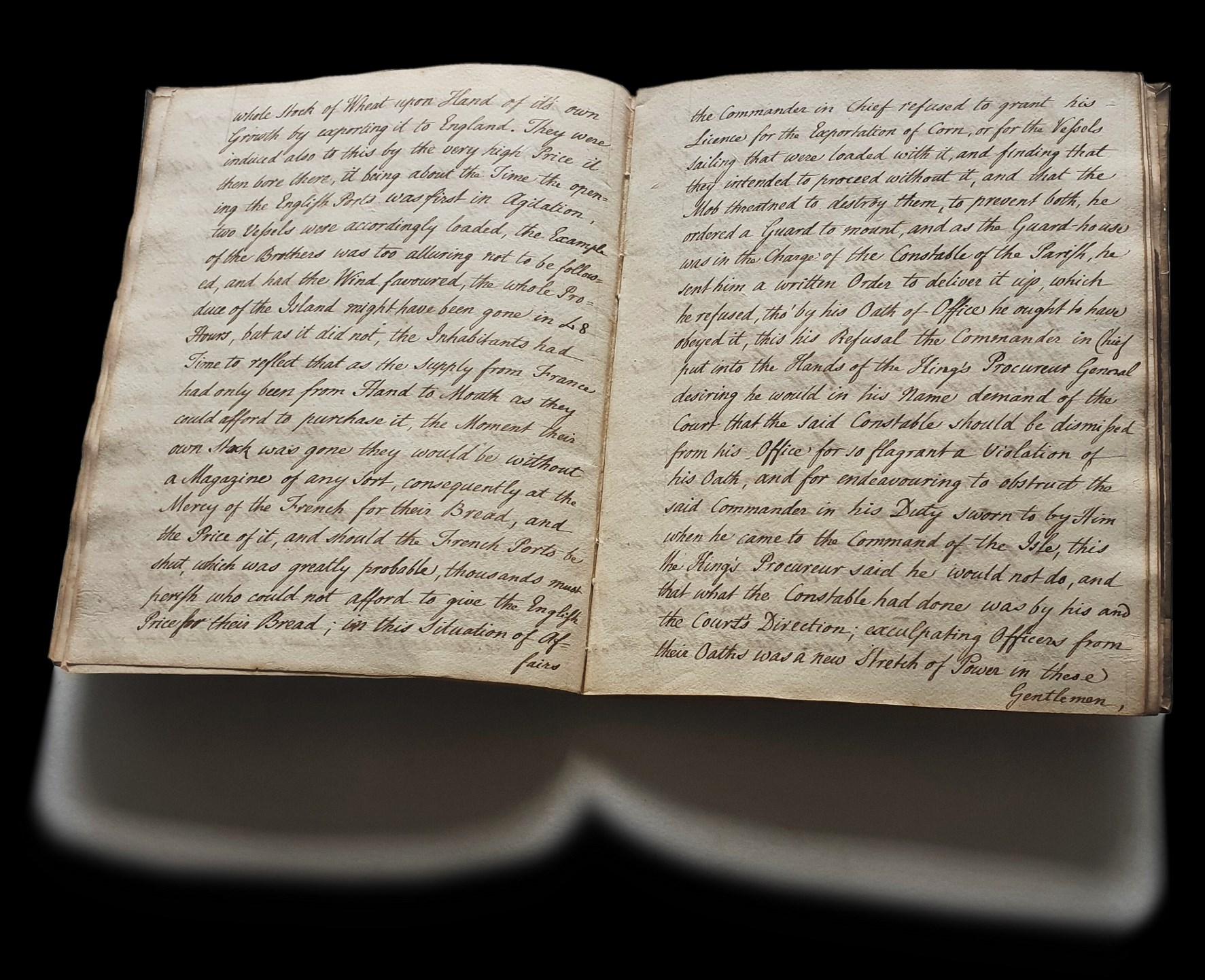
TWELVE
[RESTORATION SAMMELBAND] A collection of 12 rare 17th-century works, many relating to wine. London: 1690-91. Quarto. Later full sheep, rubbed and worn.
¶ This sammelband could almost be said to recreate the lively, argumentative atmosphere of a Restoration coffee house. It begins as a showcase for the work of the satirist Richard Ames (1664?-1692), whose comic poems included several on the subject of drinking and socializing: his Search after Claret sequence, contained here, laments “the declining quality of the claret served in London taverns” (ODNB), and elicited a parodic riposte, also featured here. But the collector of these works clearly had more than roistering on their mind: also included is the playwright Thomas D’Urfey’s political satire The Weesils a Satyrical Fable (concerning the furore over clergyman William Sherlock’s refusal to pledge an oath of allegiance to William and Mary), along with two works in response.
The sense of conversations and arguments raging within these covers is further amplified by the final three pamphlets. The first of these, Robert Gould’s A Satyrical Epistle to the Female Author of a Poem, call’d Silvia’s Revenge, &c. By the Author of the Satyr against Woman, is actually a riposte to a riposte, since Sylvia's Revenge, or, A Satyr Against Man (sadly not included here) was actually Richard Ames’ answer to one of Gould’s misogynist satires. The theme is continued with New Satyr Against Women and concludes with Ames’ more conciliatory
The Pleasures of Love and Marriage, a Poem in Praise of the Fair Sex. In requital for The folly of love, and some other late satyrs on women
All in all, the lively Restoration culture of disputation and public exchanges of fire on a range of topics is well represented in this sammelband, which appropriately also features Edward Ward’s pamphlet School of Politicks or the Humours of a Coffee House.
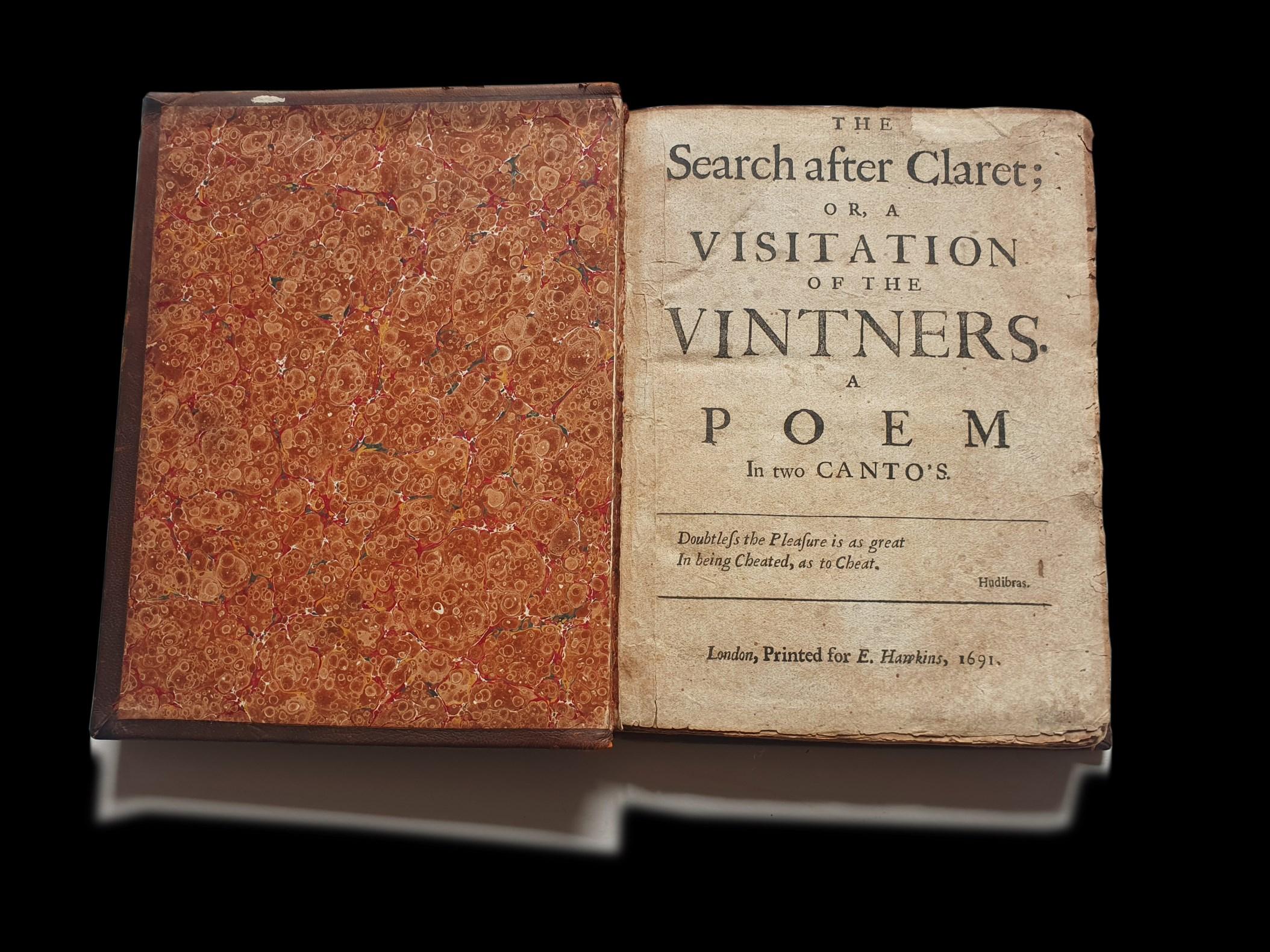
CONTENTS:
1.[AMES, Richard (1664?-1692)]. The Search after Claret, or the Visitation of the Vintners, A Poem. London, Printed for E. Hawkins, 1691. FIRST EDITION.
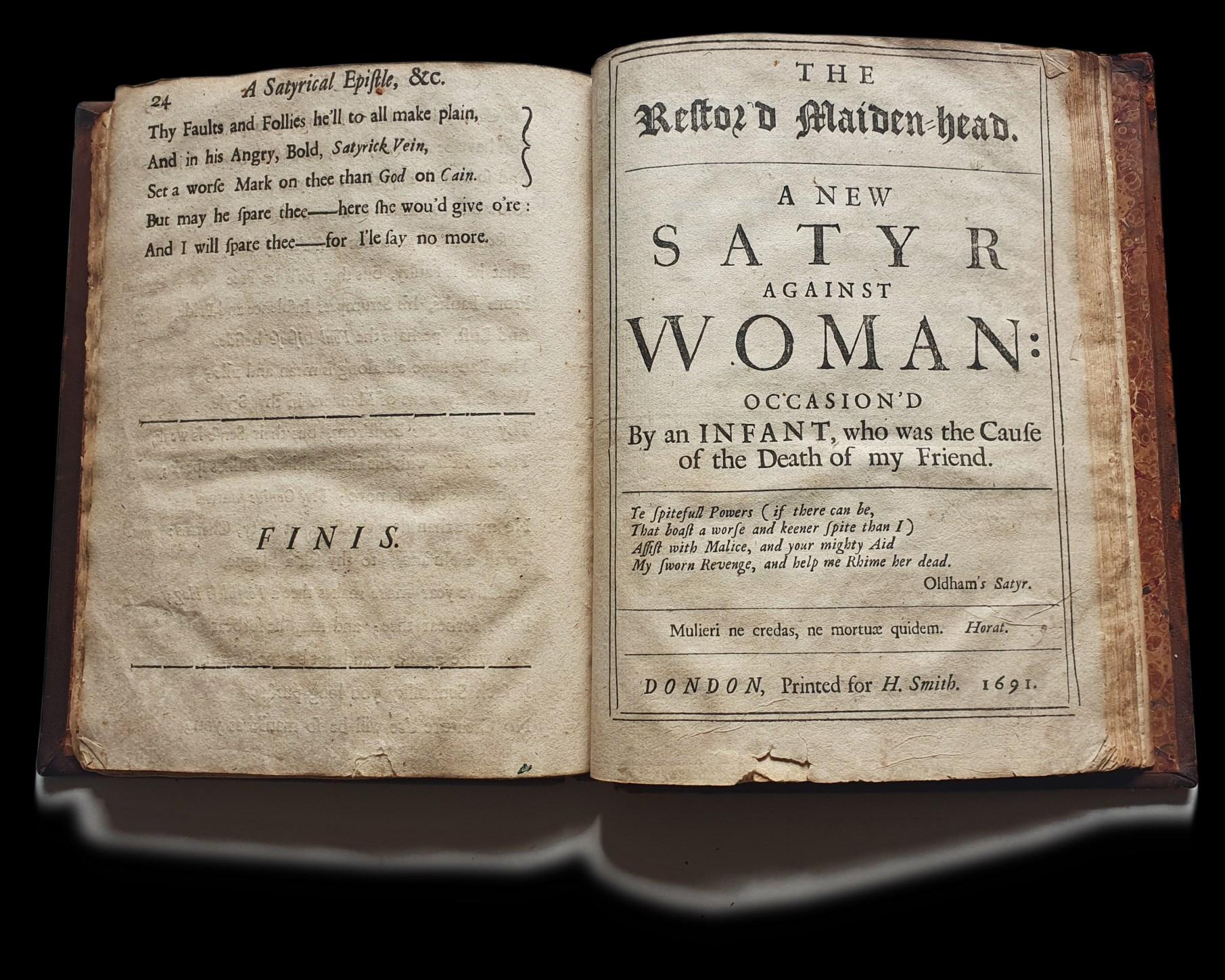
Pagination [4], 18, [2], complete. [ Wing A2989; Goldsmiths 2875; Kress 1754].
ESTC records 5 copies in the UK and 8 in the USA.
The dedication addresses “all Lovers, Admirers and Doters on Claret, / (Who tho' at Deaths-Door, yet can hardly forbear it)”.
2.[AMES, Richard]. A Farther Search after Claret, or a Second Visitation of the Vintners. London: printed for E. Hawkins, 1691. ONLY EDITION.
Pagination [4], 19, [1], complete. [Wing A2977; Kress 1752].
ESTC records 5 copies in the UK, 7 in the USA, and 1 in Australia.
3.[Under-drawer at the ’s-Head-Tavern in Gate-Street]. A Search after Wit, or a Visitation of the Authors in answer to The Late Search after Claret or Visitation of the Vintners. London: printed for E. Hawkins, 1691. ONLY EDITION.
Pagination [4], 19, [1], complete. [Wing A299.].
ESTC records 4 copies in the UK, 4 in the USA, and 1 in Australia.
4.[AMES, Richard]
The Last Search after Claret in Southwark or a Visitation of the Vintners in the Mint ONLY EDITION.
Pagination [4] 11, [1], complete. [Wing A2985; Goldsmiths 2784; Kress 1753].
ESTC records 4 copies in the UK and 7 in the USA.
5.[ANON]. The Triennial Mayor or the New Rapparees. London: printed for Will. Griffits, 1691. ONLY EDITION.
Pagination 1-7, 14-38, lacking pp31-2. [Wing, D2789A, ESTC, R2692]. In praise of Sir Thomas Pilkington. ESTC records 11 copies in the UK and 10 in the USA.
6.[WARD, Edward]. The School of Politicks or the Humours of a Coffee House, Second edition Corrected and much Enlarged by the Author. SECOND EDITION.

Pagination [2], 29, [1], complete. [Wing, W753B]. ESTC records 4 copies in the UK and 10 in the USA.
7.[D’URFEY, Thomas, (1653?-1723)]. The Weesils a Satyrical Fable. London: [s.n.], printed in the year 1691. FIRST EDITION.
Pagination [2] 12, [2], complete. [Wing, D2790B; ESTC R7901]. Well represented in library collections.
8.[ANON] A Whip for the Weesel, or a Scourge for a Satyrical Fopp. London: Printed for J. Norris, and sold by most book-sellers, 1690 [i.e. 1691?]. ONLY EDITION.
Pagination 8, complete. [Wing, W1673].
A reply to pamphlet [7]: Thomas D’Urfey’s The weesils. ESTC records 8 copies in the UK and 6 in the USA.
9.[ANON]. The Anti Printed and Sold by Randal Taylor, 1691. ONLY EDITION.
Pagination 16, 9 16, 9-15, [1], complete. [Wing (2nd ed.), A3516]. Another reply to pamphlet [7]: Thomas D’Urfey’s The weesils. Well represented in library collections.
10.[GOULD, Robert]. A Satyrical Epistle to the Female Author of a Poem, call’d Silvia’s Revenge, &c. By the Author of the Satyr against Woman. London: printed for R. Bentley, at the Post-House in Russel-street in Covent-Garden, near the Piazza’s, MDCXCI. [1691] ONLY EDITION.
Pagination 24, complete. [Wing, G1436].
ESTC records 2 copies in the UK, 6 copies in the USA, and 1 in Australia.
11.[BEHN, Aphra (1640-1689), attributed]. The Restor’d Maidenhead. A New Satyr Against Women : occasion’d by an infant, who was the cause of the death of my friend. Dondon [i.e. London]: printed for H. Smith, 1691. ONLY EDITION.
Pagination [2], 19, [1], complete. [Wing, R1177].
ESTC note: sometimes attributed to Aphra Behn.
ESTC records 4 copes in the UK and 8 in the USA.
12.[AMES, Richard] The Pleasures of Love and Marriage, a Poem in Praise of the Fair Sex. In requital for The folly of love, and some other late satyrs on women. London: printed, for H.N. and are to be sold by R. Baldwin at the Oxford-Arms in Warwick-Lane, 1691. ONLY EDITION.

Pagination [4], 18 [i.e. 26], [2]
The “Epistle to Stella” is signed: Astrophel. [Wing, A2987].
ESTC records 4 copes in the UK, 3 in the USA, and 1 in NZ.
SOLD Ref: 8150
THIRTEEN
VERNON, James; Summers. Manuscript
Letter-book Concerning the 1698 Treaty
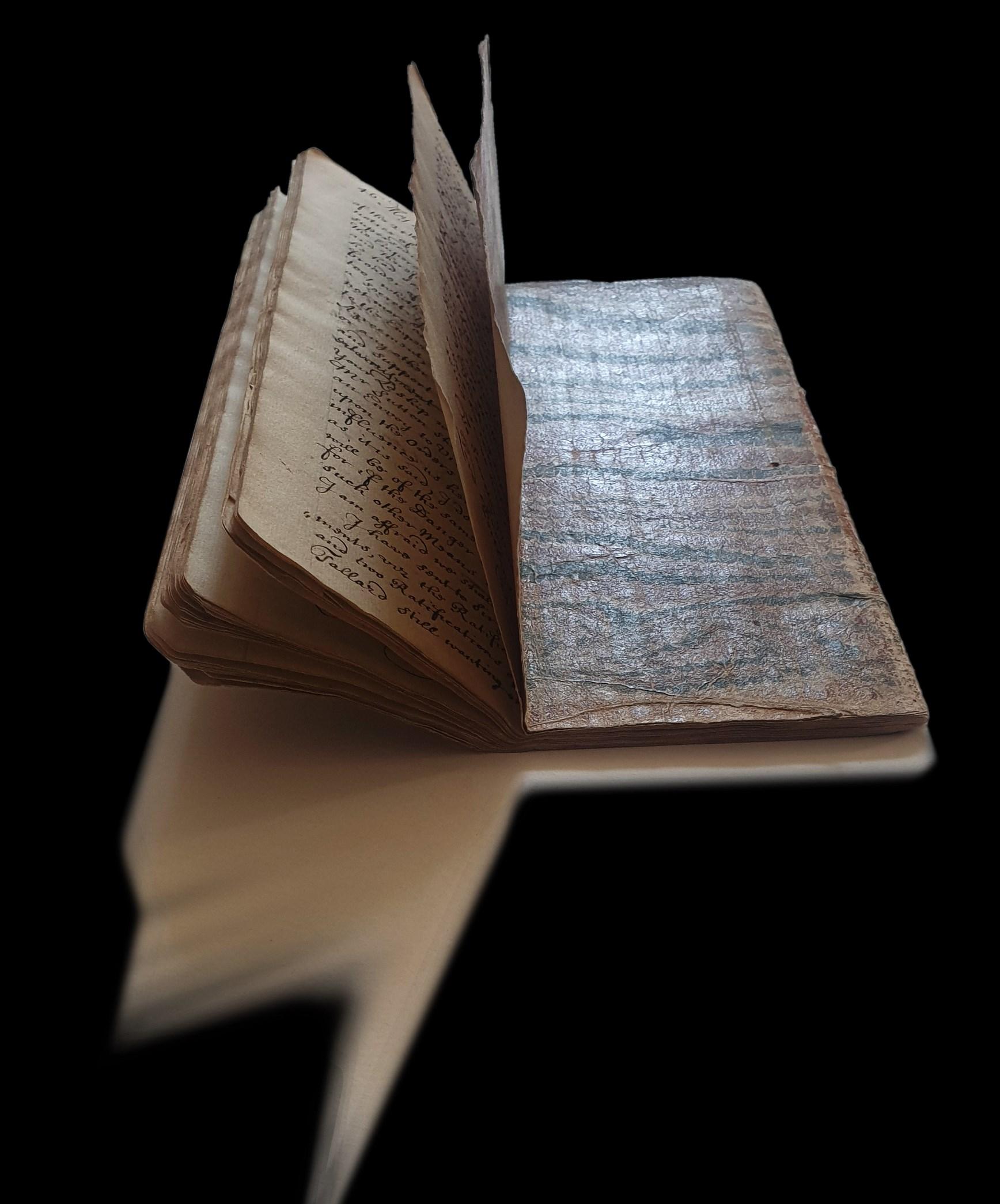
of the Hague.
[Circa 1698]. Small quarto (190 x 150 x 5 mm). 48 numbered pages on 26 leaves. Contemporary marbled wrappers, rubbed, small, neat repair to spine. Scattered spotting to text.
Watermark: Horn (similar to 17th century marks in Haewood, but with countermark of letter V inside an H).
Provenance: later ownership inscription of “Napier” to inner wrapper.
¶ This portable letter-book records some of the strenuous diplomatic efforts by Great Britain, France and the Dutch Republic to prevent war if the ailing and childless Charles II of Spain died. These and other efforts were in vain; but during 1698, when all the letters copied here were written, the select group of negotiators (which included King William III, his Secretary of State James Vernon, the Earl of Portland and the duc de Tallard) were progressing towards the drawing-up of the Treaty of The Hague – the first of two attempted treaties that proposed a partition of Spain’s possessions in Europe. Some of these letters appear in later published works including The History and Proceedings of the House of Commons (1742) others apparently, do not.
The letter-book begins in August 1698, when the two chief negotiators, Portland and Tallard, travelled to The Hague in order to complete discussions and draw up the treaty (Portland’s letters are sent from “Loo”, at The Hague). One might expect a book kept by a senior member of government to be a more impressive and prestigious object; but this is a small-format notebook whose air of basic functionality is strengthened by a vertical crease. The book, it seems clear, was folded for carrying, and it may well be that it was carried about in The Hague rather than in Whitehall – a geographical ambiguity that the unknown identity of the hand leaves unresolved.
The incremental steps of diplomacy and the preparation of the treaty are traced in these letters, which are mostly exchanged between Portland and Vernon. In an early letter, from King William himself to “Lord Chancelor Summers”, dated “15/25 August 1698”, the monarch stresses: “there is no time to be lost, and you must send me the full powers under the great Seal with the Names in blank, to treat with Count Tallard”. He emphasises secrecy, stipulating “that the Clerks who are to write the Warrant & the full powers may not know what it is”; and urgency, since “According to all intelligence the King of Spain cannot outlive the Moneth of October”. A few pages further on, we read Somers’ reply, from “Tunbridge Wells 28 August 1698” (in which Somers somewhat apologetically reminds the King that he had given him “Permission to try if the Waters would contribute to the Establishment of my health”). His response abounds in the kind of 17th-century realpolitik evident throughout these letters: echoing his colleagues in this book, he points out the “Deadness and want of Spirit universally in this Nation”, whose people are “not at all to be disposed to the Thoughts of Entering into a new Warr”.

As matters progress, the key players mull over the geopolitics of the treaty’s various provisions, the likely behaviour of the French, the uncertain political climate of Britain (Vernon to Portland: “We have a new Parliament and no body can make a ), the urgency of the situation (“Summer is almost gone, and the fall of the Leaf comes on, which is a dangerous season of the ) and the dubious prospects that any treaty will actually be observed (Portland to “I confess experience has showed us too plainly, that Treaties have been ill ). Besides the chief topic, other issues are raised and addressed to varying degrees: the plight of Sir William Jennings, a loyalist of James II now seeking a royal pardon; a petition from one “Col Codrington” that he succeed his father in the governorship of the Leeward Islands; “Mr Elrington who was a Prisoner in that he be granted a military post.
The treaty was signed in The Hague on 11 October 1698; the reasons for its failure, and that of the second partition treaty, are a matter of historical record, as Europe was plunged into another costly war. This letter-book preserves the correspondence between the key negotiators, and as an object which could be either shared or concealed, evokes the earnestness, urgency and pragmatism with which these failed attempts at peacemaking were pursued.

SOLD Ref: 8076 1.<http://www.spanishsuccession.nl/>

[HIGGINS, John (active 1570-1602)] A mirour for magistrates: being a true chronicle historie of the vntimely falles of such vnfortunate princes and men of note, as haue happened since the first entrance of Brute into this iland, vntill this our latter age
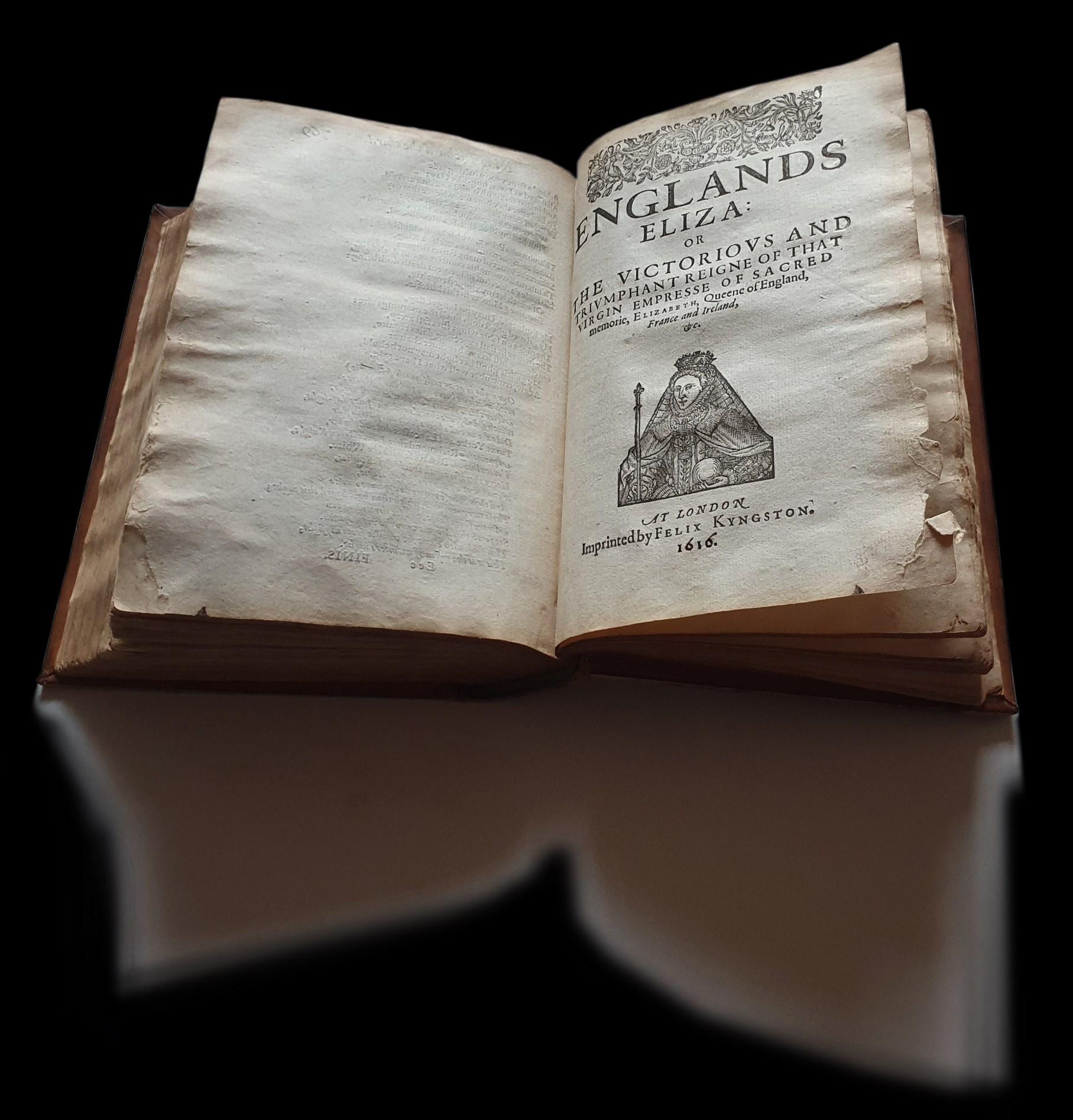
At London: imprinted by Felix Kyngston, 1610-09. Quarto. Pagination [20], 875, [1] p. Woodcut head-pieces, initials, and portraits within text. Collated and complete. Two verse dedications (Oo4 to Charles Howard, and Eee3) present, leaf Eee3 (Variant 3: cancel leaf signed “Nicols”), misbound after A4. [STC 13446; Pforzheimer 738].
Bound in later (probably 20th-century) panelled calf, first few leaves with small hole to blank inner margin, minor worming to first few gatherings, a few times touching text, a few closed tears, but without loss, some light damp staining and softening of blank margins of later leaves (Aaa with small loss to blank sections only.
Three of the four titles have their 1610 date neatly amended to “1616” in early ink manuscript (the 1609 date to ‘The Variable Fortvne’ has not been amended). We have not ascertained the reason for this. There was no 1616 edition of A Mirror for Magistrates, but the date coincides with the death of one of the book’s editors, Richard Niccols (15841616), and of William Shakespeare (15641616). 17th-century ownership inscription and purchase price to title page; “Ma: Weld pre 6d.8a.”
FOURTEEN
¶ A Mirour for magistrates, was an influential sourcebook for Elizabethan dramatists, including Shakespeare, who “was familiar with it and used the story of Queen Cordelia for some points in ‘King Lear’”. Also, to be found here is the story of Locrine, “which was used in the anonymous play of that name wrongly attributed to Shakespeare in the Third Folio”.1 The book is “a collaborative collection of poems in which the ghosts of eminent statesmen recount their downfalls in first-person narratives called ‘tragedies’ or ‘complaints’ as an example for magistrates and others in positions of power”.2
This is a complete copy of the first complete edition of edition collects all three earlier parts of Mirrour for Magistrates and adds ‘A Winter Nights Vision’ and ‘England’s Eliza’ (an account of the reign of Elizabeth I), written by Richard Niccols. Our copy is notable for having its cancel leaves present. According to Pforzheimer, “The general-title in all copies examined is a cancel, for what reason cannot even be conjectured. Originally A Winter Nights Vision had a dedication to Prince Henry, Sig [Oo4], but upon the death of that youthful patron of the arts that leaf was cancelled and a new one containing a dedication to the Earl of Nottingham inserted in its place. Evidently the substitution was delayed for most copies occur without any dedication.”3

1.Bartlett, Henrietta Collins. Mr. William Shakespeare, original and early editions of his quartos and folios; his source books and those containing contemporary notices, 1922. 277
2.<https://www.bl.uk/collection-items/a-mirror-for-magistrates-1574>
3.Jackson, William A.; Emma Va Unger. The Carl H. Pforzheimer Library: English literature, 1475- 1700. 1997. 738.
JUVENAL. The satires of Juvenal translated: with explanatory and classical notes, relating to the laws and customs of the Greeks and Romans. Annotated in an a contemporary hand.
London: printed for J. Nicholson, in Cambridge; and sold by C. Crowder, Paternoster-Row, and J. and F. Rivington, in St. Paul’s Church-Yard. [London], MDCCLXXVII. [1777]. Pagination xvi, 416 p. complete with the half-title. Contemporary mottled calf, rebacked preserving original spine.
Provenance: armorial bookplate of “Sir Thomas Hesketh, Bart. Rufford Hall, Lancashire.” Library shelf reference label to pastedown: “Easton Neston Library” (also a country seat of the Hesketh family). The bookplate is dated after 1761, when Sir Thomas was created Baronet. (A young William Shakespeare is thought to have performed in Rufford Hall for the entertainment of an earlier Sir Thomas Hesketh.)
¶ This parallel Latin and English edition of Juvenal’s ‘Satires’ (written during the Roman Empire) includes annotations that pointedly refer to the British Empire’s colonial territories in the West Indies.
Thomas Sheridan’s translation of Juvenal was first published in 1739; an early owner of this copy of a 1777 edition was evidently unaware of Sheridan’s authorship and has added “By Dunstan” to the title page, possibly thinking of Samuel Dunster, translator of Horace satires in the early 18th century. Whether our annotator is Sir Thomas Hesketh is uncertain, but he pasted in his bookplate in the last year of his life and the “Easton Neston Library” label dates from after his death.
The scribe has gone through the text and added notes, including short summaries at the beginning of each satire, as well as frequent underlining, occasional corrections to the text (both Latin and English), and notes on the meaning and context of some of the Latin words and phrases.
Our annotator draws out similarities with contemporary customs and culture: in Satire [II] (p.36), they have underlined “Dives erit, magno quae dormit tertia lecto” and added the note “This Line is applicable to his present Majesty the Baby King of Denmark with his late Queen & Count Halk” – likely a reference to Christian VII (1749-1808) who ascended the throne in 1766 aged 17 years.
One strand of annotations suggests an inclination to compare the Roman and British empires: commenting on Satire [XI] (p.308), they write: “The Romans, after they grew refined, affected the Greek as much as we do the French Language” –implying that the British have achieved a Roman level of refinement The scribe is keen to point out parallels in the classical text with the customs of the colonial West Indies: in Satire II (p 42), they have underlined “Et pressum faciem digitis extendere panem” and added in the margin below: “It is a Custom with some of the Ladies at Montserrat […] to retire for a fortnight to

FIFTEEN
refresh […] The discipline is exceedingly severe. They rub their faces over with ye oil of ye Cusso ^Cushoo nut. This lying on for a fortnight brings off all the skin of their face like a Mask, but if they smile, or distort their face in the least during this painful operation, they come forth horrid Spectacles.”
These anthropological asides occasionally betray a certain callousness: in Satire [VI] (p.174), on the line “Altior hic quare concinnus? Taurea punit”, the scribe underlines “Taurea” and adds a note: “perhaps a Bull’s Pestile, or a long Thong cut out off a Bull’s, or Cow’s hide & twisted up hard & taper in form of a switch. This kind of instrument is used upon the domestic Slaves by the Mistresses in the West India Colonies”. Clearly demonstrating that people in Britain were aware of the appalling treatment of enslaved people. Homophobia, too, is a feature, in the note to Satire [II] (p.28), which observes: “Here the Poet scourges the Hypocrisy, Effeminacy, & Bestiality of his Countrymen, as contradistinguished from the vilest & most libidinous Turpitude of Women. He is particularly severe upon that abominable intercourse between the male Sex. Which was highly fashionable.”
If our annotator displays some of the common prejudices of their era, they also indulge in some satirical jabs of their own. Against a line in Satire [III] (p.54), “Res hodie minor est, here quam suit, atque eadem eras. Deteret exiguis aliquid” (“since my means are less today than they were yesterday, and tomorrow will rub off something from the little that is left”), they observe drily (if cryptically): “An admirable picture of England in 1779”.
SOLD Ref: 8065

[ROW, George; ROQUE, Jean] Le Petit Atlas Britannique with manuscript notes in an 18th-century hand.
[1753]. Octavo. Letterpress title page in French and 47 (presumably only of 54 double-page maps engraved maps). The maps are hand-coloured in a contemporary hand. Manuscript notes to some pages and a nine-page account entitled “Capture of the Alexander”, which is written in the same hand as the scribe “George Row” (see provenance).
Early 19th-century straight-grained morocco, rubbed and worn, several leaves loose.
Provenance: inscription to the reverse of the map of Essex: “George Row on board the Syren / off Flushing in the river scheld / January 25 : 1793”
Inscription to reverse of Oxfordshire: “Richard Stroud His Hand 1799”. Inscription to title page: “W. Tollmach”. The Tollemaches were earls of Dysart; of Ham House and Helmingham Hall, Suffolk.
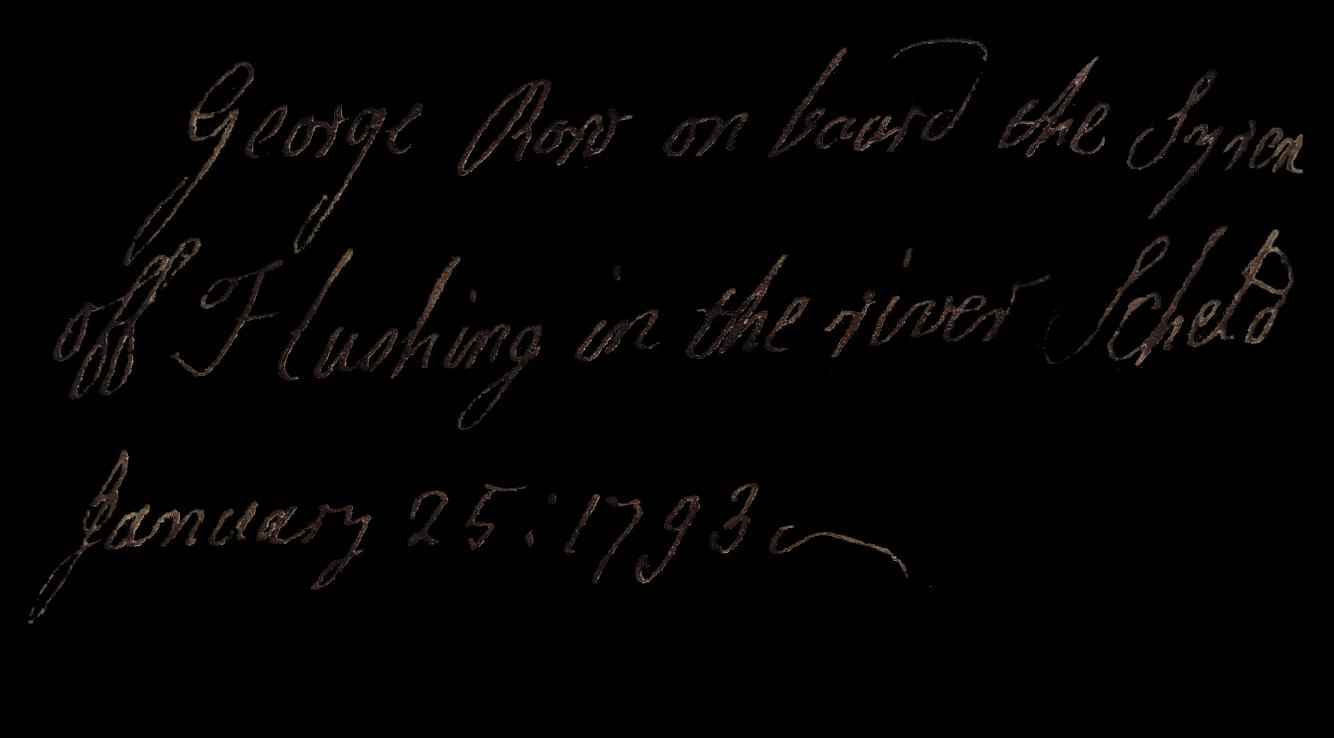
A rare atlas: ESTC locates three copies of the 1753 edition (Cambridge University Library, National Library of Ireland, and Bibliothèque Mazarine, Paris) and one copy of the 1762 at the Bodleian.
Both recorded editions of the Rocque’s atlas have engraved, parallel English and French title pages. In the 1753 edition, 42 of the 54 maps are numbered and all 54 maps are numbered in the 1762 edition; whereas our copy has only a French title page in letterpress and none of its maps are numbered.
¶ There are two recorded editions of Jean (or John) Rocque’s Le Petit Atlas Britannique: one published in 1753 and one in 1762, both in London. As noted above, there are very few surviving copies of either, but what makes this copy all the more unusual is, first of all, the letterpress title page, of which we can find no other examples; and more significantly, the manuscript addition of a remarkable 1,150-word, first-hand account of a naval encounter in November 1794 that led to the capture of HMS Alexander by the French navy.
The author of this nine-page eyewitness description declares himself in an inscription to the reverse of the map of Essex: “George Row on board the Syren / off Flushing in the river scheld / January 25 : 1793”. After Flushing, he next plots his location as “Syren off Spain Monday 3 June 1793” (on a blank page shortly after the title page); by the next year, he was evidently serving on the HMS Canada when it was returning from Cape St. Vincent in company with the Alexander and the two warships became involved in a skirmish with a French squadron of five line-of-battle ships, three frigates, and a brig.
SIXTEEN
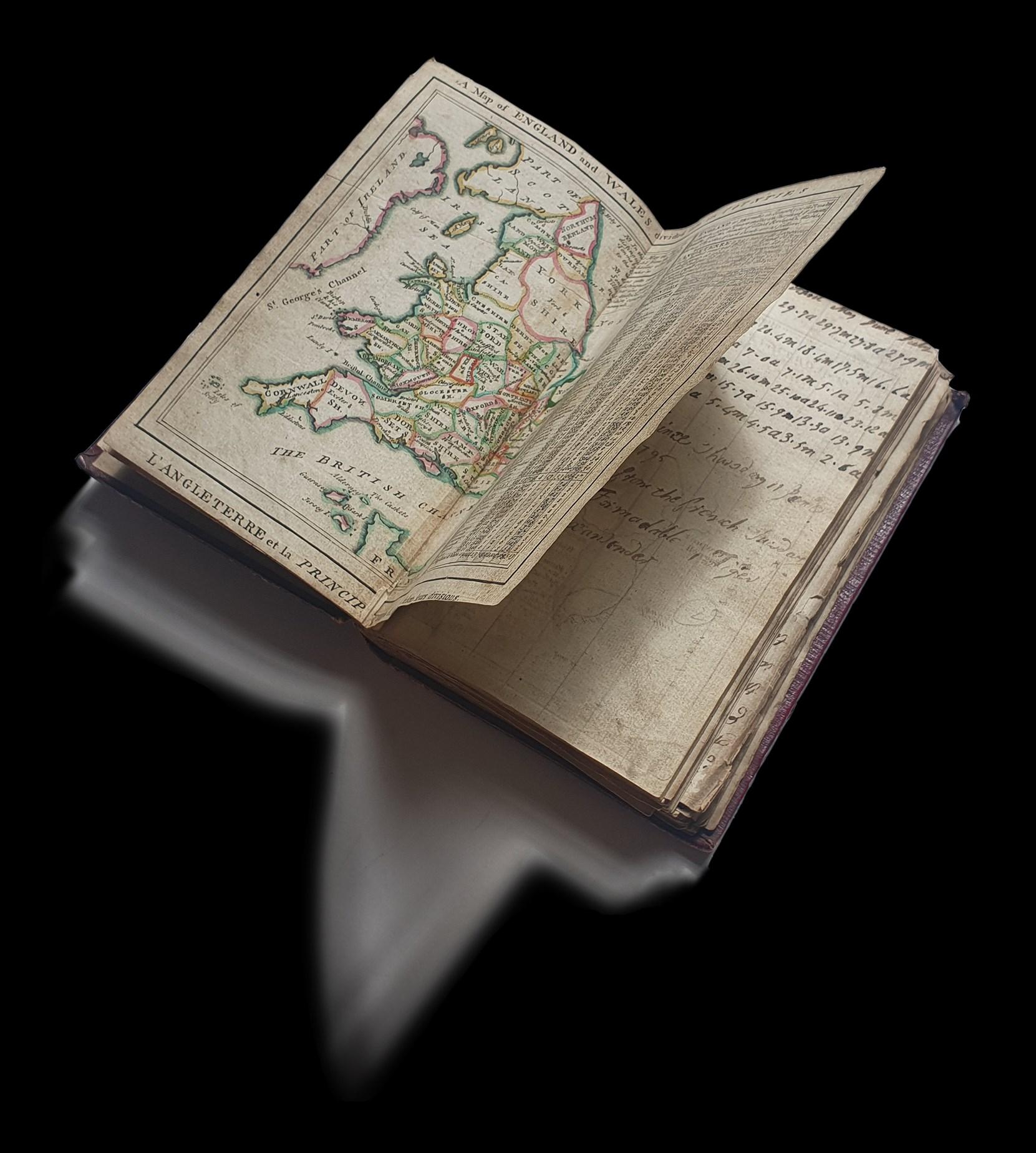
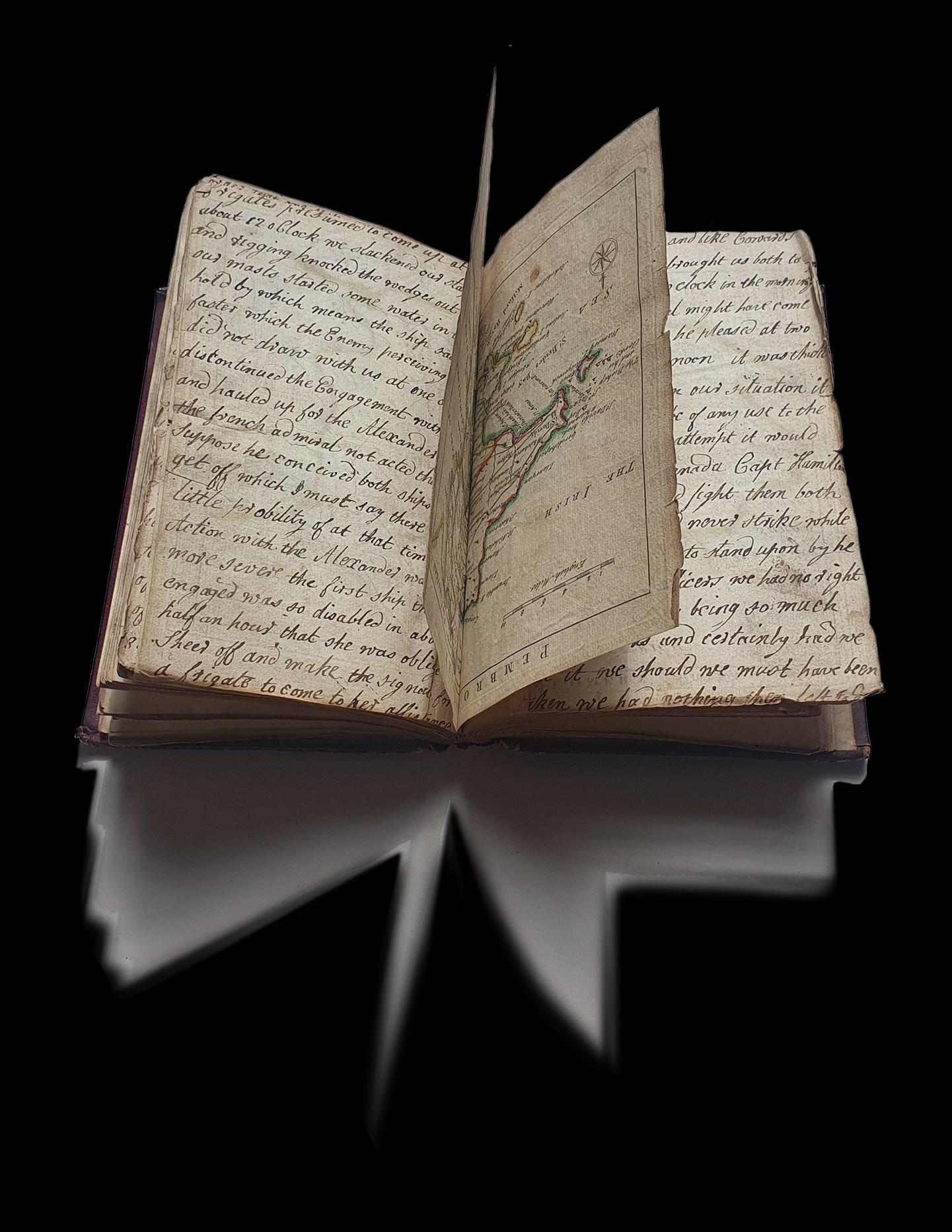
Row makes a series of apparently arbitrary decisions as to where to add his account: he chooses to flip the volume upside down and to begin writing on the reverse of “Isle of Wight”, continuing to “Merioneth Shire and Montgomery Shire” – neither of which are geographically very close to the site of the action that he unfolds.
He describes how “the Alexander of 74 Guns and our Ship of the same force”, having helped escort a convoy “ as far as Cape of St Vincent”, was returning to England “when about six [ ]ive Leagues to the Westward of Scilly at [t]wo clock in the morning of the 6th of this month we fell in with a french Squadron men of war”. Despite “masterly manoeuvring” by both ships, “the Enemy were of so Superior force it was thought necessary to separate” in order to split their pursuers. But in due course, Row relates, the French admiral “in the most dastardly manner hauled up for the Alexander being we imagine determined to make sure of one ship I say dastardly because if three heavy line of battle ships could not secure the Alexander he ought never to have gone to their assistance and should himself have chased us” – a breach of maritime etiquette, evidently.
Row speculates that “had we fortunate had a nother line of battle ship I believe we should have beaten them for the French handled their so bad and like Cowards”. After the enemy’s unprincipled pile-on, and having dismissed the idea of going to the Alexander’s aid against overwhelming odds, “we had nothing then left to do but to make the best of our way to England”. The manuscript is inscribed at the end “Canada Novmb. 6th 1795”. The date is perplexing because the Alexander was captured a year to the day earlier, on 6 November 1794. Our assumption is that this is a simple misdating because there is no obvious reason why he should be recounting the events of a year ago, nor would he have been compiling his account to be given in evidence: the court martial of the commander of HMS Alexander, Admiral Rodney Bligh was conducted on 25 May 1795. The court found in his favour, and he was honourably discharged.
Whatever the reason for the slightly puzzling date, and the atlas’s confounding publication details, Row’s narrative makes for compelling reading and attests both to the conduct of Bligh and to the impact of the events on the young able seaman.
SOLD Ref: 8160

[CROSBY, Dixi (1810-1876); HALE, Safford Eddy (1818-1893)] Manuscript lecture notes taken by Safford Eddy Hale at Dartmouth Medical College in Hanover, New Hampshire, on venereal disease and urology, from lectures delivered by Dixi Crosby in 1840. [Circa 1840.] Half calf, marbled boards, rubbed. Small quarto (207 mm x 180 mm x 22 mm). 240 (numbered pages), [2, index].

¶ These lectures were almost certainly delivered by Dixi Crosby, who was professor of surgery, obstetrics, and diseases of women and children at Dartmouth Medical College when Hale was enrolled. Crosby had been appointed chair of surgery there in 1838. “He dominated New Hampshire surgery for thirty years. His practice in Hanover was very large, many patients being attracted by the high reputation of the school, while the personal ability of the man spread far around.” (Kelly Burrage, Dictionary of American Medical Biography. pp. 268-270). Crosby was the first surgeon in the United States to be sued for malpractice, though he was found not guilty.
An inscription to the front endpaper reads “S. E. Hale / Elizabeth Town / N. York”. Safford Eddy Hale was born in Chelsea, Vermont and attended Dartmouth Medical College graduating in 1841 and setting up a practice in Elizabethtown, New York the following year. He served as secretary of the Essex County Medical Society for several years and as its president for a term
The subject headings include hydrocele, diseases of the breast, irritable swellings of the breast, diseases of the testicles, fungus hematodes, chronic enlargement & abscesses of the testes, gonorrhea, stricture of the urethra, abscesses of the lacunae, spasmodic strictures, inflammatory strictures, irritable bladder, bleeding from the urethra, inflammation of the testicle, impotence, sympathetic bubo, gleet, gonorrhea in females, chancre, phymosis, chancres in females, bubo, secondary symptoms of the venereal diseases, venereal disease of the bones, venereal ophthalmia, of the effects of mercury, scrofula, and scrofulous enlarged glands, among others.
£650 Ref: 7907
SEVENTEEN
[CULINARY RECIPES] Early 19th-century manuscript book of culinary recipes.

[Circa 1810]. Quarto (204 x 70 x 17 mm). Approximately 97 text pages (of which 11 are pasted in recipes), 12 blank leaves. Vellum-backed marbled boards. Stitching broken, text block loose in biding. Boards heavily worn, some spotting to text.

¶ A note to the front paste -down reads “My Mother’s approved receipts” but this notebook is written in multiple hands. managing a household are written from the back. Recipes include “Shrewsbury Cakes”, “India Pickle”, “Fruit Acid” and “Diamond Cement” The volume also contains calculations for budgeting and managing a household, such as a sum for “the value of 152/2 Gallons of Brandy”. Dispersed throughout the calculations are a few household recipes, such as one “For French Polish”. The recipes have clearly been used, with those found unsatisfactory crossed through or labelled “Bad Bad”. Most of the recipes are unattributed, but a few are meticulously attributed to on the Art of making Wine by Macculloch 2d Edition”, complete with the publisher’s details.
£400 Ref: 8138
EIGHTEEN
[JONES, Sarah (1768-1849); EDEN, Arthur (1793-1874)] A collection of correspondence addressed to Arthur Eden.
[Circa 1807-1813]. 65 letters, a few octavo, but mostly quarto. Folded for posting, some with address panels, and a few with seals.
¶ This collection comprises correspondence to Arthur Eden (1793 1874), later to become Assistant Comptroller of the Exchequer and Deputy Auditor of Greenwich Hospital. He lived with his second wife Frances Baring at Harrington Hall, Spilsby, the inspiration for “the Eden where she dwelt” in Tennyson's poem ‘The Gardener’s Daughter’.
The largest portion of this collection is the correspondence from his aunt, Sarah Jones (née Webber) (1768-1849), whose engaging collection of 37 letters run to some 140 pages. Sarah Jones married into a Welsh family and has the dubious honour of being the likely inspiration for James Gillray’s satirical print, “Venus a la Coquelle or the Swan-sea Venus” of 28 March 1809. This parody shows “a middle-aged sea-green block of a woman” driving her sea-shell chariot across the waves. – supposedly an allusion to Jones’ public profile as “a celebrated whip, frequently seen in Hyde Park who made herself elegantly conspicuous by driving about in a smart chaise and pair”.
In this series of letters, written in a clear hand, Sarah dispenses news and advice to her nephew. The earlier letters are addressed from “Belle Vue” (c.1807-9) and afterwards from “Hill House” in Swansea (c.1810-3). She touches on domestic topics including her dogs, her husband’s hunting, and news of friends, neighbours and family (such as “the sudden Death of Mrs Dixon who apparently in perfect health dropped off her Chair whilst at Dinner on Wednesday last & instantly Died”); after her move to Wales, she sometimes describes both dogs and children as “Rustics”. She often seems beset by melancholy (“I suffer’d materially in my health & spirits by great Anxiety & Afflictions two years since & I lost much of my good looks”) and preoccupied with the bad health of her husband (“my whole time has been taken up in nursing him”), but often articulates her thoughts with a certain liveliness (““Thinks I to myself”, Arthur is very angry with me”).
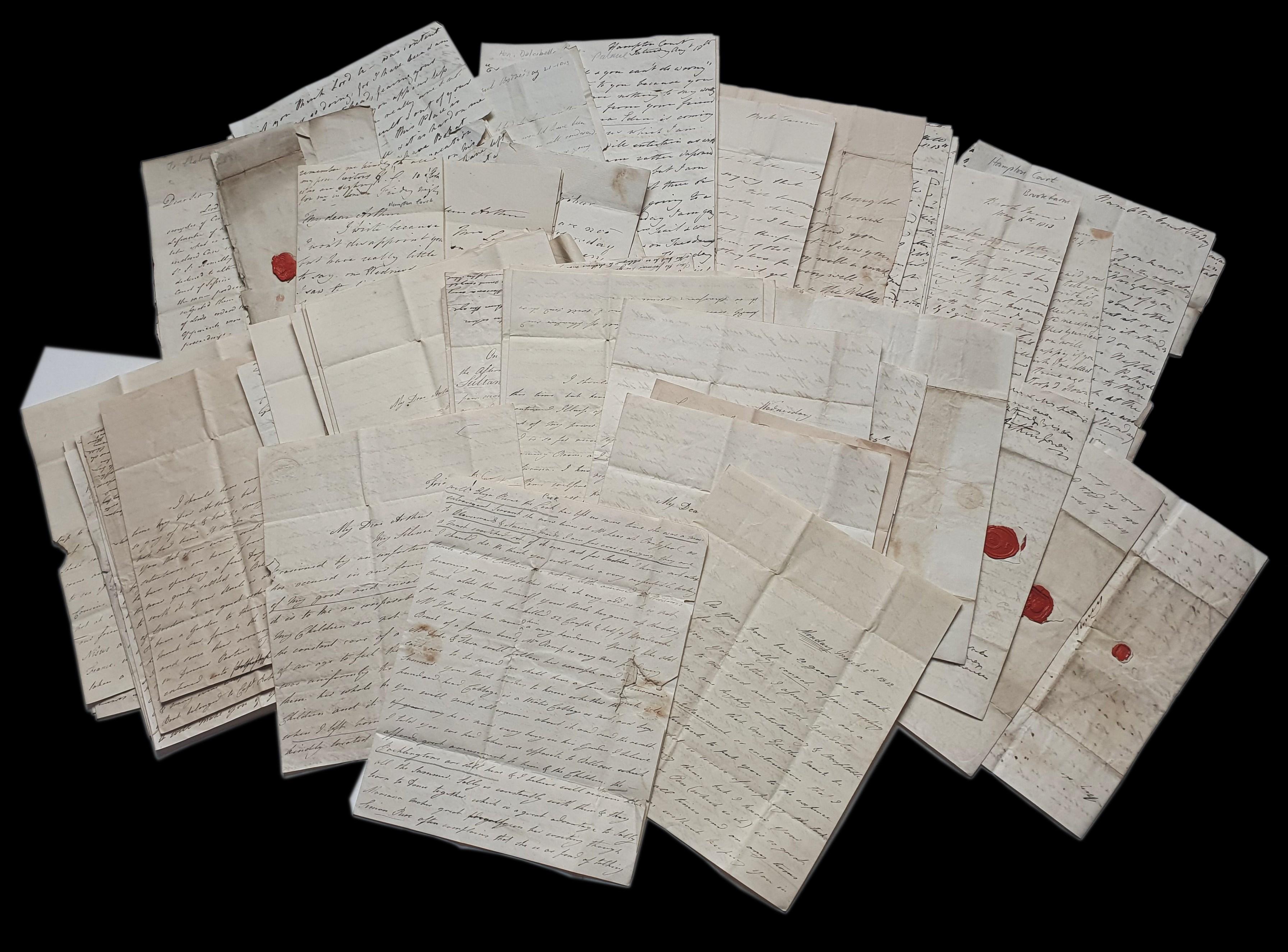
NINETEEN
Sarah is particularly exercised by troubles with servants: “Our man William Edwards”, she reveals, “turned out a great rogge”. She goes on to recall that “we placed so much confidence in him that he managed every thing in the way of Marketing, Bees, Coals, &c in every article of which he cheated us most grosly, nor did he content himself with this but he used to fill his Pockets with Bread Meat &c” and “Eliza Pierce the Cook has left us some time she was a most extravagant Servant she now ). In another letter she mourns “the Death of my good and invaluable Servant Sudden […] an “3 youngest Children”, who “still fancy she is Ill in the House”.
If this collection is anything to go by, Sarah’s husband, Arthur Jones (1768-1842) was a less frequent correspondent. He contributes four letters, which also cover domestic matters (especially their dogs), but with less vivacity than his wife, and in a comparatively untidy hand.
There are also 25 letters to Arthur Eden from his side of the family, including 10 from his sister, Lady Dorothy (Dora) Moore (née Eden) (c.1790-1875), whose emotional openness is often on display. She tells her brother:

“I have suffered a great deal since I last wrote to you […] If I don’t give vent to my grief my heart bursts, you will imagine my sufferings”. Her deeply felt experience of life has its consolations, as for example when she declares: “I think it is impossible for any body to love another better than I do Graham […] I sometimes think of him with wonder that a man can be so perfect”
Dora is well read, judging by her reference to Adam Smith’s idea of the “impartial spectator” or “man within” which is central to the philosophy in Theory of Moral Sentiments. She writes: “I am very sorry that you d d(?) with Eliza however the wisest cannot always command the impulse of the moment. & I & you “the man within” will forgive you if you promise us not to ere again. I like that expression of Smith’s “the man within” it is so expressive, there is something so dignified in it [...] there can be no real misery when the “man within” is satisfied”.
These letters represent one part of an extensive social and familial network, and give a more realistic portrait of Sarah Jones than the imperious figure parodied by Gillray. Moreover, since we have no corresponding replies from their recipient, the voices are predominantly female, a fact that nicely upends the usual state of affairs in matters historical.
£1,750 Ref: 8114
TWENTY
ELIOT, John (1735-1813). Two 18th-century manuscripts, comprising letter books and accounts [Circa 1780-88]. Folio and quarto volumes. Contemporary, green-stained vellum bindings.
[1]. [ELIOT, John]. Manuscript fair copies of “Letters from several friends to Philip Eliot” and a Collection of Journeys. [Circa 1780]. Folio (243 x 195 x 25 mm). Contents page and approximately 140 text pages (numbered to p.96), followed by 16 blank leaves.
Green vellum, initialled “J E III” in manuscript to front board. Written in the same neat, clear copper plate hand. Watermark: Fleur-de-lis above GR; countermark: C Taylor. (Haewood 1856, except countermark: I Taylor).
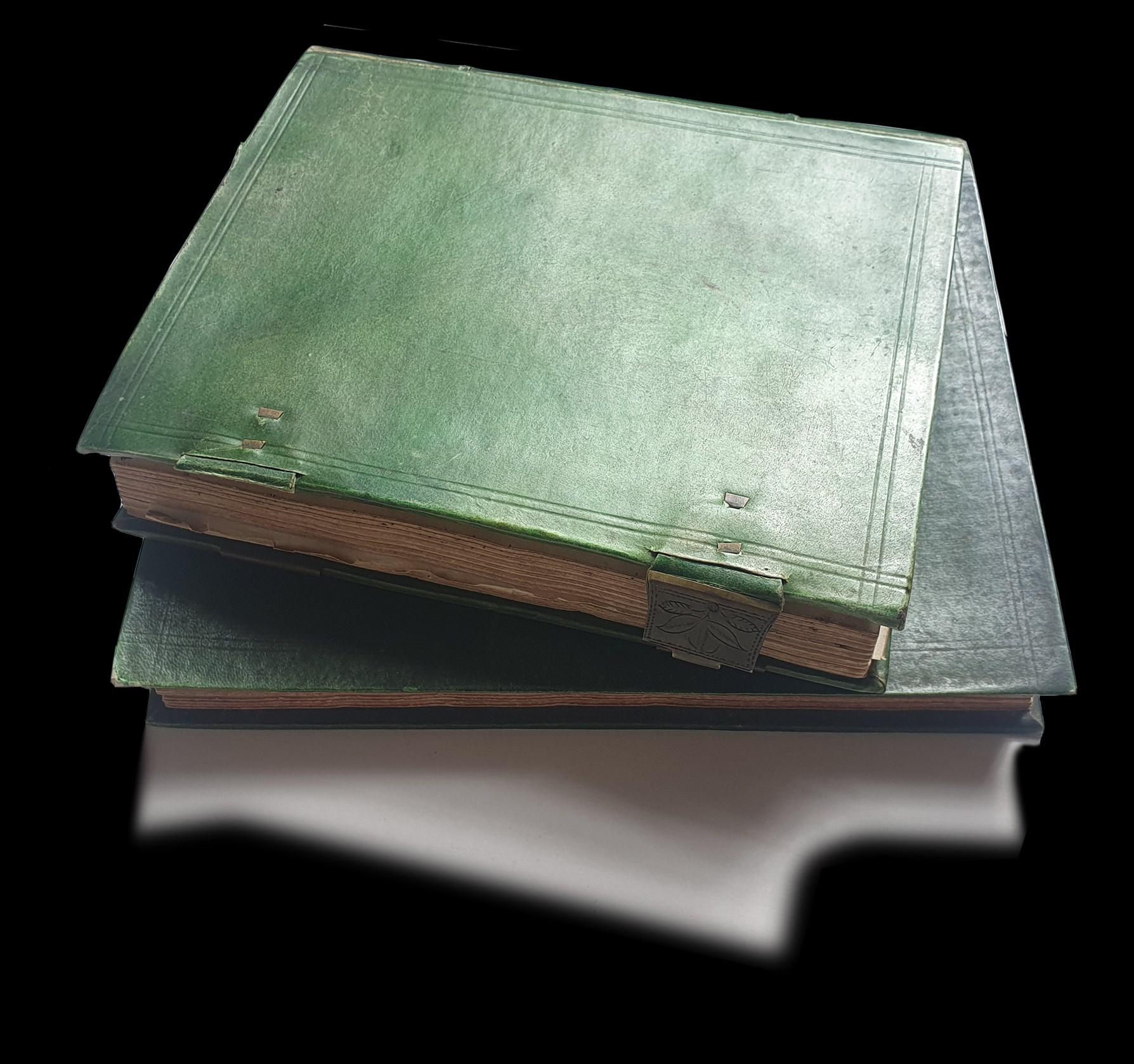
John Eliot’s manuscript fair copies of letters and accounts of journeys sent by Friends to his uncle, Philip Eliot between 1750 and 1779. Copies of 12 letters from correspondents including “James Gough”; “Claude Gay” (“While I was in France, I wrote to Friends of the Meeting for Sufferings, chiefly on Account of our few Friends in Jersey”); “Thos Whitehead”; and Accounts of journeys include those “to Friends in Holland. (The 7 of the 7th Month 1770)”
Portsmouth, Gosport & the Isle of Wight in 1779”
York Quarterly Meeting
[...] 22nd of 6th Mo: 1774”; and “to Thomas Whitehead at Reading. 16th of 3d Mo: 1771”
Also copied is “Some Account of Samuel Emlen & Tho Thornborough’s taking Shiping for America. 1772”
[2]. [ELIOT, John (1735-1813)]. Manuscript Letter Book and Accounts. [Circa 1784-89]. Quarto (208 x 164 x 30 mm). Text arranged dos-a-dos. Letter book: approximately 170 text pages; and approximately 60 pages of accounts (together 230pp, excluding a few blanks). Some pages excised at each end.
Green vellum, one clasp intact. Ruled in red for accounts. Probably a stationer’s book. Text and accounts written in the same neat, clear italic hand. Watermark: Pro Patria above GR. Manuscript inscription stuck in to paste-down: “Gulielma Briggins her book March 1734”. There are no other entries by her. The paper has a different watermark to the rest of the volume and has evidently been inserted, probably by Gulielma’s nephew and the compiler of this volume, John Eliot.
The manuscript compromises copies of over a hundred letters to and from John Eliot (correspondents are mainly Quakers, including Thomas Shipley, Ann Arch, John Trehawke, John Chamberlain, James Upjohn) between 1784 and 1789, together with his financial accounts for the years 1784 to 1788.
¶ 18th-century Quaker merchants stood in marked contrast to most of their peers. While so many of their fellow countrymen became rich through the slave trade, Quakers not only repudiated participation in the trade, but actively worked to achieve its abolition. Their development of ethical business practices, which grew out of their close connections, provided a model for English traders who preferred to see themselves as having ushered in the Industrial Revolution through sheer hard work and sound morals, rather than admit that the country had grown rich – directly and indirectly – through the trade in the lives of enslaved African men and women.
The characteristics which informed the Quakers’ sense of identity – morality, abolitionism, charity, and a pragmatic approach to business – are evidenced throughout these manuscripts. Indeed, the letters move easily from one theme to the next, as when John Eliot writes to Thomas Shipley (who appears to be managing his farming business) in February 1787 to confirm that “M. Birkbeck shall have the Sheep”, but “when the Sheep are in good Condition, or it may make a considerable Difference in the Price”, and in the next paragraph directing that “my Reason for refusing to pay Tithes in general may be shewn to the Justices, hoping thou will attend them on this Occasion” (Quakers rejected the authority of the Anglican Church and consequently refused to pay tithes).
Money frequently figures in Eliot’s deliberations, whether over his own finances (including rents from lands), gifts of money for poor people (such payments are sometimes recorded in the accounts section e.g. “Salkhill for poor’s rate”), and his sense of responsibility towards them (“Now there seems to me a Debt due to the Poor of these Places whence we derive our own Profits and Adavantages” [1789]). He can often be seen advocating for fairness in business dealings (“As to thy settling with

thy undertenant […] & thy private dispute with him, it has no Relation to thy Engagement with Danl Stephenson who ought to be paid notwithstanding”), and it’s a rare letter that has no mention of sums of money; but he is equally concerned to pursue religious and domestic matters, and is keen to contribute to the establishment of new schools.
John Eliot was the son of John (1707-1735) and Mariabella Eliot (née Farmborough Briggins) (1708-1747). He married Mary Weston (1743-1812), and they had four children: Mary, Mariabella, Ann, and John 1. He was a Quaker minister, an underwriter at Lloyds of London, a landowner, and a merchant – a diverse portfolio that chimes nicely with the impression in the letters of a man practicing faith and finance with equal commitment.
This, in turn, reflects the way in which Quakers’ strong moral beliefs and their network of close family and social bonds created a community of Friends – trusted individuals with whom they could trade. Such relationships were crucial for successful Atlantic commerce, as Friends in Britain could rely on the honesty of their colleagues in America, notably Pennsylvania, which was founded by the English Quaker, William Penn (1644-1718).
Eliot is a key player in an international network that includes Friends in France, Holland, and – most importantly – America. He keeps track of the comings and goings of various American Friends, writing in one letter [to ?]: “I heard that Ann Jessop one of the last friends from America was in your Neighbourhood [...] I had a Letter from Saml Emlen by the same Ship”; and in another, “Five of the American Friends have taken their passage in a Vessel bound to Philadelphia to sil soonviz: W. Matthews, Z. Dicks, A Jessop, P. Brayton & R. Wright. Did I mention to thee John Storer and T. Colley were returned?”. His attention, naturally enough, is directed keenly towards Pennsylvania, of which he writes that “there is not an Acre of Liberty Land vacant, and that the most valuable City Lots are sold”. The concept of “Liberty Land” was an important aspect of the colonisation of Pennsylvania: “William Penn had made a gift of land in these sections to the first purchasers of lots in the city proper, the amount of “free” land given being in proportion to the amount of “town” land that was bought. The term, “City and Liberties of Philadelphia,” was commonly used in the early days of the province”. 2
Eliot’s zeal for abolitionism is strongly represented in the letters: he writes, in one dated “London 12/1 1788”: “Our Society intends to petition Parliament again to abolish the Slave Trade, and we are requesting our fr[ien]ds in the Country to apply to such members of Parliament with whom they may be acquainted for their support of such a Petition or of any motion that may be made in the house for an enquiry into the African Slave Trade”; and again, on “31 of 1 Mo 1788”: “the Committee appointed about Cranbourn Chase think to bring forward a Petition to Parliament [...] I expect Friends will very soon apply to Parliament on behalf of the Negroes”. The dates are significant, since this activity was part of a concerted campaign in 1778, when one hundred such petitions were presented to Parliament in the space of three months.
Eliot also busies himself with the important work of transmitting the Quaker message as effectively as possible, and not just in English: in a letter to “J de Marcillac”, he assesses the translation of Mary Brook’s (c.1726-1782) Reasons for the Necessity of Silent Waiting (1774) “into French by Claude Gay” as “not so well done” and consequently, “I send thee enclosed a Specimen thereof in French and English. If thou wilt please to try to render it into a better style [...] The intention of the Friends is to print a new Edition of this book”.

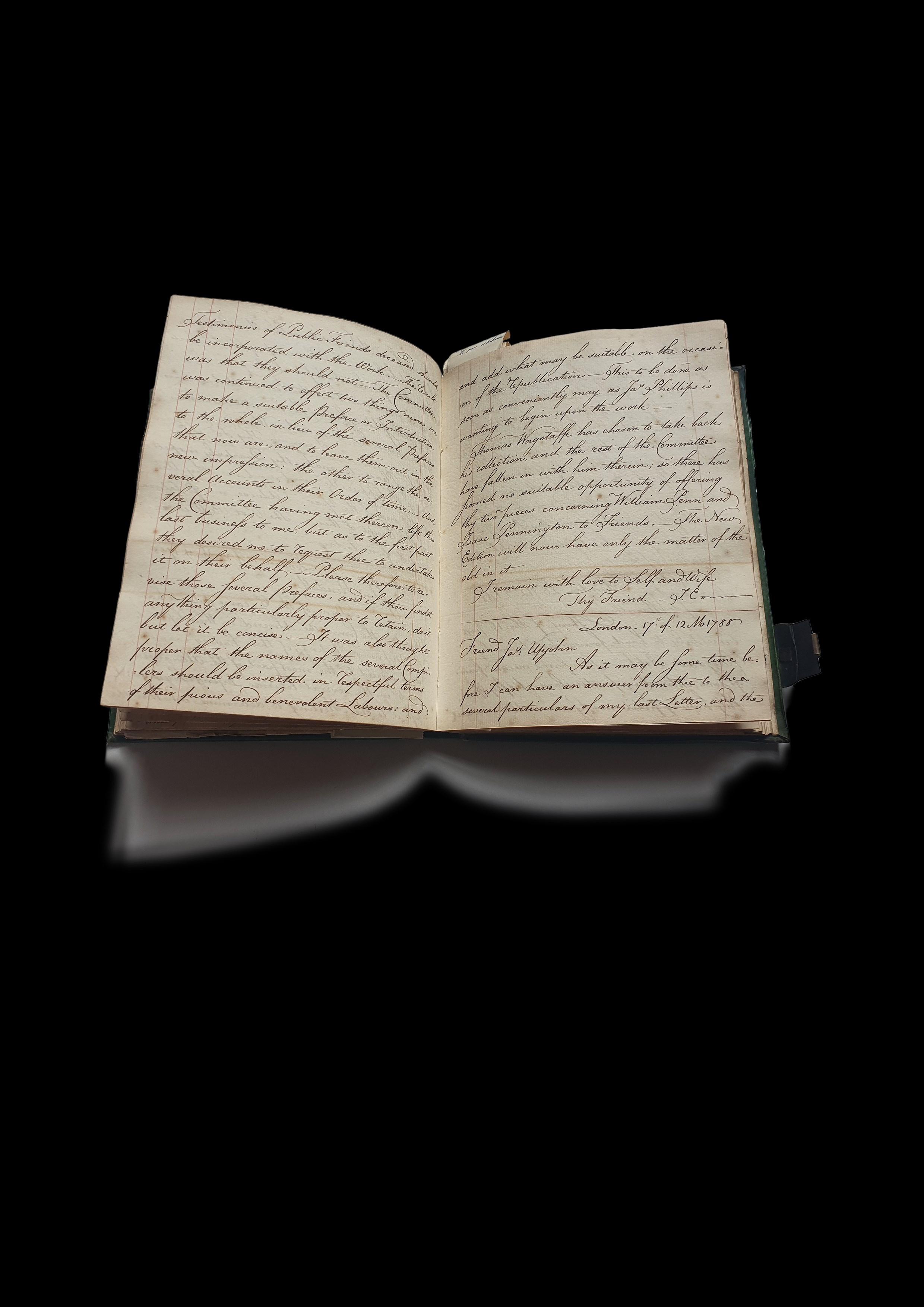
[GREEN COAT SCHOOL]
Archive of manuscripts relating to the London charity school. [Circa 1664-1800]. A small archive of 17th- and 18th-century manuscripts relating to the London charity school, St Margaret's Hospital, which was known as ‘The Green Coat School’ and is now part of Westminster City School.
Contents: [1]. Accounts book. [Circa 1775-80]. Quarto (324 x 245 x 20 mm). 56 text pages on 28 vellum leaves bound in reverse calf. [2]. Accounts. [Circa 1838]. Folio. Paper. 4 text pages on 7 leaves. [3]. ‘Tradesmen’s Bills’. [Circa 1838]. Quarto. Paper. 6 text pages on 6 leaves. [4]. Petition of Mary Blackbourne. [Circa 1730]. Folio. Paper. 1 text page, bifolium. Documents including: ‘Carpenters Worke’ [Circa 1671]; Obligation Bond Paper. 1 text page, single sheet; with a 17th century indenture and receipts.
¶ The question of whose responsibility it was to educate “Poore Children” modern period was answered by the establishment of local charity schools.
One such was St Margaret’s Hospital in Tothill Fields, Westminster, which was founded in 1624 and granted a Charter of Incorporation by Charles I in 1633. The Green Coat School, as it came to be known because of the colour of the boys’ clothes, took on “the poor fatherless children of St. Margaret’s” 1 – such as the son of “Mary Blackbourne”, whose entry petition, included here, states “That your Petr by several Losses and Misfortunes is reduced to very mean Circumstances whereby she is rendered uncapable of giving her said son Education”
The main item in the archive is a bound manuscript account book written on fine vellum sheets entitled “The Account of Abraham Acworth, Esqr, Treasurer of St. Margaret’s Hospital, Westminster” which covers the school’s accounts from 1775 to 1780. Acworth discharged his duties admirably, to judge by his bookkeeping: in these annual accounts, rendered in a scrupulously neat hand, he records the school’s income and expenditure under a set of headings including

TWENTY-ONE
Lands, Tenements, Tenants Names”, “Quarterly Payments to the Master and Matron”, Taxes, and other Out-goings”, and “Disbursements for Clothing and other Necessaries for the Boys”. This last heading for the 1779 accounts Mr More for Examining the Boys” (10 shillings) and Crapper, Master” for such items as “Roast Beef for the Boys on the (10 shillings) and “teaching the Boys Psalmody – one Year to
Accompanying this volume is a small number of documents incidental to the school’s operations: bills and receipts, entry petitions, birth certificates, and apprenticeship bonds for a few of the school’s pupils (“Waler Pritchard”, for instance, who is to live with “Anne Paine” to learn “some likely good “John Rowstone”, indentured to “John Gary, ?Lock

The workings of bureaucracy, dry as they may seem, can often provide us with the clearest traces of centuries-old lives and careers otherwise barely recorded. Documents such as these are a case in point, yielding not only names and financial details but glimpses of the everyday pleasures (“Roast Beef”) and routines (learning “Psalmody”) that characterised the lived experience of the “Poore Children” in a London charity school.
£2,750Ref: 8134
BERKELEY, George Charles Grantley FitzHardinge (1800-1881). A group of 20 illustrated letters.
[Circa 1833]. 20 handwritten letters, folded for posting.
¶ Among this humorous group of illustrated letters is a pen-and-ink selfportrait of Berkeley seated upon a display case. “Don’t you wish I may get a place for the Case at Mdm . Tussaud’s?!” he asks, and immediately answers his own question: “Oh yes!!!”.
In this and other letters in the collection, we see the lighter side of George Berkeley, a man renowned as an aristocratic snob with an argumentative and violent disposition. Berkeley was tried and found guilty of assaulting a bookseller who would not reveal the name of a reviewer who , in Fraser's Magazine; two days later he duelled with its editor, but after three shots the latter was only slightly injured.
This collection of correspondence, which comprises 20 letters, shows our scribe wielding only a pen, and indulging in flights of fancy, fits of lyricism and bouts of gentle ribbing. , possibly Mary Catherine Berkeley (née 1824) known as Lady Catherine. The few that lack a salutation have a similar tone, so were probably to her. There is a palpable fondness, when for example he “ever depend on my wish to see you perfect in everything”. The tone verges on the paternal at times, telling Catherine to “remember this as one of my , but it can also be characterised by a friendly, playful banter.
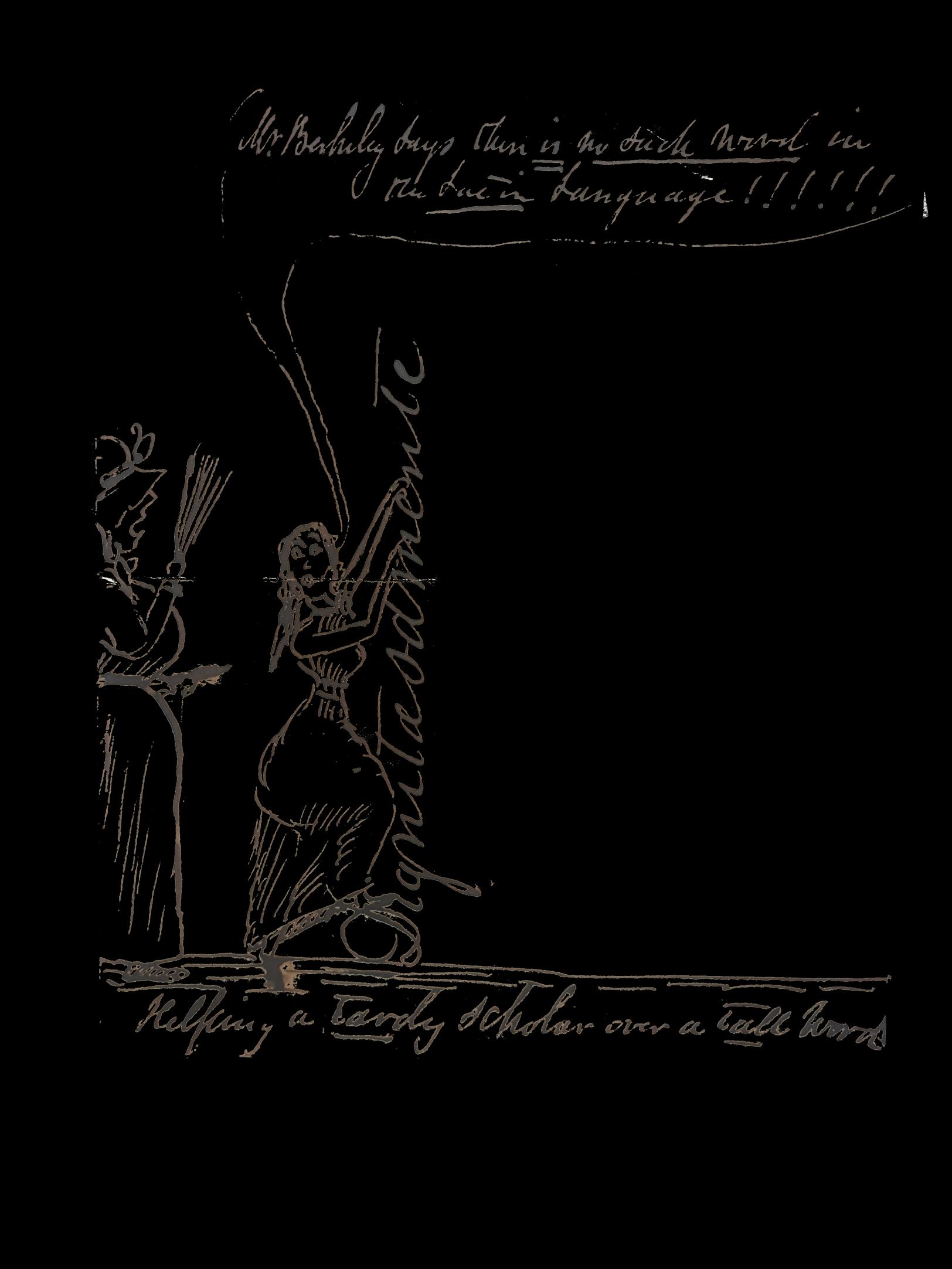
Adding to this puckish wit are a number of small motifs embedded in the writing itself, and larger, more detailed illustrations which provide further glimpses of our scribe’s personality and his fondness for gentle teasing. He indulges in little jeux d’esprit such as a cartoon apparently showing Catherine attempting to scale a vertically written word, , with the exclamatory sidenote: “Mr Berkley says there is no such and the caption “Helping a tardy scholar over a (presumably a reference to Catherine’s use of the word in a recent letter).
Other illustrations include a sketch of Catherine, (one assumes) at a
TWENTY-TWO
writing desk, and a rendering of two ladies being blown off a hilltop in a blustery wind. Berkeley reflects on his impressions of the contrast between city and countryside: he rhapsodises in one letter “the birds on shore, sing as if heralding approaching summer”, then disparages “the smoky city”. An affection for nature is evident in his description of “the fields and on the beautiful Hills and Woods” of Bath which he seems to find restorative, feeling able to “muse and think of how much is left to man”; but he again deploys his acerbic side when describing the “old chaps” of Bath with their “gay wigs and white washed faces”, and he skewers the “old Male Dusts” who “don’t do any harm, but on the contrary often lead to laughter at them an undesirable expense”.
Berkeley’s personality – or at least, the aspects of it that he chose to present to Catherine – come through strongly in these letters and their light-hearted illustrations and offer an unexpected counterpoint to his pugnacious public image.
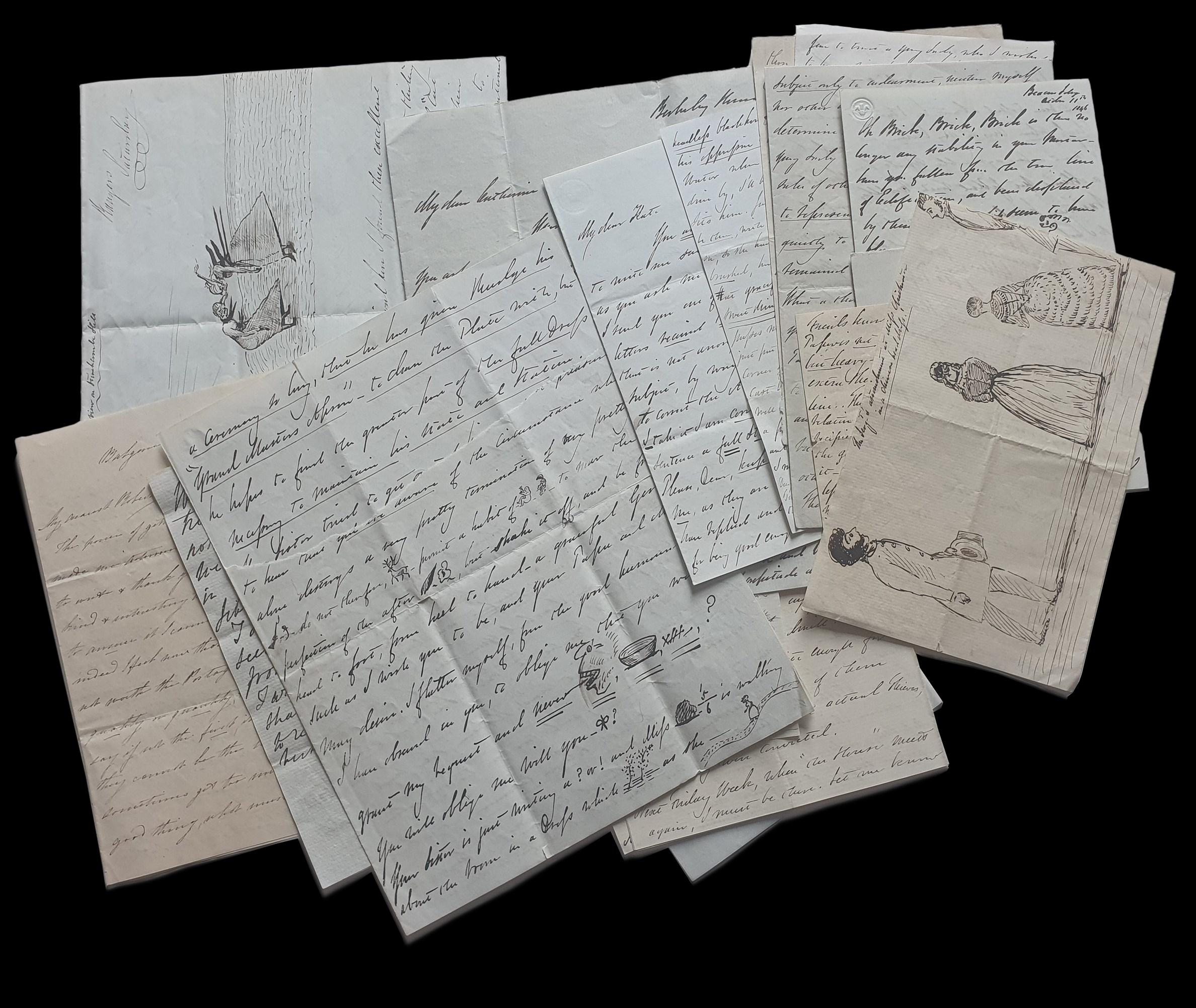 £750 Ref: 8111
£750 Ref: 8111
TWENTY-THREE
[SANDAU, Barnard von (1759-1848)]. Manuscript entitled ‘Memoirs relative to the Seminary for the Marine at Amsterdam. MDCCXCI. Translated by Barnard van Sandau’.

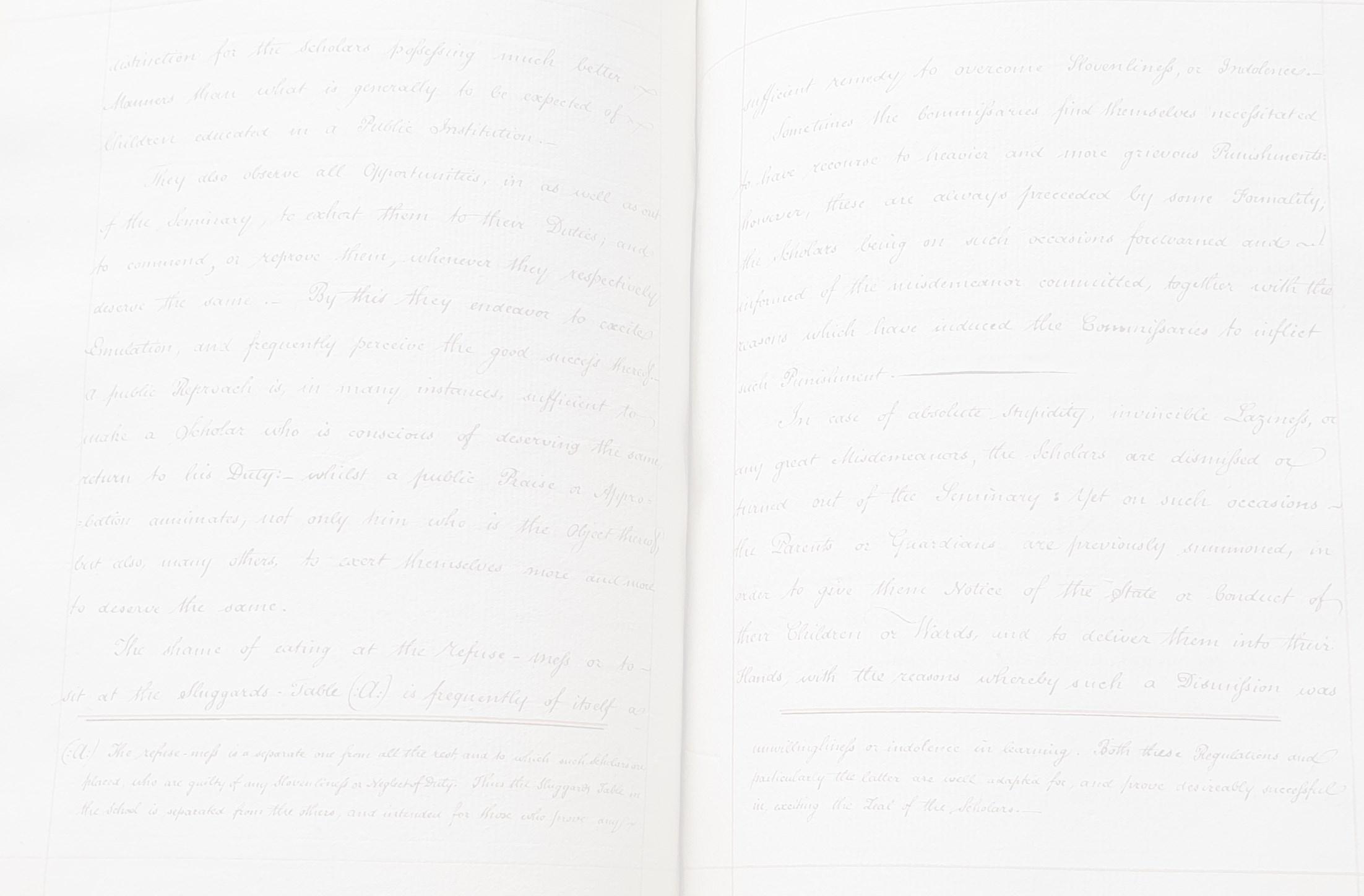
[Circa 1793 (dated in dedication)]. Quarto (text block: 235 x 182 x 30 mm). Text partly numbered in manuscript: [12, title and prelims], 153, [2], [31 (“Appendix No 1. General Accounts”], 141, [3, blanks]. Margins ruled in red. Written throughout in a clear italic hand.
Modern brown crushed morocco, gilt, title page browned in margins, otherwise clean and crisp. Watermark: Fleurs-de-lis above GR (similar to Haewood 1846, which he dates circa 1777).
¶
Popularising umbrellas is a more memorable action than a lifetime of philanthropy – at least that seems to have been the fate of the merchant and philanthropist, Jonas Hanway (1712-1786). Aside from being the first man in London to carry an umbrella (for which he was widely mocked) and his opposition to tea (for which he was mocked by Samuel Johnson), he plunged himself into numerous benevolent causes, among them smallpox inoculations, the working conditions of young apprentices of chimney sweeps, the fate of infant children in workhouses, and a charity for girls abandoned to prostitution (hence his enthusiastic support for the subsequent Magdalen Hospital for Penitent Prostitutes). Among his most successful works was the Registers Bill (later dubbed ‘Hanway’s Act’), designed to improve the lives of workhouse children, which has been called “the only piece of eighteenth-century legislation dealing with the poor which was an unqualified success”, and the establishment, in 1756, of the Marine Society, the world’s oldest public maritime charity, which still exists today.
The Marine Society’s mission was to provide good education and employment to poor boys, which in turn supplied the British Navy with thousands of much-needed, well-trained seafarers (as this manuscript puts it: “the Distressful and general national Utility are so happily blended”). It created a model for other seafaring nations to follow. One such was Holland, which, although it had for centuries been sending highly skilled mariners out into the world, did not have a benevolent organisation to help achieve the combined goals of charitable education, employment, and workforce expansion.
This manuscript gives a remarkably comprehensive account of the early years of the “Seminary for the Marine at Amsterdam”, which was modelled on the Marine Society of London. According to the preface, “The Work here translated was put into my hands by a Member of your Committee [...] William Blizard” (i.e. the surgeon Sir William Blizard FRS FRSE PRCS FSA (17431835), who knew and worked with Hanway in setting up the Marine Society).
The scribe declares himself as “Barnard van Sandau” on the title page and at the end of the preface. Sandau is said to have been “born at Homburg in the dominions of his Prussian Majesty”. In 1797 he leased a shop on the North Side of the Royal Exchange (Threadneedle Street); it appears he also had premises in Winchester Street. 1. At the time that this manuscript was written, he was working at “Basinghall Street”.
In January 1789, Sandau became a member the Worshipful Company of Scriveners. He was granted a notarial faculty which would have allowed him to formally write letters to court and compose legal documents. He is known to have translated from ‘Vulgar Hebrew’ (Yiddish) to English 2, and, as this volume demonstrates, he could handle Dutch as well. This book’s 300-plus pages would nevertheless have made it a significant undertaking. Sandau does not say whether Blizard (or another member of the Marine Society) commissioned this translation, but given that it was such a specialist subject, and that the level of detail would be of great utility in keeping the Society abreast with developments in other seafaring nations (especially those who had copied their ideas), it seems very likely that Sandau was fulfilling a commission.


The work provides an in-depth account of the charity’s aims and accomplishments; it details the kind of education the “scholars” receive to equip them for the rigours of a life at sea. They learn the art and science of navigation, supplementary skills such as “Cannonading”, and the “Knowledge of the sort, the making, and the use of all Instruments required”. The organisation also acknowledges its responsibilities to “the behoof of Seamen wounded in the service of this country”, which includes the “widows of those who had the Misfortune of losing their Lives” and “the Children of Seamen”; and there are detailed accounts of monies paid to them.

The progress of individual students is carefully chronicled. Since “the Number of their Places in the Seminary” is deemed more appropriate than “Names of the Scholars”, the records track students by their assigned number. For example, in the “Second Class”, students “411”, “417”, “418”, and “416” are “learning to denominate the Decimal Fractions”; however, while all four are considered to have a capacity of “3” (the highest in any column is 6), their rate of “Diligence” is “0”. Happily, others are more conscientious: “385” and “408” are each considered to have a “Capacity” of “4”, but with “Diligence” pushed all the way to “6”, they now “Understand the Geometrical Proportion together wit the use of Logarithm, and ought to be promoted to a higher order”.
“232”, meanwhile, scores a 4 on both their abilities and their efforts, and now “Understands Steenstra’s Navigation to find the Longitude by the Tables of Douwes, without taking a meridian Altitude; and to calculate the Longitude at Sea by the distance of the Sun from the Moon, or a Star”. Here, the student is employing the method introduced by Cornelis Douwes (1712-1773) for calculating latitude, which became an international standard until the 19th century. The Pybo Steenstra (d.1788) mentioned here is a noteworthy figure in the history of navigation: he had a great impact on its teaching in Amsterdam and did much to transform the pedagogy from a purely practical instruction to one which combined hands-on learning with rigorous classroom teaching reinforced through textbooks (many of which he himself wrote).
This is richly informative text, which abounds with details of the evolution in 18th-century navigational education. It gives detailed insight into the rigorous requirements of a mariner’s education, and shows how the Marine Society were interested in promoting the influence and evolution of the ideas they had themselves set forth into the world.

£2,250 Ref: 8159
1.Edgar Roy Samuel. ‘Anglo-Jewish Notaries and Scriveners’. Transactions (Jewish Historical Society of England), Vol. 17 (1951-52), pp. 145-146.

2.Ibid.
Schott, Margaret E. Sailing School: Navigating Science and Skill, 1550-1800.
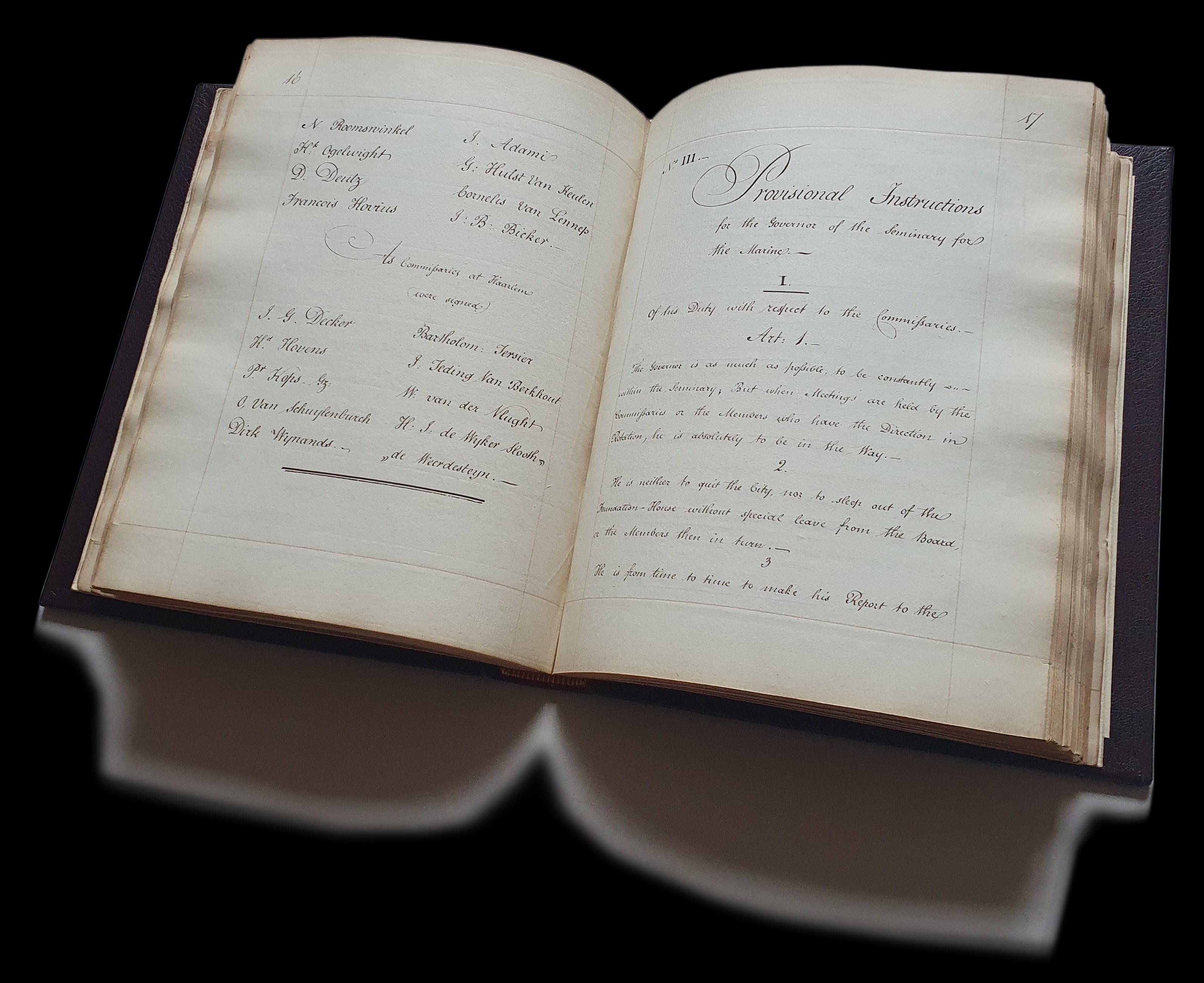
TWENTY-FOUR
[CHARLES I] The Acts made in the First [& Second] Parliament of our most high and dread soveraigne Charles, together 2 works in 1 vol.
Edinburgh, by Robert Young; Robert Young and Evan Tyler, 1633-41. Folio. Pagination 66, [10]; 160, [20] p. (Containing 31 and 110 Acts respectively). Both volumes collated and complete, with an additional manuscript table at the end. [Goldsmiths 644 and 718; STC 21902; Wing S1168D].
Profusely annotated and with a 12-page manuscript table bound in at the end in a 17th century hand.
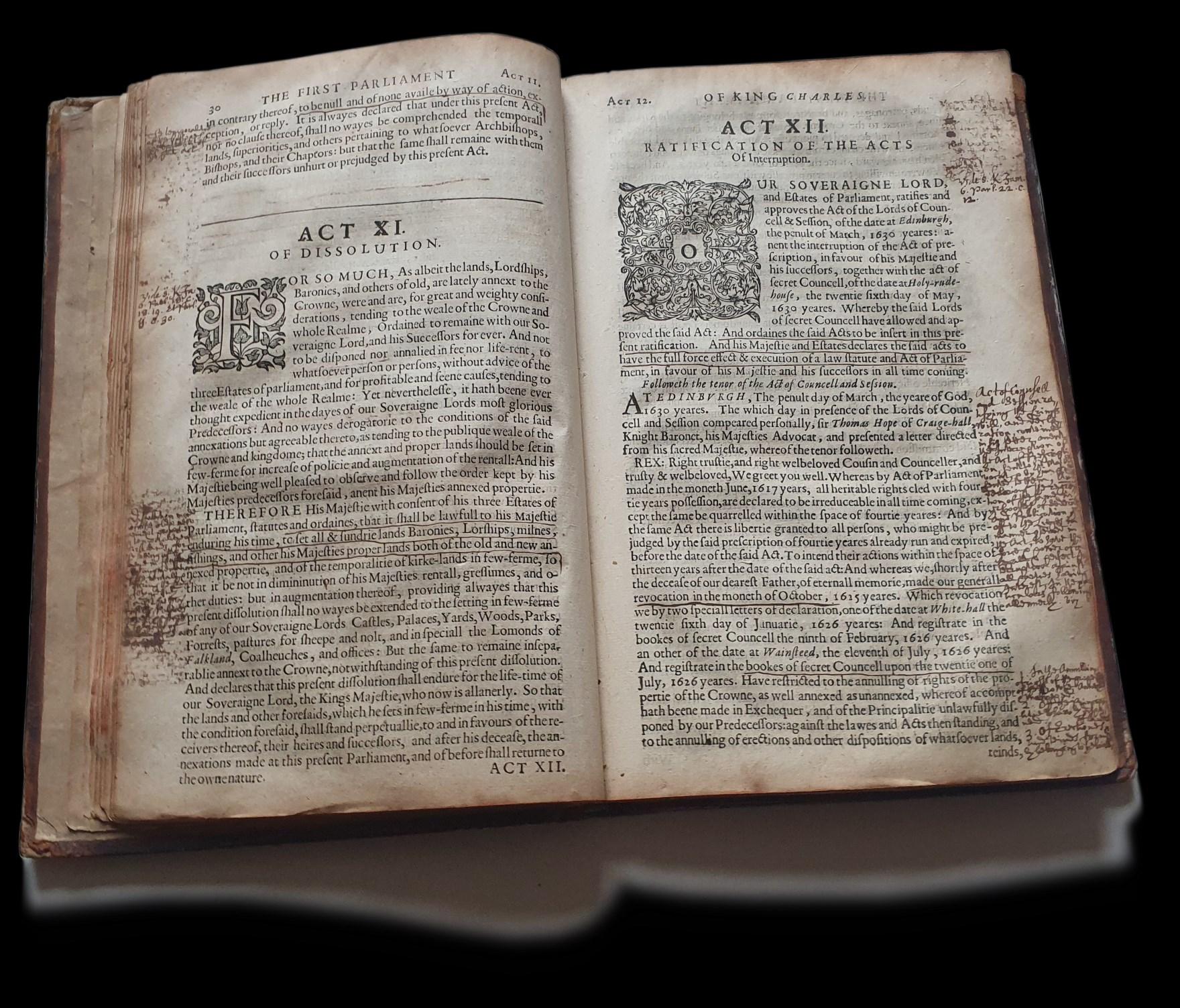
¶ The judicious but anonymous Scottish annotator of this collection of acts has created a perfect example of pen-in-hand reading. We can be reasonably confident that the scribe was Scottish, by their use of such words as ‘anent’ and ‘ane’ (“anent ye Copper coyne”; “15. Anent ye act of oblivion vide s. J. Ma. Parl.9.c.67”; “Ane Table of ye Principall Matters”).
Their notes run the gamut of textual interaction: most refer to parliamentary sessions or other legal texts (“vide i.ses.2c.25. of Parl.3.Ses.1.c.28”; “Vide. K. Jam. 6. Parl. 10.c.13”); some pages have been simply underlined or marked with a cross; others have brief finding “Power of ye Counsell”; “Exc. 1. [2, 3]”; “piuiledges of all Erecters and maintainers of Manufacties”; “power of ye Commission”), or brief commentaries (“rents gifted heerby by ye king To ye maintenanne of ye Ministerie of ye Uties & Colledges”).
Certain acts seem to have particularly caught their attention.
The most heavily annotated section is pp.22-32 (Acts IX-XII), which covers “The Kings Generall Revocation”, “Anent the Annexation of his Maiesties Propertie”, “Of Dissolution”, and “Ratification of the Acts of Interruption”. The copious notes here are densely packed, which combined with some bleed-through make some of the wording difficult to decipher, but it offers an interesting mixture of précis and commentaries on the text. We offer a few small samples here: “And g[ene]rally All Acts & dispositions made in detriment of the King soule & conscience or of the Crowne & church, and contrary to the Lawes of the Kingdome”; “The Superiorities of all Kings lands erected & temporall Lords”; “Acts of Counsell and Session ratifying the Kings will, and declaration, conteined in his letter, anent the Interruption of the Act of prescription, sent to his Majas uocal, & by him presented to them, [...] to saue the force & power of a Loyall [...] aginst all parties hauing Interest, In the particulars following”
This was intended as a working document that would be consulted repeatedly, to judge by the inclusion at the end of the volume of an index entitled: “Ane Table of ye Principall Matters contained in ye 21.22. & 23. Parlts of K. James 6 and all ye Parlts of K. Charles I”, which is arranged in columns detailing the subject, monarch, parliament, session, chapter, and date.
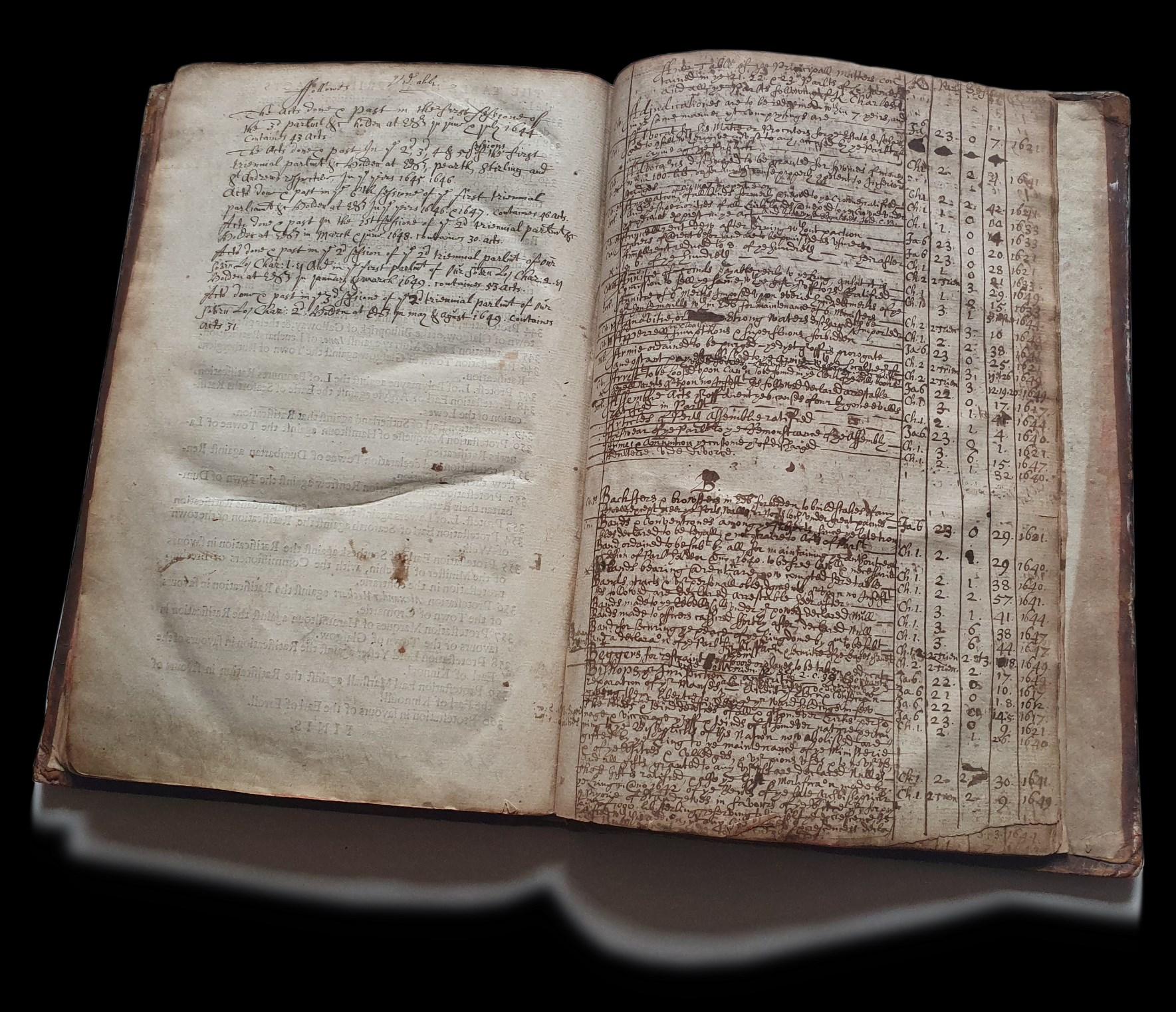
The manuscript notes remain within the scope of the acts covered in the printed section. The latest manuscript date is 1649, which marked the end of the life of the acts’ nominal author – Charles I – and coincided with the prelude to the invasion of Scotland by the army of the New English Commonwealth.
SOLD Ref: 8154
[CARTWRIGHT, Charles; HILL, George] Manuscript sermons [bound with] The vvhole book of Psalmes: collected into English meeter, by Thomas Sternhold, Iohn Hopkins, and others, conferred with the Hebrew, with apt notes to sing them withall.
London: Printed by G. M[iller] for the Companie of Stationers. Cum priuilegio Regis Regali, 1633. [Manuscript Circa 1639-1651].
Octavo. Pagination [10], 91, [3] p. Collated and complete (but corner of A4 torn with loss to 14 lines of text). A fragment of 11 leaves from another contemporary edition of the Psalms is loosely inserted at the end. Approximately 113 manuscript pages (plus some blanks) bound before the printed text comprising four sermons. A few leaves appear to have been excised from the first sermon, thereafter complete.
¶ While violent upheavals and widespread destruction during the 1640s tore apart the social fabric of England, Charles Cartwright was intent on bringing together this volume of print and manuscript material, apparently to aid and record his preaching. Cartwright has taken a printed edition of the Book of Psalms and bound in over 100 pages of his own manuscript sermons, to create a portmanteau that probably accompanied him on his travels.
An in inscription to f.1 reads “soro mono at puisant but I am your Louing brother untill death Charles Cartwright 1649 anno Io. Charles Charles Finis Elizabeth” (presumably the sister referred to in the Latin inscription). Another inscription of similar vintage to the rear endpaper reads simply “George Hill” and has his pen trials, but given that Cartwright has inscribed to the volume to his sister Elizabeth, and he dates it within the period in which the sermons were written, we assume that the scribe was Cartwright. However, despite the fact that we know his name, together with the dates and places of the sermons, Cartwright’s identity has proved elusive. He does not appear in the CCED database, but they have a gap in their records at these dates, so the records may have fallen victim the chaos of the era.
Parts of the manuscript may contribute in a small way to filling in a few gaps in these records: Cartwright’s comments indicate that these sermons were used at several locations and at different times. He notes, for example, that the sermon on “Luke .2.10.11.” was delivered at “Willingham: 1639: Bonby: 46: Old Malton 1651”, and “Esay 25: 6.7” at “Willingham: 1640: Ashby: 1641: Thurston . 1642. Old Malton 1649. Narborough 1646. Bonby 1647”. There’s a notable shift in tone from the early part of Cartwright’s manuscript, which is suggestive of a preacher learning to moderate his public statements in the name of prudence. In the first sermon he shows his Royalist colours with a stout defence of the Divine Right of Kings that uses the Biblical metaphor of a vineyard: “god provides for the preservation of his vineyard as a Nation by building a tower in ye midst […] Such is a King, who […] by his sovereign power is also to quell all forraign enimies & domestick rebellions by his princely clemoncie” and, as the monarch is not accountable to parliament “by his impartiall & uncontrolled justice to regulate & correct offences”, he is within his right to dissolve it, or as Cartwright says “by his kingly proregain” (which we read as prorogation) “to protect countenance & justifie his ministers and ye dressers of the wise execution of his lawes”. Cartwright presses home the argument that “god himselfe is this tower and his vineyard, The king his vice regent his principall husbandman, and as he hath god’s power of his people delivered into him, as his delegate; so is he in gods steed the tower of defence, upon the earth in ye minds of ye nationall vineyard; whosoever therefore resisting this power this tower; resisteth God himself”. Before long,
TWENTY-FIVE
Cartwright becomes specific: “such a tower was our Charles to us, till sedition, faction superstition, heresie, treason, rebellion, prophaneness irreligion, blasphemie and contempt of all holy things broke downe our headge, dismantled our fortresse, sed prestat motos componene fluctus”.
This Latin phrase, from Virgil’s Aeneid (roughly, “but let me still the raging waves”), and cited by Cicero as a rhetorical device, seems here to signal Cartwright’s ambivalence over being too outspoken about current events; and it foreshadows how, after this outburst, Cartwright effectively unpins his colours from the mast and in the following three sermons, sticks to safer scriptural ground (“I neede not trouble my selfe with unfoulding ye context, doing it is only an historicall relation of ye nativity of our saviour”), perhaps realising the need for greater discretion to avoid controversy during the Civil War years. This rare survivor from a tumultuous decade in English history, quietly reveals its author’s sympathies and hints at some of the tactics they used to survive the violence of the period.
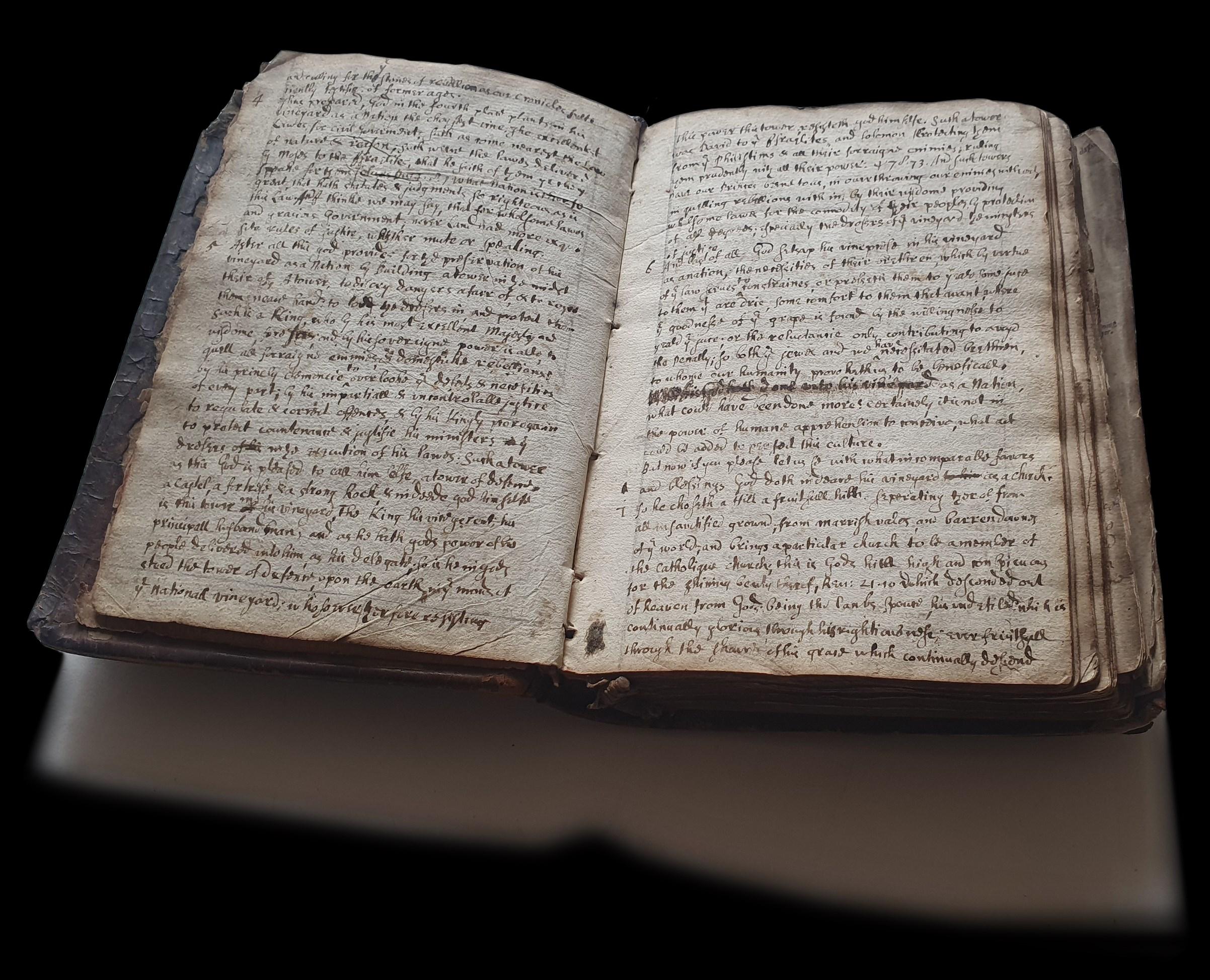
BROWNE, Thomas, Sir (1605-1682) Pseudodoxia epidemica: or, Enquiries into very many received tenents, and commonly presumed truths. By
 Thomas Browne Dr of Physick.
Thomas Browne Dr of Physick.
London: printed by A. Miller, for Edw. Dod and Nath. Ekins, at the Gunne in Ivie Lane, 1650. Second edition. Folio. Pagination [16], 329, [11] p. Collated and complete. [Wing, B5160; Keynes, Browne, 74]. Contemporary sheep, rebacked with the original spine laid down, new label, recornered. Scattered spotting to text, but paper quite crisp. Inscription to title page “Sam:[uel] Wight: pr.”
¶ Just as Religio Medici established Thomas Browne’s reputation as a religious thinker, his subsequent and most extensive work, the Pseudodoxia, earned him fame as a scholar, naturalist and – to borrow a modern phrase –debunker of misinformation. Browne applies a Baconian methodology (outlined in Bacon’s Advancement of Learning) to a plethora of misconceptions and false beliefs.
After setting out general observations concerning the manner of mankind’s falling into error and misapprehension (“Of Credulity and Supinity”; “Of obstinate adherence unto Antiquity”; and so on), Browne tackles specific “Tenents”, divided into six sections, including “Minerall, and vegetable bodies”, “Man”, and “Historicall Tenents generally received, and some deduced from the History of holy Scripture”. He brings his signature combination of pious observance and rigorous enquiry to a wide spectrum of received wisdom, giving equally serious consideration to “the food of John the Baptst in the wildernesse”, the contention “That a Diamond is made soft, or broke by the blood of a Goate”, the notions “That the Tower of Babel was erected against a second deluge”, and that “our Saviour never laughed”, and the popular belief “That a Brock or Badger hath the legs on one side shorter then of the other”.
The Pseudodoxia’s eclectic early-modern myth busting, shot through as it is with its own wrongheaded arguments, is nevertheless a crucially important and influential document in the development of the scientific method as conceived by Bacon and his contemporaries.
SOLD Ref: 8109
TWENTY-SIX
BROWNE Thomas, Sir (1605-1682) Hydriotaphia, urne-buriall, or, a discourse of the sepulchrall urnes lately found in Norfolk. Together with the garden of Cyrus, or the quincunciall, lozenge, or net-work plantations of the ancients, artificially, naturally, mystically considered. With sundry observations. By Thomas Browne D. of Physick.
London: printed for Hen. Brome at the signe of the Gun in Ivy-lane, 1658. FIRST EDITION. Octavo. Pagination [16], 102 [i.e. 202], [4], p. errata trimmed and pasted to blank area of final text leaf, lacks vertical half-title.
¶ Sir Thomas Browne’s influence on subsequent generations of writers and thinkers is incalculable, not least among the leading lights of Romanticism such as Coleridge, Lamb and De Quincey and their peers Hazlitt and Carlyle. The diversity of his interests, the embrace of Baconian ‘new learning’ and the wit and imagination of his writings were praised (not without reservations) by Samuel Johnson, and his cultivation of a variety of literary styles resulted in writings that ranged from quick sketches to lengthy, elaborately wrought works.
If Browne’s most popular work was Religio medici – a two-part exploration of his “relationships to his God and fellow creatures” – Hydriotaphia “may be one of the first archaeological monographs in English” (ODNB). It begins with a description of a large number of Anglo-Saxon pots discovered in Norfolk, after which Browne gives an overview of funerary and burial customs, both ancient and contemporary.

Browne's luxuriant style and ... are more widely known and read than perhaps any other of his work.”.
This is a copy of the first edition of a work whose flawed factual accuracy (he mistakenly reckoned the pots, for instance, to be Roman) is more than compensated for by its combination of wit and solemn lyricism: as, for example, in his famous, double edged description of man as “a Noble Animal, splendid in ashes, and pompous in the grave, solemnizing Nativities and Deaths with equal lustre, nor omitting Ceremonies of bravery, in the infamy of his nature”. Such passages have led to Hydriotaphia’s being praised and quoted in the works of Borges, Poe, Melville, Derek Walcott and WG Sebald, among others.
£1,000 Ref: 8108
TWENTY-SEVEN
FALE, Thomas (active 1604); annotated by RHODES, William. Horologiographia. The art of dialling: teaching an easie and perfect way to make all kinds of dials vpon any plaine plat howsoeuer placed. With the drawing of the twelue signes, and houres vnequall in them all. Whereunto is annexed the making and vse of other dials and instruments, whereby the houre of the day and night is knowne: of speciall vse and delight, not only for students of the arts mathematicall, but also for diuers artificers, architects, surueyours of buildings, free-Masons and others. By

 Thomas Fale.
Thomas Fale.
At London: Imprinted by Felix Kyngston, dwelling in Pater noster-Row, 1627. Quarto. Foliation [4], 60, [16], Signatures: A-Q⁴ (R)⁴ R-T⁴ leaves, lacking leaf D4, fragment of rear endpaper remaining.

Contemporary limp vellum, very heavily worn and since bound into an early 20th-century buckram binding. The text is browned, and the margins very chipped and flaking, loss to the letter “T” in the word “ART” in the second line of title, and to edges of some annotations.
Provenance: Two ownership inscriptions to final leaf and stub of endpaper: “Wm Higgenson Booke 1666” and “Will: Higgenson”. A scrap of paper and pasted to title verso “George Pares’s Book Nov. 19 1879” with a calculation of the time since the was printed. Inscription to R1v: “Wm Rhodes his Book Bought this present Nov: 26 Anno Domini 1778”. Copious 19th-century annotations by William Rhodes throughout, some initialed “WR”.
TWENTY-EIGHT
¶ To describe this heavily worn copy of Fale’s Horologiographia as having been annotated by William Rhodes hardly does it justice. His annotations are numerous, and most pages feature date calculations by Rhodes; so far, so horological. But Rhodes’ notes go far beyond that, combining the objectivity required of his vocation with a touching and emotional subjectivity – and both, at times, have a compulsive quality that, had the term existed in the 19th century, might have earned him the descriptor ‘neurodiverse’.
Rhodes was notable enough in his sphere to merit a mention in Gatty’s Book of Sun-dials: “At the beginning of the nineteenth century, one William Rhodes, a tobacconist and pewterer, was living in Liverpool, and he possessed several works on the art of dialling, by Fale, De la Hire, and others, which he annotated in his own writing with mottoes from dials. He bought Fale's work in 1802, but the copy had belonged, in 1675, to ‘Thomas Skelson,’” 1. Ours is another of his copies, the fourth edition, 1627, which Rhodes in his inscription says he bought in “Anno Domini 1778”.

Before Rhodes acquired this copy, its 17th-century owner, “Will: Higgenson”, appears to have made notes of his own, such as “How to make a earth(?) for your moulds to cast Brass which will bee cleare : Soe you may cast your brass into any forme as plates for Horizontal Dyales, or for quadrant Dyals or round plates for night Dyals” (Q4v); beside the illustration for “The West Diall erect”, “Devide the midd line in 5. […] likewise Devide the middle Circle in 6. […] the bottom of ye pl[ate] that is the Distance Devides in 2 / one for the Left quadrant from side of the plat” and marked up the illustration according to these instructions (D1r); and the cryptic “c. & h. is the same yt. e & I is it is c.f. e. k is L.M. for stile Least distance from L.& the stile as L unto O” (D2r).
Rhodes was by all accounts a prolific annotator: among many other books he is known to have given the same treatment (besides the above) are The Art of Shadows; or, Universal Dialling by John Good (1771), The Art of Dialling by William Leybourn (1669), and Horologiographia Optica. Dialling Universal and Particular by Silvanus Morgan (1652).2 The nature of his annotations, too, was similar to those in our volume: they reportedly included “family memoranda and commonplace Latin mottoes”.
Rhodes’ manuscript notes confirm Gatty’s description of him as “a tobacconist”, for example in his memos “Our Little Tobacco Engine Sold from Wharehouse this present 2 June” (N1r), and “Aug 9 1783 put up Brass Dial North Declining West …” (E2v). But “pewterer” is less certain: in burial records for his children he is recorded as a “brazier”3 – a point confirmed in notes such as “Aug 9 1783 put up Brass Dial North Declining West” (E2v) and “Put up New Brass Dial dated Nov 1st on Nov 6 1781. Now Nov: 14 1782. made first Rocket pridie” (I1r). He records having installed many such sundials, including a clutch of them in one entry: “July 15 1783 got stone Pillar Horizontal Dial pridie Put up New B. to Dial on it 15 of Spet: 1783 now Sept: 17 1783 it was the 15 Mar put up one on the kitchen Door Date May 1 1784. Decl 48.50 4 May 5 1784 Glorious Day put up 2 Dials on the pump Rec. 51-3 Decl: 39 the other an Horizontal on the Stone in the yard Sept: 3 1784 now Sept: 7 1784” (E2r).
His attention to dates and their calculation borders on the obsessive: sometimes these are relatively trivial, as when he shows his workings to estimate that it has been “200 years since this book was printed viz 1727”, and that he “Bought it in
1778” (E1v, which also features a long note concerning weather and dates). Since he is clearly accomplished at such calculations, one gets the impression that Rhodes is deriving satisfaction from writing them out. This seems deeply rooted in his character, and all the more so because these work-related notes are inextricably bound up with a much more personal seam of annotations in which he applies his skills to the working-through of his own grief.


TIMING IS EVERYTHING
Rhodes clearly had much to grieve over: among his notes is one dated “Sept: 24 1822” which reads: “Little Martha ON died Sept: 21 1822 and buried at the Church along [w]ith her poor grand mother and uncle hodie”, with a calculation of years between 1822 and 1779 (B2v); another, sharing space with notes on a “Barometer”, calculates the duration between 1821 and 1784, and adds “Longum nunc videtur præsentem post mortem Martha Charæ uxorem who died March 17 1820” (B3r). Similarly, his work shades into his emotional life in the entry: “July 30 1802. the 3 Sun Dials in Coln Church yard made in the year 1672. Mater mea ibi nata anno 1722 / 1672 put up 50 years before she was born” (Rhodes’ use of Latin perhaps signifying an attempt to solemnize his loved ones’ death or, paradoxically, to create a little distance from the distress he so compulsively revisits).
Rhodes is also blessed (or perhaps cursed) with a prodigious memory, judging by his recollections of affecting little details: having noted “Friday Sept: 3 1813 Julia Ann Rhodes my dearly beloved daughter was buried that day”, he adds that he “bought Apples at a small cottage in Aintree when going fetch Maria home Sept: 23 1812”, and “showed Julia the foot road over the long field which her brother John so very like her walked over with –(?) Sept: 11 1791, never –(?) again. WR”. A note elsewhere clarifies this brother’s sad fate: “March 10 1812 Johannes filius departed this life Tuesday March 10 anno 1795. being just 17 years since this day. Sec fuget irreparable tempus” (M1r).
Grief sometimes manifests not just in Rhodes’ evocation of such poignant moments but in his repeating them: in an entry dated “Dec: 11 1833”, he writes “that’s Dadda’ Dilay book not touch it. Poor dear Elizabeth Mary used to say in old kitchen below many a time. she died May 1780” (F4r); he tells this anecdote again a little further on (H1v). That he often writes these passages in letters larger and bolder than the printed text contributes to the impression that these are not just annotations but heartfelt engravings.
The annotations to this somewhat battered and sadly incomplete volume show their author to be a fascinating mix of detailobsessed, process-driven and emotionally raw – the last of these apparently impossible to separate from the rest. This remarkable artefact shows the sometimes-uneasy interplay between public and private in the mind of an artisan for whom time was a defining preoccupation.
SOLD Ref: 8145
References:
1. Gatty, Margaret Scott. The Book of Sun-dials. (4th ed. 1900).

2.‘Bibliography of Dialling’ in Notes and Queries (no. 191, 1889)
3.Burial: 6 Jan 1792 St Nicholas, Liverpool, Lancs. Martha Rhodes - Daughter of William Rhodes & Martha. Died: 5 Jan 1792. Age: 12 days. Abode: Pool lane. Occupation: Brazier. <https://www.lan-opc.org.uk/Liverpool/Liverpool-Central/stnicholas/burials_1792i.html>; Burial: 13 Nov 1793 St Nicholas, Liverpool, Lancs. Sarah Rhodes - Daughter of William Rhodes & Martha (formerly Moorhouse). Died: 11 Nov 1793. Age: 10 mths. Abode: Pool lane. Occupation: Brazier. <https://www.lan-opc.org.uk/Liverpool/Liverpool-Central/stnicholas/burials_1793i.html>

TWENTY-NINE
SCHANK (or SHANK), Martin (1670-1747) Manuscript sermons and essays.
[Scotland, Aberdeenshire? Circa 1697-1710]. Quarto (195 x 158 x 18 mm). Pagination 83, [1, blank], 103, [5, blanks], 37, [1, blank], 25 (lacking pp 23/4). Contemporary panelled calf, rubbed, front board detached. Watermark: Horn (obscured in the gutter).

Provenance: Armorial bookplate: “Shank of Castlerigg”. Inscription to front free endpaper: “Mr Martin Schank: Father to Alexander Schank”
¶ Martin Schank (or Shank) was the son of Henry Schank, bailie of Kinghorn in Fife, Scotland. After graduating M.A. from St Andrews in 1690, he became chaplain to Mrs Edmonston of Ednam and was ordained in Auchtertool in 1694. He translated to Newhills in 1697, the same year he married Margaret, daughter of Thomas Downie, an Edinburgh merchant. Their children are recorded as Alexander Schank, of Castlerig, and Matthew Shank. From 1699 until his death in 1747, he was parish minister of Banchory, Aberdeenshire.
These five essays and sermons appear to have been composed at the beginning of his career as a minster at Banchory. They comprise:
[1]. “A Practical Discourse, on Heaven”, annotated in different ink: “Mr Martine Schank 1701”. (pp. 1-59, [1, blank]), written in a neat hand with occasional corrections due to copying errors. Schank's commentary on “Luke 12:31” includes the confident assertion that “Marriage is such a comfortable state, that Paradise it self could not be happy without it”. There are two stubs, but the numbering is continuous, so these excisions do not indicate loss.
[2]. “A Practical Discourse on the vanity of the Creatur”. (pp. 61-83, [1, blank]) – taking its cue from “Eccles. 1.14. I have seen all the works that are done under the sun, and behold, all is vanity & vexation of Spirit”.
31]. “A Practical Discourse concerning the Accomplishments of the Promises on the first part of the Text, & on the Second Discourse of our Pilgrimage in the World”. (pp. 1-103, [5, blanks]). A passage from “Hebr.11.13” is the prompt for Schank’s opening: “The Apostle is here perswading his hearers to Constancy and Courage in the day of Trial”; he commends to his audience “the shield of Faith, which would be proof against all the Darts of Satan”.
[4]. “Preparati[on?] [ ?] Sermons immediately before 1697”. The title has been partially rubbed out. The running title reads “A Practical Discourse on Self-Examination”. (pp. 1-37, [1, blank]). [5]. “1710”. The title has been rubbed out, and only the date remains. The running title reads “A Sermon concerning the Peace”. (pp. 1-25, but lacking pp. 23/4, [1, blank]).
These works, which appear to be unpublished, combine Schank’s youthful energy and passion for preaching with selfreflection and his evident enjoyment of his marriage for whom the married state evidently afforded him ease and comfort.
<https://www.ancestor.abel.co.uk/Angus/Banchory_Ter.html>


8102
£1,500 Ref:
THIRTY
[CULINARY MANUSCRIPT] Early 19th century culinary manuscript
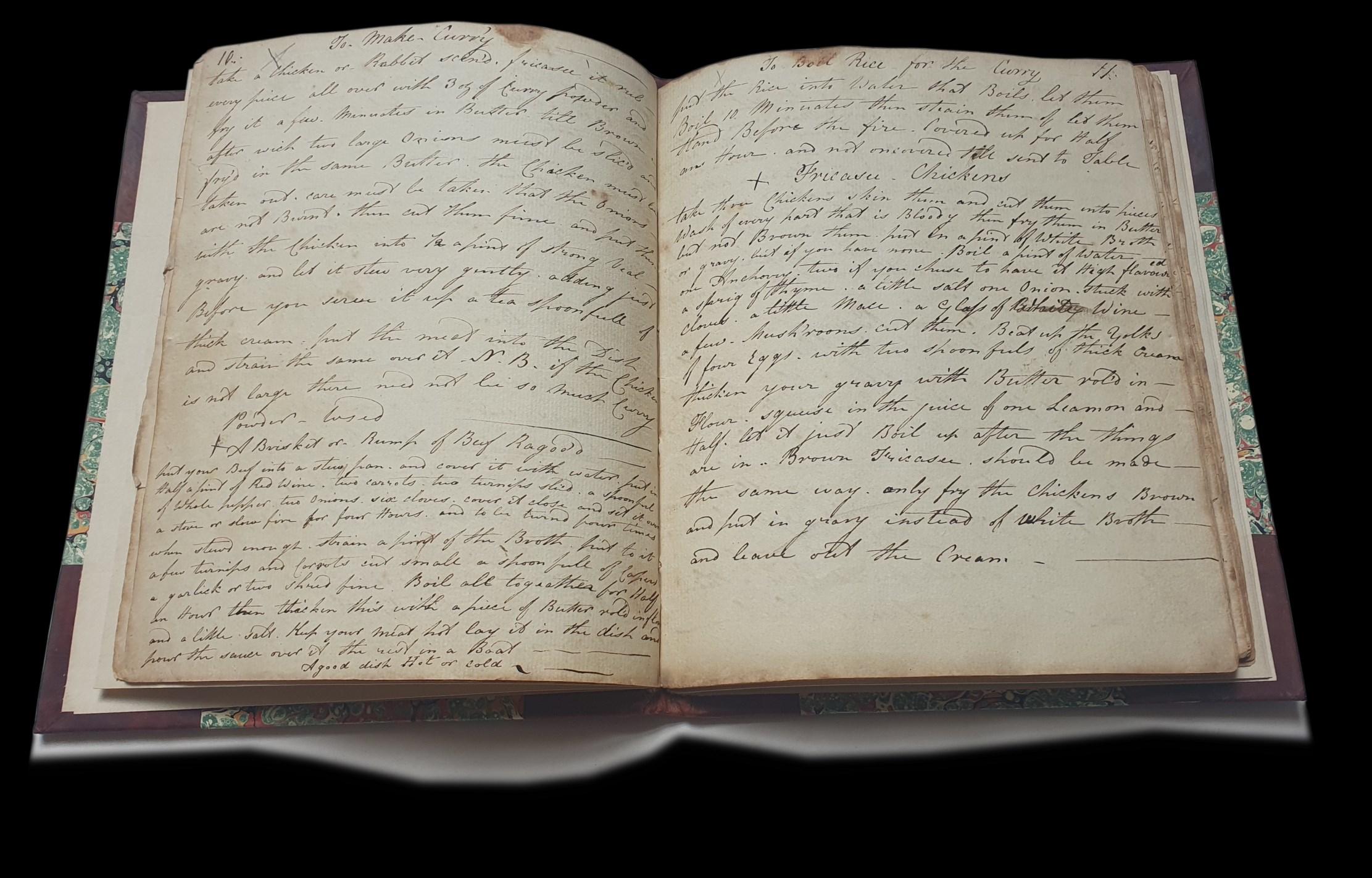
[Circa 1800]. Slim quarto (210 x 175 x 10 mm). 55 text pages on 28 leaves. Numbered to p30. Lacking pp5-6 in paginated section, two stubs before unnumbered section. Modern half calf, marbled boards, some staining and marking to text. Watermark: Britannia seated in an oval, surmounted by a crown, I Furness & Co.

¶ The anonymous compiler of this Georgian manuscript cookbook appears to have been comfortably off, but not wealthy. The 100-plus recipes cover dishes featuring meat, fish, cakes and puddings, but although there are many attributions, using these to establish our scribes’ identities or location proves decidedly difficult.
The book’s creator clearly had no interest in presentation or even rationalization, and no index or other finding system. Neither is there an overall order to the manuscript: “Dutch Flummery”, for example, is paired incongruously with “Pickled Fish” on p16, and “Damsen Cheese” accompanies “To Hash a Calves Head” on p19. There are no dates, but hand varies a little, so we assume it was compiled over a period of several years.
Some sections or recipes are, however, arranged together. “To make Curry” (“take a Chicken or Rabbit scin’d fricasse it rub every piece all over with Curry Powder” add a “strong Veal gravy” and “stew gently” (p10)) is complemented on the facing page by instructions “To Boil Rice for the Curry” (for the familiar 10-minute cooking time, after which the rice is “Covered up for Half an Hour and not uncovered till sent to Table” (p11)). Likewise, the recipe for “Oyster Sausages” offered by “Dor Hunter” conveniently occupies the same page as a method “To feed Oysters” (p[39]).
A larger exception to the unstructured nature of the book is a group of over 20 recipes (pp18-29) which all originated from a “Mrs Rasher”. These have been entered in together, so were likely copied in from her recipe book. She mainly supplies recipes for cakes and puddings, including several types of “Cheese” (“Damsen”, “Lemon”, “Citron), a couple of flummeries (“Italian” and “Duch”) and puddings (“Orange Puding”, “Baked Apple Puding). Conspicuously savoury among this group is a recipe for “India Pickle” which, once you have prepared “Ginger”, “garlick”, “Pennywoth”, “Turmereck”, “Vinegar” and other ingredients, veers from the particular to the general: “put in the following things the Inside of Cabage Cut in quarters Appels Cucumbers or any thing you please” (p27).

The enigmatic “H H” provides several recipes, including “Calves Feet Jelly” (p[38]), “Stewd Eel” (considered “Excellent” (p [33])), and “Risoles” which, “if wanted particular nice”, one should “cover with Bread Crumbs twise and be sure not to put in two much gravy as you Cannot work them into nice shapes if you do” (p[38]). Other attributed recipes include “To Preserve Cucumbers Mrs Edwd Evenes” (p[48]), “Mrs Davises Receipt to Preserve Mellons” (p[49]) and “French Bread Mrs Moleneaux” (p[53]). The mononymic “Simpson” (perhaps a servant?) has recipes for “Giblet Soup Simpson” (p[40]), “Risoles” (p[55), and “Sorrell Sawse”, also judged “Excellent”. The most specific name reference is a “Mrs Brooke at the Revd . Mr Dowsings North Balsham” (p17), (who also have a recipe for “Calves Feet Jelly”), but despite their names and location, the Reverend Dowsing of Balsham and Mrs Brooke prove surprisingly elusive.
£650 Ref: 8116

BELL, Thomas (active 1593-1610). The vvoefull crie of Rome. Containing a defiance to popery. With Thomas Bells second challenge to all fauorites of that Romish faction. Succinctly comprehending much variety of matter, full of honest recreation, and very profitable and expedient for all sorts of people: but especially for all simply seduced Papists.
London: Printed by T[homas] C[reede] for William Welby, and are to be sold at his shop in Paules Church-yard, at the signe of the Grayhound, 1605. Only edition.
Quarto. Pagination [6], 77, [1], p. text complete, lacking the first and final blanks. [STC (2nd ed.), 1833].
¶ Thomas Bell exemplifies a certain breed of fervent Roman Catholic who, after recanting, begins to express an equally devoted and vociferous hostility to “Popish Tyrannie”. The Yorkshire-born Bell embraced Catholicism in 1570 and was arrested and imprisoned, but escaped to the Continent, where he studied at Douai College and the English College at Rome. After taking Catholic orders, he took part in a mission to England in 1582, becoming “one of the most energetic, daring, and influential priests working in the north of England, first in Yorkshire and later in Lancashire” (ODNB). A decade later, having made enemies of both Protestants and many of his fellow Catholics, Bell gave himself up to the authorities, turned ‘hassock pigeon’ by providing details of the mission and its networks, and embarked on a series of anti-Catholic publications, the most famous of which was The Anatomie of Popish Tyrannie (1603).
In similar vein, The vvoefull crie of Rome (1605) includes chapter titles such as “Of the way and meanes, by which the Popes attained their vsurped primacie”, “Of the Popes bloody tyranny”, and “Of the abhomination of popish proceeding” give one a flavour of Bell’s rhetoric.
A scarce book, ESTC locates 8 copies in the UK, and 6 copies in the USA.
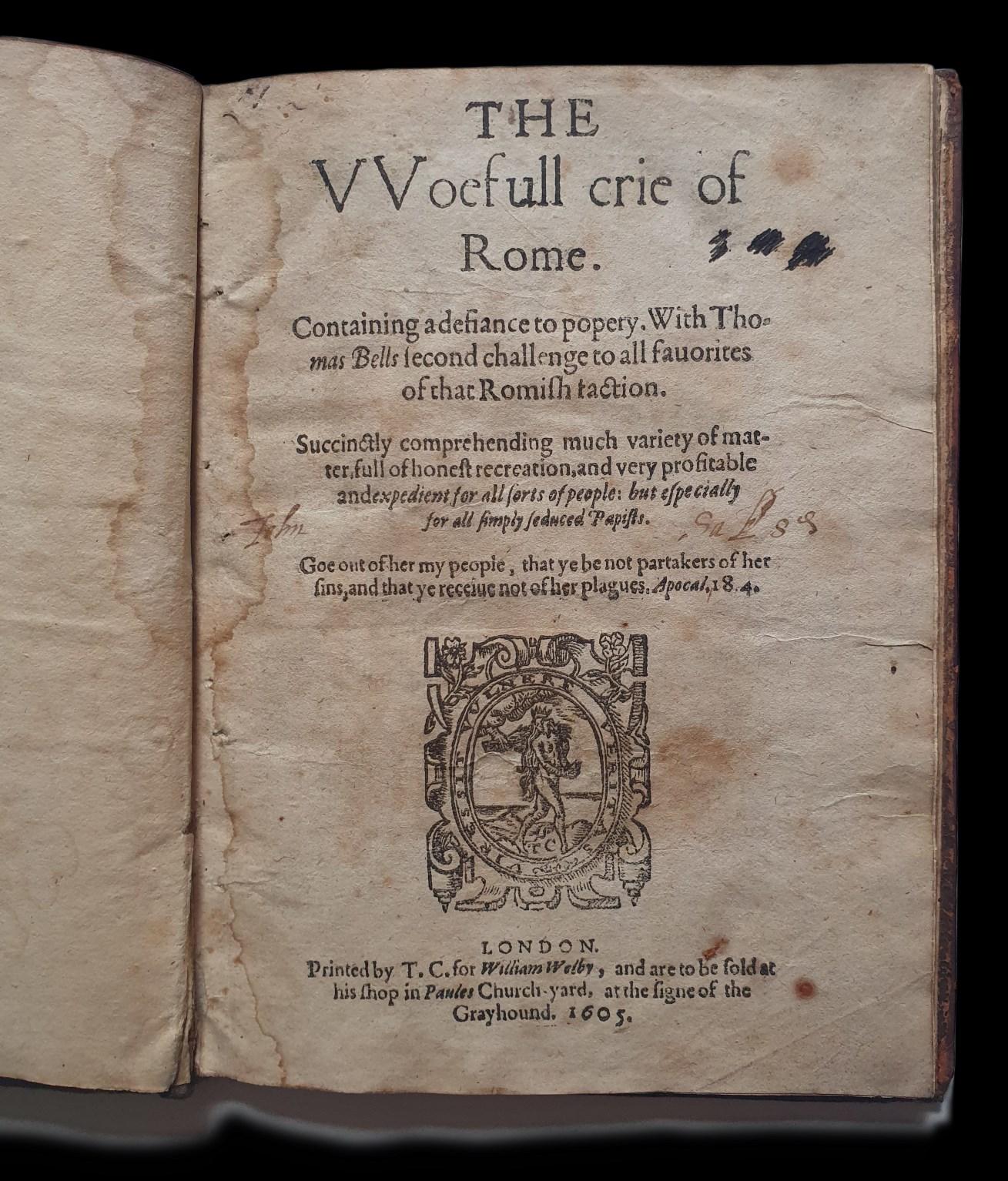
THIRTY-ONE
£950 Ref: 8132
CULPEPER, Nicholas (1616-1654). Pharmacopoeia Londinensis: or The London dispensatory further adorned by the studies and collections of the fellows, now living of the said colledg.
London: printed by Peter Cole, printer and book-seller, at the sign of the Printing-press in Cornhil, near the Royal Exchange, 1659. Octavo. Pagination [28], 107, [1], 191-341, [5], 343-377, [33], p. Complete with the vertical half-title. [Wing, C7530]. Full calf, recently rebacked, text a little dust soiled, occasionally close trimmed at head touching running title.
¶ This seminal book brought an end to the Royal College of Physicians’ effective monopoly on medical knowledge, which they had guarded by publishing their Pharmacopoeia in Latin, making it inaccessible to the general population.

As the RCP themselves explain on their website: “The authority of the Pharmacopoeia and of the College itself was dealt a blow in 1649 when Nicholas Culpeper published an English translation of the book, under the title The London dispensatory. Not only did Culpeper’s book render the Latin names of substances and methods of preparation into a language spoken by more of the population, Culpeper also included descriptions of the uses of the different preparations, omitted from the physicians’ book.”
Thus, The London dispensatory became a complete handbook of medical self-help for the lay reader, shot through with Culpeper’s continuing criticisms of the self-interest of the college physicians, whom already classed with priests and lawyers: ‘The one deceives men in matters belonging to their soul, the other matters belonging to their bodies, and the third in matter belonging to estates’ (A Physicall Directory, 1649, ‘To the reader’).
Culpeper’s English physitian was printed in Boston, Massachusetts in 1708; “it and the translated Pharmacopoeia, printed in 1720, were the first medical books published in North America.” (ODNB).
SOLD Ref: 8105
THIRTY-TWO
THIRTY-THREE
SHAW, Frederick Manuscript journal kept by a British soldier in the Napoleonic Wars
[Circa 1814-5]. Narrow folio (290 x 105 x 5 mm). Approximately 20 pages of text on 26 leaves. Heavily worn, a very small piece of the remains of the original limp vellum binding at end, text damp stained and some tears with loss, some leaves have been excised at the end with only stubs remaining.
¶ Journals can catch the ephemeral nature of human life and fix it on the page; this soldier’s journal also captures the fragile existence of its owner, both in the delicate state of this survival from the Napoleonic Wars and in the everyday concerns that predominate in the text (marching, eating, money, etc). The chronicler alludes to this precariousness in his inscription to the first leaf, in which he is moved to memorialise the tragic passing of friends:
“Fred Shaw His Book. Toulouse April the 11th 1814 France George Smith, Job Tayler, Lucy Tayler the Happiest Couple in the World was Ship wrecked in Falmou[th] Haber on the 14 day of February 1814”.
The manuscript was, it appears, kept by a British soldier named Frederick Shaw, probably a junior N.C.O., serving in the allied columns marching on Paris in June and July of 1814. The opening word of the journal is missing thanks to a torn-out fragment, but is probably “6th”, as the text begins “March’d at day Break six Leagues to a small Village called Mongaion [Montguyon?] Alted that Night”, continues “7th Proceeded to Beabezue [Barbezieux-Saint-Hilaire?] A fine Large Town and pleasant situated 6 Leagues from Mongain”, on the “13th Marched to Poitier” and so on as they traverse France by foot.
Shaw describes the towns and villages through which they pass (most of which he pronounces “Beautiful” or “Pleasant”) and their reception (usually friendly) by the locals. He records a minor altercation in Tours, when “me and two more of my friends went into one of their cook shops to get something to eat they brought us a plate of giblets worth about one shilling to the best of my opinion.” Hunger prompts them to call for more, “which they brought we eat that and bread too and drank four bottles of beer and then called for the reckoning”, only to be brought a bill for “not less than

nine shillings the beer at six pence per bottle. I told the woman I would take her to the Marie”. Eventually, however, “the Lady Reduced it to Six Shillings”. The confusion of armies on the march supplies some vignettes: near Montreuil, he sets off in the wake of the Sargeant Major to collect “billets” but goes many miles out of his way and is sent back by Lut. Col. Jenkinson, “Commandant of the Artillery of that collum”; the plan to halt at Abbeville is superseded by “ a fresh order for the whole of the German to proceed to Brussells on their way to Germany as we was informed that the Emperor of Austria would not suffer the allies to pass the Rhine”; and Shaw’s detachment, “being the only troops with the third collum was ordered to march the next morning to join the second collum which has been one days march in front all the way from Bourdeaux”
The final words of the manuscript are “that Night 6th Marched to Boulougne”, which, save for a torn page of accounts, are followed by blank pages – an expressive lapse into silence from a soldier on the ground contemplating an uncertain fate.
£950 Ref: 8118
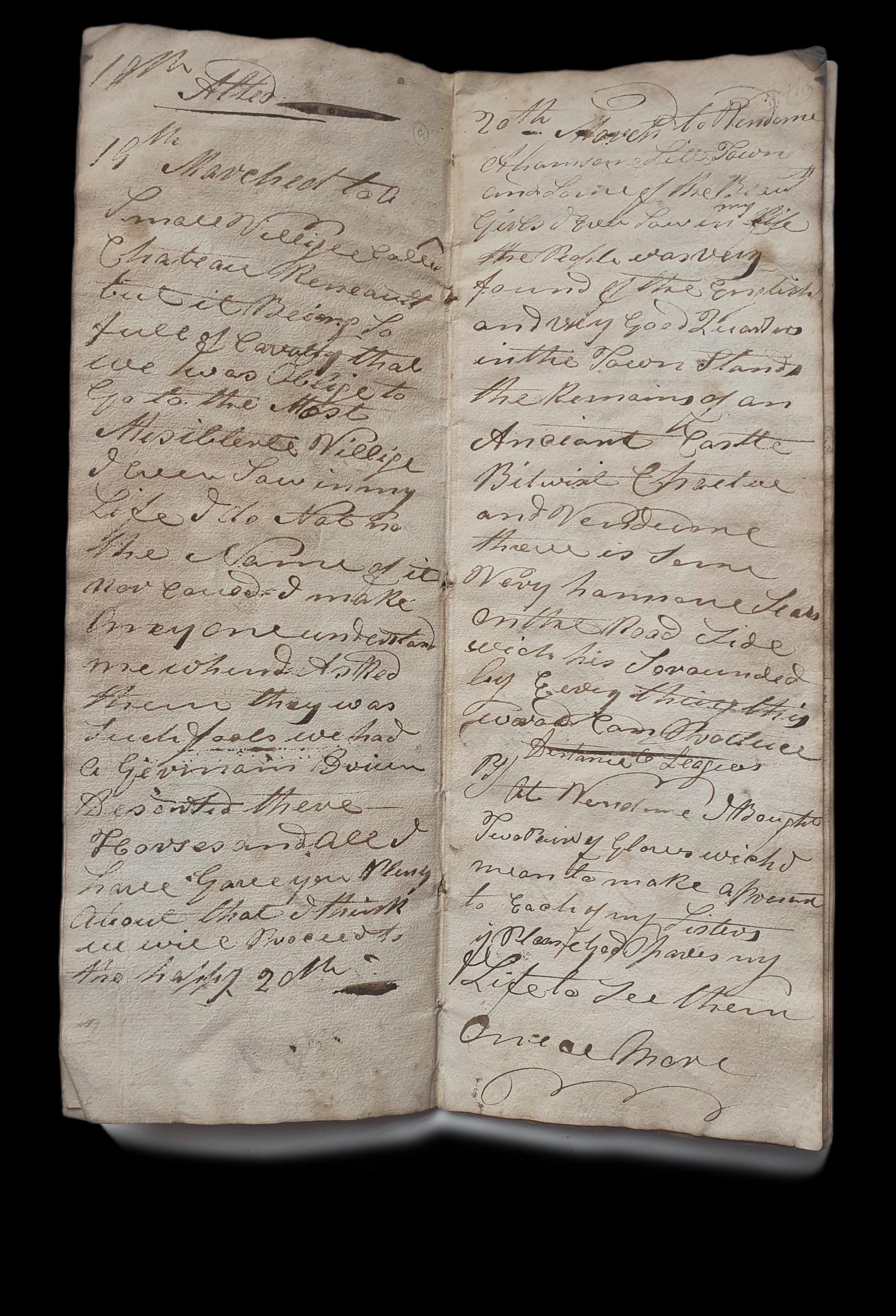
THIRTY-FOUR
SENECA, Lucius Annaeus, (circa 4 BCE-65 CE); FARNABY, Thomas (1575?-1647) (editor); WRIGHT, John (annotator). L. & M. Annæi Senecæ tragoediæ: post omnes omnium editiones recensionesque editæ denuò & notis Tho. Farnabii illustratæ.
Londini: Excudebat Thom. Snodham, 1624. Second edition. Pagination pp. [8], 366, [10]. Signatures: [superscript pi]A⁴ A-Z⁸

2A⁴. The last leaf is blank. Collated and complete. [STC (2nd ed.), 22219]. Contemporary English sprinkled calf, neatly rebacked with original spine laid down. Paper flaws to a few leaves with loss of two or three words to T2, lacking endpapers. (ESTC S117123).
¶ This second edition of Seneca’s tragedies, edited and with Latin commentary by Thomas Farnaby (“the chief classical scholar as well as schoolmaster of his time” (ODNB) whose editions were popular textbooks in the 17th century), has been annotated by its young owner, who has inscribed the title verso “John Wright his book” and dated the title page “1677” (his name can also be made out faintly on the front cover). Seneca was considered an apt author for study in Restoration grammar schools, since his “rhetorical bombast and dramatic violence” contrasted with his stoicism to provide “pleasingly contradictory tools to think with” (Fleming & Grant, p.10).
Wright has made annotations to some 90 pages, often attempting translation of a phrase he has marked in the text; for example, he renders the vengeful Medea’s “paria narrentur tua repudia thalamis” as the rather awkward “let thy divorce sound as great as thy marriage” (p.3)). Some annotations share with this example an epigrammatic quality that suggests he is
collecting pithy or striking sayings with which to impress his peers (“nothing pleases for she [Phaedra] is so unconstant” (p.47); “let ye stars be driven out of yr courses” (p.55)). Occasionally, he even ‘corrects’ the venerable Roman’s text: on p.84, for instance, he has crossed out the printed text “Quod varda fatum lingua” and replaced it with “qu varda fatu est lingua” – either at the urging of a master or out of his own sense of precocity. Among the pen trials and miscellaneous notes at the rear (which include the vertically written and decidedly Senecan phrase “riches are good but learning better”) is an inscription, reversed, on the final leaf: “H. S. E. Johannes filius Guliel: Berkenhead. d: Henstridge in Cont Somerset: hajus Collegii Chorista qui animam Deo Efflavae 12o Feb: Anno {Salutii 84 Ælatii 18”. This solitary reference to a young man of presumably similar age to Wright was probably copied from a tomb and suggests they were perhaps friends or acquaintances, but we have found no further evidence of a connection.
This carefully kept volume, with its original binding, survives as an artefact from a Restoration classroom that not only confirms elements of the school’s curriculum (Seneca, along with Greek and Hebrew, judging by some of Wright’s pen trials), but shows its young annotator seemingly coming to terms with the death of a friend –something for which reading the Stoics would have been ideal preparation.
£750 Ref: 8033
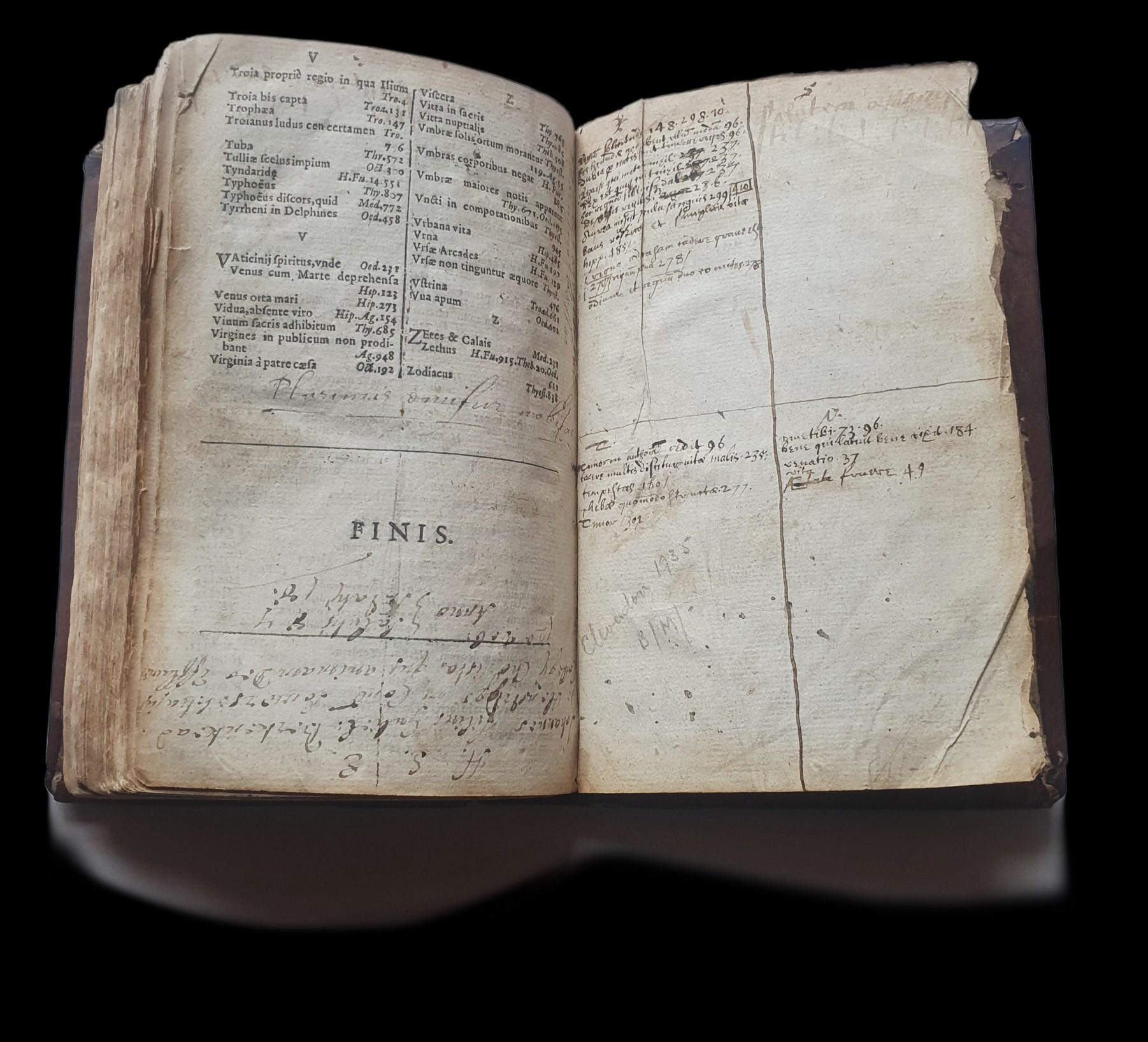
THIRTY-FIVE
[SPENSLEN (SPENSLEY?), John] A four-part love letter and five-part ‘Puzzle Purse’ entitled “The True Lovers Knot”.
[Circa 1837]. Nine folded sheets (each measuring approximately 130 x 130 mm unfolded). Comprising two folded love letters decorated with pen and watercolour hearts and motifs. One corner torn with loss, some closed tears long folds.
¶ Valentine Puzzle Purses – intricately folded, illustrated love letters that revealed their multi-paneled verse messages with each stage of their opening – became popular during the 18th century and have endured ever since. This example bears the date “1837” beneath the inscription “John Spenslen” (or “Spensley”). Some of the verses written here are found in other valentine ‘tokens’ of the period, from the relatively upbeat “When Loyal hearts are Crossed by none / True love will join them both in one / For I can find where hearts agree / There can no strife nor Malice be” to the gloomier “Cupid with his fatal Dart / Has Deeply wounded my Poor heart / And has between us set a Cross / Which makes me to Lament my Loss”. The fragile condition of these sheets contributes to the bittersweet qualities of the sentiments within.
SOLD Ref: 8163

THIRTY-SIX
[THOMPSON, Dr.] Manuscript notes on farming and gardening
[Chudleigh, Devon. Circa 1800-1825]. Quarto 207 x 160 x 30 mm). Pagination [2, index], [3, unnumbered remedies], 367 numbered pages, several illustrations. Original half sheep, rubbed and worn, joints splitting, spine worn. Engraved bookseller’s advertisement “Chudleigh” to front paste-down. Loosely inserted letter addressed to “Dr Thompson, Chudleigh”.
¶ This manuscript collection of agricultural and horticultural observations appears to be the work of one “Dr Thompson” of Chudleigh, Devon. The two pieces of evidence for this attribution being a loosely inserted letter addressed to “Dr Thompson, Chudleigh”, and the stationer’s label to the front paste-down of J. Efford, also of Chudleigh in Devon. Efford advertises “Bibles; Common-Prayer Books of different Sizes, and in various Binding” as well as “Spelling Books [...] Writing Paper of all Sorts [...] Indian, Japan and Common Ink; Dutch Quills” etc.
Thompson collects material on horticulture, agriculture and veterinary matters (from growing “Apricots” and “Cyder Apples” to the economics of animal husbandry and treating “the Scab” in sheep), with diversions into cheesemaking, viticulture, apiary (including “A Caution” on the swarming of bees), maintenance of regalia (receipts for “regimental blacking Balls” and “regimental Colouring for the belts” dated between 1753 and 1825 but appears to have compiled in the early 19th century. Attributions, which occur throughout, take in a wide array of sources, including periodicals (“Gent Mag”, “Bath Papers”), books (“An Invitation to the Inhabitants of England, to the Manufacture of Wines, from the Fruits of Their Own Country […] By R. Worthington […] 1812”), and individuals, including “Capt Farquarson”, who also penned the letter to Thompson recommending a “Method of Blanching, or Shelling Barley”.
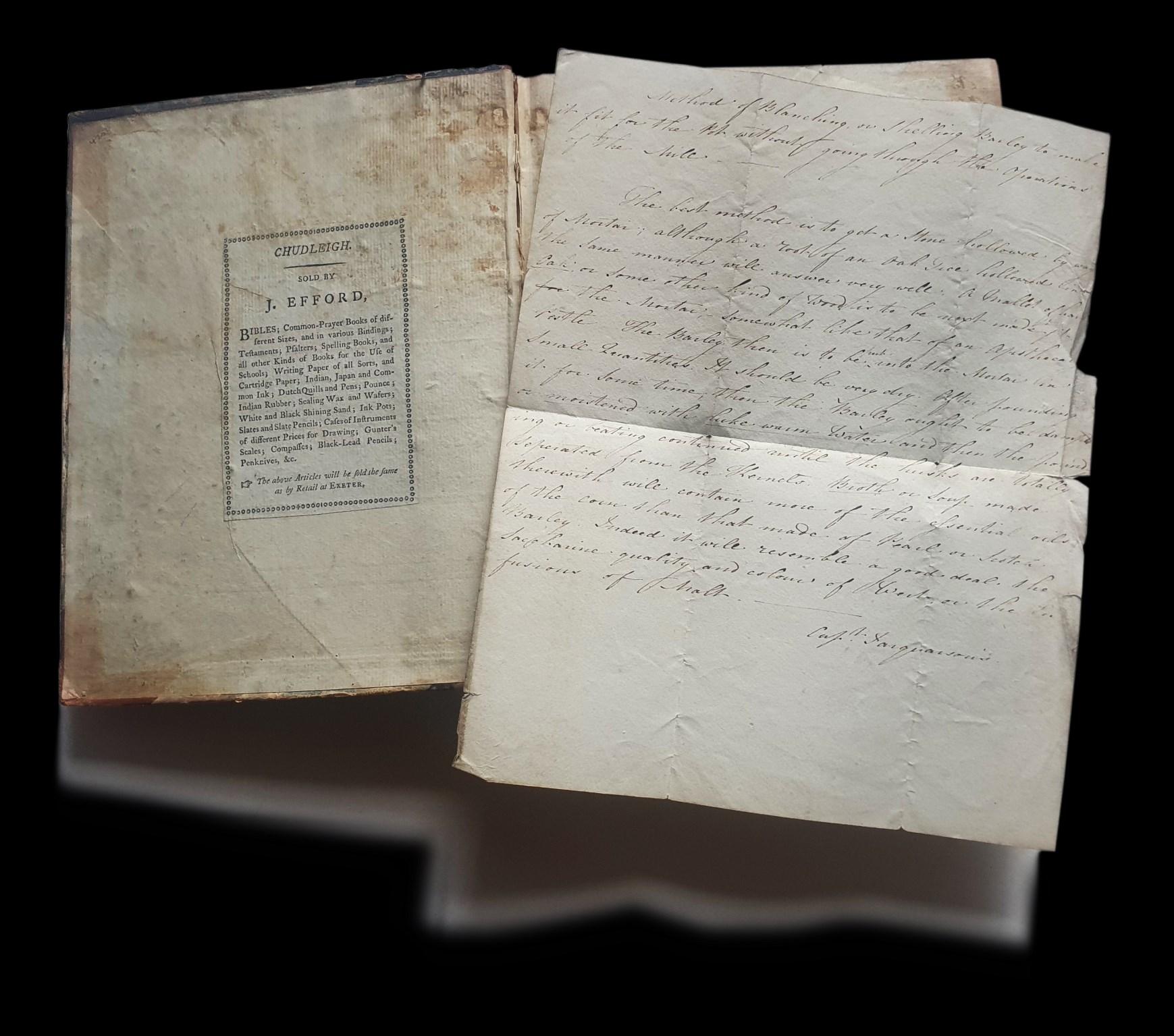
£500 Ref: 8142
THIRTY-SEVEN
HEY, Richard (1745-1835) Three related dissertations.
A Dissertation on the pernicious effects of Gaming. Cambridge: J. Archdeacon for J. & J. Merrill & T. Cadell, 1783. First edition. [Bound with]
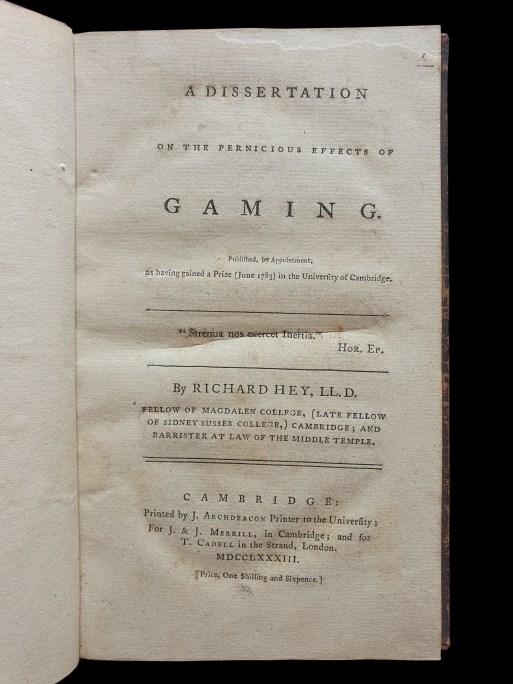
A Dissertation on Suicide. Cambridge: J. Archdeacon for J. & J. Merrill & T. Cadell, 1783. First edition. Contemporary tree calf.
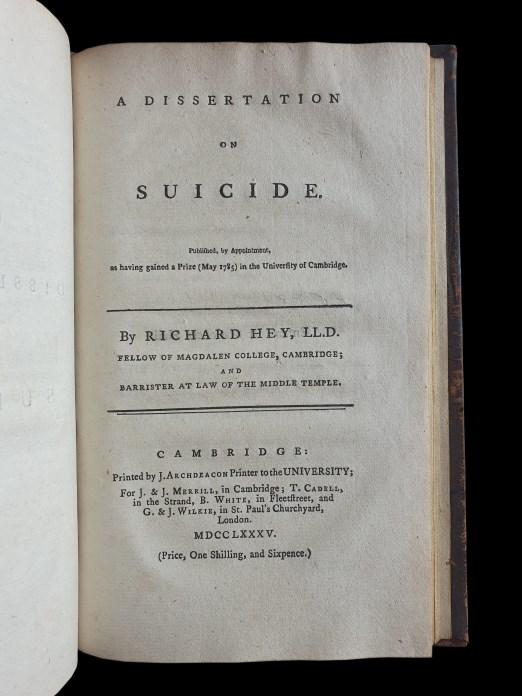
A Dissertation on Duelling. separately bound. Durham, Willliam Smith. 1801. Second edition. Bound separately in modern cloth.

¶ Richard Hey was an essayist and mathematician. He graduated BA from Magdalene College, Cambridge in 1768 and MA from Sidney Sussex College in 1771, the same year as he was called to the bar at Middle Temple. In 1792, he published Happiness and Rights, a response to Thomas Paine’s Rights of Man, but his Dissertation on the Pernicious Effects of Gaming (1783) is considered his “chief work” (ODNB) and won him a prize of 50 guineas from the University of Cambridge. Further prizes from his alma mater greeted his Dissertation on Duelling (1784) and his Dissertation on Suicide (1785), and the three essays were published together in 1812.
Hey’s ‘trilogy’ of linked dissertations is collected here: the first and last have been bound together, and the middle work (separately bound) is also included. Gambling addresses its topic under the broad headings of “Pernicious Effects upon the Fortune of the Gamester”, “Misery suffered by him”, and “Harm derived upon Others”, and concludes with mention of “Two points reserved” – points “sufficiently connected with what has gone before” but which “deserve a separate consideration”: duelling and suicide.
Hey’s two subsequent essays thus proceed from this first: the next, Dissertation on Duelling, treats duels as, in large measure, an outcome of many of the same vices as gaming. He laments the current “The Prevalence of Duels” and declares the worthiness of his mission to “remove a false Glare from a dazzling Vice”, he considers his subject with reference to factors such as “Equity between Individuals”, “the good Order of Society”, “Magnanimity”, and “Virtue”. Throughout, he strives to devalue the currency of “a peculiar Code which has obtained the title of, the Laws of Honour”, but which leave “the Merits of the Cause undecided”.
In the last essay, Dissertation on Suicide, Hey pursues his theme with notable compassion, advocating a “Gentleness of treatment” in dealing with “the persons whom we would retain from the commission of Suicide”. He nevertheless states the facts as he sees them, under headings including “The Guilt of Suicide”, “Suicide is Murder”, and “The Folly or Imprudence of Suicide”. Hey’s promotion, throughout all three dissertations of “Benevolence” in our dealings with others informs the conclusion of his final chapter, “The Prevention of Suicide”, when he advises: “when your good fortune presents you with an opportunity of relieving deep Distress, of conferring a great and durable Benefit, seize it with avidity”.


£950 Ref: 8158

[STEPHENSON, William (d.1723)] A True & p[er]fect Inventory of all & Singular the Goods & Chattells Rights & credits of William Stephenson late of Skelsmergh in the Parrish of Kirkby Kendall in the County of Westmorland. Blacksmith Deceased Taken & Appraised by Richard Smith Thomas Bracken & John Bracken all of Strickland roger and Thomas Fenton of Longsleddall all in the sd. County of Westmorland yeomen the Seventh day of May Anogh Domi 1723.

[Circa 1723]. Bifolium (410 x 162 mm). Ink on paper. 1 text page.
¶ In a grim ritual very familiar to the early modern period, the appraisers move through the late William Stephenson’s house with actuarial mien and begin their reckoning of his worldly goods with “His purse & Apparrell” before proceeding room-by-room to record the rest.
The necessities of sitting, sleeping and eating are well represented, but so too are “His Books” (valued at “1d 8s”) and “A Clock and Case” There are “Chairs & Stools in the Body Stead of the House”, “Bedding & Table Linnin in the Parlour loft”, several “Bedstocks”, then a “Brass Vessell”, an “Iron Pott”, a “Wood & Potter Vessell in the Kitchen” er “in the Buttery”, which also contains a “Pewther Vessell” and a Pan”. Stephenson’s outdoor activities are hinted at with the presence of Fowling piece”, then fleshed out with mention of such items as Husbandry Gear” and livestock including “Cow’s Heiffers & Steeres”, “Sheep”, and “Poultry”. Stephenson’s trade is acknowledged in the line “Smith Tooles Iron & Steele”, and his relative fiscal prudence is suggested by the two lines tallying his “Debts owing”, the value of which is happily exceeded by the “Book debts owing to the deceased”. After taking into account the “Debts and Funerall Expences in all”, the appraisers calculate his estate’s “Clear sums” to total “307 / 8 / 9¾” – a not insignificant amount for a blacksmith. SOLD
THIRTY-EIGHT
Ref: 8164
THIRTY-NINE
GILMOUR, Sir Alexander, 3rd Bt. (c.1737-1792), of Craigmillar, Edinburgh. A Collection of 37 Autograph Notes & Letters to Thomas Adams of Alnwick, 1780-83
[Warkworth, London]. A total of 43 notes and letters (37 written by Gilmour; 5 by his friend John White, and 1 draft letter by Thomas Adams.) A complete transcript of all the letters (barring a few tricky words) will be included with this collection.

¶ The trajectory traced by these letters is a downward one, as their writer tries to evade his creditors, battles gout and arranges for the existence of his lovechild to be kept secret (successfully, it seems, until these letters surfaced to correct the historical record). In the process he importunes a number of friends and acquaintances, leaving a trail of aggrieved individuals, yet still seems to command the loyalty and affection of at least a handful of supporters. This collection has interest as a document of social history and as a source of insight into the pathology of an ostensibly charming but dissolute and devious aristocrat.

Sir Alexander Gilmour was the only son of Sir Charles, Second Baronet of Craigmillar in Midlothian, Scotland. He succeeded to the baronetcy in 1750 and went up to St John’s College, Cambridge in 1753. As an officer during the Seven Years’ War, he was wounded and briefly taken prisoner in France in September 1758. He was appointed Clerk of the Board of Green Cloth in 1765, while pursuing a political career as MP for the County of Edinburgh between 1761 and 1774. The Cambridge Alumni website cites a statement in The Gentleman’s Magazine (1792) that he “married at a very early age and has left at least one son”, adding that this “appears to be incorrect”. While his marital status remains moot, this correspondence is the ‘smoking gun’ concerning the latter.
Gilmour moved in James Boswell’s circle during the 1760s, becoming a rival to Boswell for the hand of one Miss Catherine Blair, though she – an heiress who perhaps had a nose for rakish spongers – evidently rejected them both.
Debts and gifts
These letters, beginning in late 1779, are written to Thomas Adams (d. 1813), his solicitor in Morpeth, near Alnwick, Northumberland, who is clearly becoming embroiled in his affairs. The first few notecards and letters are brief and couched in a third-person formal politeness (“Sir Alexr. Gilmour presents his Complimts to Mr Adams”), but the purpose is largely transactional (“the last account clear’d with Mr Warrender”), and sometimes ingratiating (“He wishes much to see Mr Adams, & will take it as a particular favour, if he will either this evening eat a roasted Mutton [or] to-morrow at ½ past two o’clock, which ever is most convenient to himself”).

These blandishments continue: Adams is presented with “Partridges”, before Gilmour cuts to the chase: “The Bailiff who brought the Summons was the same who came here with Mr Hutchinson, so Mr Adams will have an opportunity of writing by him”.
In October 1780, the third-person courtliness is dropped in favour of a rather peremptory tone, as Gilmour’s problems seem to be heating up: “A person just now called on me saying he came to me from Mr Butler, I did not chuse to see him, and he wrote the inclosed letter, to which I made answer that the debt wou’d be discharged before the 1st of Novr. that you was the person of busyness employed by me here, and wou’d if he called on you speak to him on that subject, which I hope you will do.”

Dalliance and consequence
Gilmour’s pecuniary embarrassments are well known; the same cannot be said of another imbroglio that was brewing. In a letter dated 28 October 1780, after gently chiding Adams for some oversight or other, he extends another mutton-themed invitation, adding “I am authoris’d by a Lady now sitting by me to assure you, that you shall have a warm dry Bed”.
This “Lady”, one assumes (though we cannot be completely certain), is the lover he later refers to as “Queen Mab”, probably an allusion to the ‘fairies’ midwife’ referred to in Romeo and Juliet. The second half of the letters is largely taken up with the consequences of this liaison, as Gilmour strives to keep his lovechild secret.
The correspondence yields a likely timeline for the unfolding of this saga. In a letter from London dated 27 April 1781, he thanks Adams “for your attention to those I have left behind me” (perhaps his mistress, or his creditors – or both?) and asks “that you will send the inclos’d Letters to Henry Miners and Mrs Liddel” – both of whom appear to have been engaged as accomplices. From a letter two months later we can infer that Miners and his wife have taken in Gilmour’s pregnant paramour, though things have not gone smoothly: Gilmour addresses “all the complaints against Henry Miners &c”, which has left him “extremely vex’d”. He instructs that, if Adams discovers that the Miners have “in any shape attempted to behave ill to her, I do desire that she may on no account go back to them”. He uses a few choice words regarding “Molly Miners”, whom he considers “a very violent tempered woman”, whereas the man of the house elicits his sympathies: “a good natured honest man, under Petty coat government, and when drunk now and then says things for which he is very sorry for when sober”.
The main collection lacks any mention of the birth, but also included is a draft letter written by Thomas Adams to one Sir John Inglis on 28 May 1782, in which he states that “the Woman who lived with him ^Sir A. G. in this part County was delivered of a male child and the Child who is now at Nurse here, it is a fine little Boy and must be (?) abt 9 or 10 Months old”, indicating that the baby was born in August or September 1781.
Adams’ draft letter is the only correspondence that survives from the 21 months between September 1781 and June 1783, but from what one can glean of the often-illegible hand, Adams believes Gilmour is attempting to advance himself in London. At some point Gilmour is rejoined by his mistress, for he concludes his letter dated 13 June with “Queen Mab … begs that you wou’d now then send for little Charles to see if he is properly look’d after” (thus giving us the name of their son). In the same letter, he thanks Adams for “the trouble you took about my business with Henry Miners, inclos’d is the Bond to him” – this presumably a formal agreement concerning their guardianship of his son.

On 7 August he informs Adams that “Queen Mab has most graciously pleased to say she will deliver” his letter in person, since “Her Majesty … is gone upon a visit [to] young hopeful”, i.e. baby Charles. “She insists upon his being rechristned, and has made a point with me that I shou’d beg the favour of you, to assist at that Ceremony in the Capacity of God-father in which request I flatter myself you will indulge Her Majesty”.

It seems rather to be Adams that Gilmour is attempting to flatter, as part of a wider campaign of ingratiation and persuasion: back in February 1781 he reminds Adams to take “some steps about ^preventing Mr Saint or his brother Trumpeters from announcing the arrival of your God Son” and underlines the seriousness of the request with a report that “my poor Mother remain[s] exactly in the same melancholy state in which I found her” (Gilmour mentions his mother only twice, on both occasions mostly to elicit sympathy for his own predicament); elsewhere he complains about his gout (requiring “a Shoe large enough to contain the foot of a Patagonian”), his piles and other ailments.
By September 1783, matters have taken a turn. Gilmour writes of “the indispensible necessity of parting with Queen Mab”, though his principal concern is his son’s continued residence in Alnwick, no longer with the Miners but with someone named Hudson: “if you think the Child properly taken care of, and that there may not be some danger, of his contracting some habitudes, and hearing conversations in a public house, which I understand Hudson now keeps, which might not turn out so well for his future Advantage, I can have no objection; but precisely under this proviso, that you can obtain Queen Mab’s consent to it, as I shou’d look upon it, to be the height of cruelty to take the child from her in spite of her Teeth. … I see no necessity for it, till the Child is old enough to be sent to school, from which moment I mean he shou’d be totally under my care and direction, conceiving that from that instant, I am more capable to judge what ought to be done with him, than any Mother in the world can be.” But in a show of what he clearly considers magnanimity, he goes on: “I can see no reason for doing anything harsh or severe … I shall most willingly give my consent, that the Child shall … go with her for the present”.
Around this time, Gilmour confirms his plans for an “Allowance of £50 per ann.” to persuade “Queen Mab” to make a discreet disappearance: “I have no objection to granting her a Bond payable half yearly under the limitations I mentioned to you … she must on no account return to London”.
Shortly thereafter, a dispute arises over her refusal to “comply with my desire of returning to her Mother at Fort-William”, the only option that, Gilmour considers, “can contribute to her own future advantage, as to well as to mine and that of our Child”. In what is probably a signal of alienation, Gilmour begins to refer to her as “Mrs Moody” (her real name or an epithet?), until the final letter, in late October, when the dispute seems settled and her nickname restored, he pronounces himself “glad that Queen Mab has agreed to set out for Edinburgh”.
The letters tell nothing of the fate of little Charles and his mother, ending before Gilmour’s imprisonment in London in 1784. After a drawn-out decline in France hiding from his creditors, he died from gout in December 1792, and the baronetcy and main line of the family became extinct.


This collection of correspondence, in contrast, brings back to life a scandal that hitherto only existed as a rumour, and conveys the strenuous efforts that Gilmour took to keep it that way.
SOLD Ref: 7983
FORTY
HANWAY, Jonas (1712-1786). Two scarce works in one volume: Three letters on the subject of the Marine Society. Let. I. On occasion of their clothing for the sea 3097 men, and 2045 boys, to the end of Dec. 1757. II. Pointing out several Advantages Accruing to the Nation from this Institution. III. Being a full detail of the rules and forms of the Marine Society. With a List of the Subscribers to the 16th of February, and State of Accounts to the 23d of March, 1758. To which is prefixed, a general view of th motives for establishing this society. [bound with] Two letters. Let.IV. Being thoughts on the means of augmenting the number of mariners in these kingdoms, upon principles of liberty. Let.V. To Robert Dingley, Esq; containing moral and political reasons for relieving prostitutes who are inclined to forsake their evil Course of Life. London: [s.n.], Printed in the Year M.DCC.LVIII. [1758]; London: [s.n.], Printed in the Year M.DCC.LVIII. [1758]. FIRST COLLECTED EDITIONS.
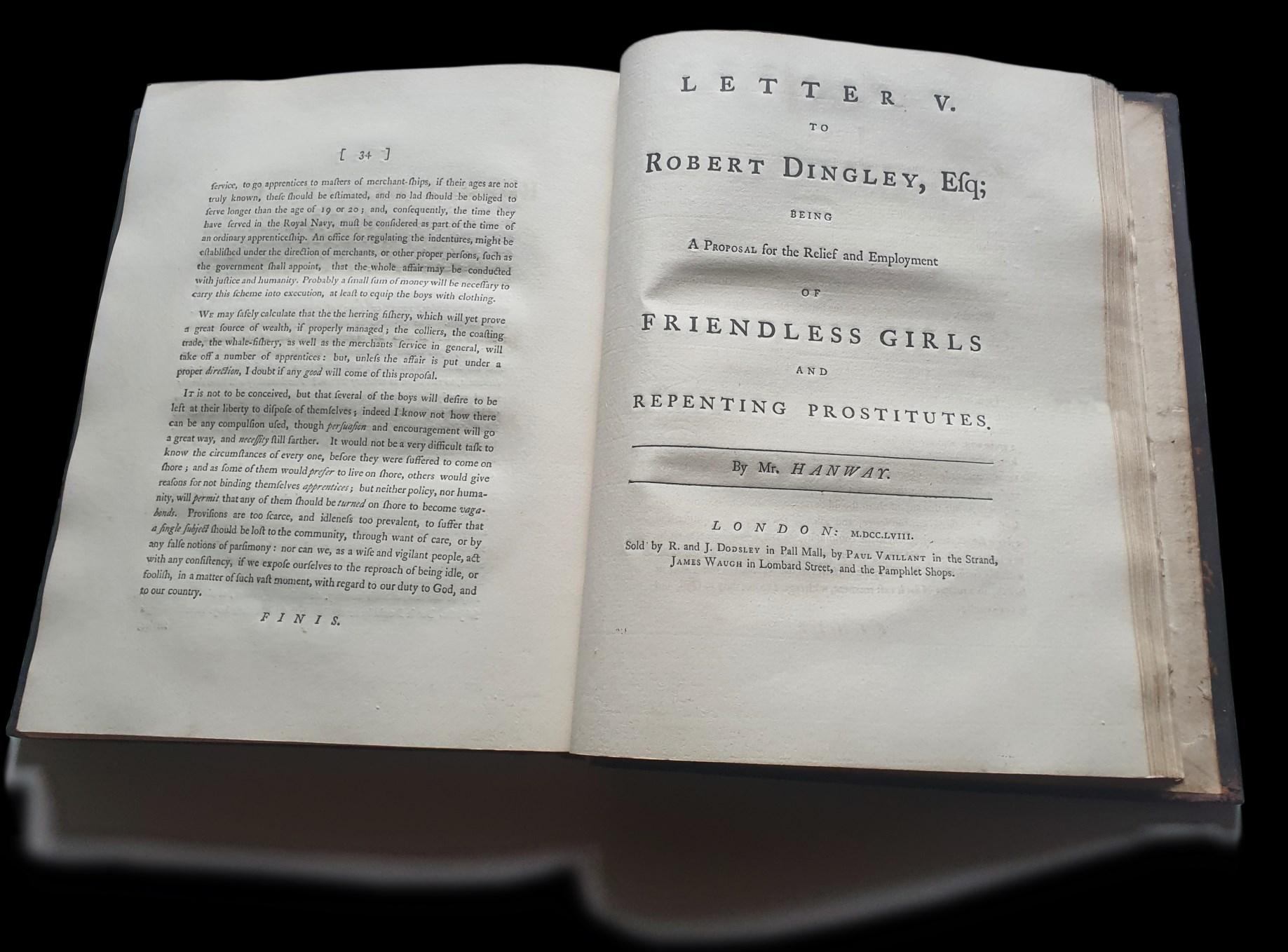
Quarto. Pagination [2]; vi, 8, 24; 23, [1]; 67, [1]; 11, [1] p., frontispiece, and inset plates; [2]; [2], 34; 35 [1], p. Letter III interleaved with blanks. Both volume collated and complete. [Goldsmiths, 9406 and 9408; ESTC, T93944 and T93943]. Contemporary calf, rubbed, rebacked preserving old title label. An excellent clean wide-margined copy on thick paper. Provenance: bookplate to paste-down of the scholar, bibliophile, and bookseller, Arnold Muirhead (1900-1988).
¶ This is a scarce, complete and handsome set of Jonas Hanway's five letters on two of his most dearly held philanthropic enterprises: the Marine Society, which he established in 1756 to equip and prepare destitute men and boys for a livelihood at sea (four letters); and the Magdalen Hospital for Penitent Prostitutes, which he co-founded in 1758 (the fifth and final letter). Each has a separate title page, pagination, and register.
Hanway was a merchant and philanthropist, often remembered for being the first man in London to carry an umbrella (for which he was widely mocked) and his opposition to tea (for which he was mocked by Samuel Johnson), he plunged himself into numerous benevolent causes, among them smallpox inoculations, the working conditions of young apprentices of chimney sweeps, the fate of infant children in workhouses, and a charity for girls abandoned to prostitution (hence his enthusiastic support for the subsequent Magdalen Hospital for Penitent Prostitutes). Among his most successful works was the Registers Bill (later dubbed ‘Hanway’s Act’), designed to improve the lives of workhouse children, which has been called “the only piece of eighteenth-century legislation dealing with the poor which was an unqualified success”, and the establishment, in 1756, of the Marine Society. The Society’s mission was to provide good education and employment to poor boys, which in turn supplied the British Navy with thousands of much-needed, well-trained seafarers. It is the world’s oldest public maritime charity, which still exists today.
 £1,250 Ref: 8155
£1,250 Ref: 8155
FORTY-ONE
17th-century manuscript entitled ‘A Short Character of Charles the Second King of England’.
[SHEFFIELD, John Duke of Buckingham (1647-1721)]
[Circa 1690]. Folio (323 mm x 208). Page dimensions: 293 mm x 193 mm. Text to 5 leaves, plus 1 blank. Watermark: Horn with letters AJ beneath. Similar to Haewood 2686-90 (which he dates, 1680-93) but none of these have AJ beneath. According to Haewood, AJ is probably Abraham Janssen. See Haewood: 409, 453, 2718, which he dates 1680-90. The binding is a 20th-century remboitage. It is bound in early 18th-century blind-panelled calf, with gilt-blocked royal arms of King George I on each side. It has been recently rebacked, with a new spine label and endpapers added. The paper was originally folded and a near contemporary paper spine titled in manuscript. It is mostly hidden in the fold but appears to read “A Character his Mai of”.
¶ Scandal and controversy were bywords for King Charles II’s reign, and this manuscript, which would have been handed around like a little morsel of gossip, does nothing to restore his reputation. Perhaps the most solemn moment comes at the beginning which “according to custom” states “his Religion, which since his death hath made so much noise in the world, I yett dare Confidently affirme it, to have beene onley that which is vulgarly tho’ unjustly counted none att all, I mean, Deism”. Here, the scribe addresses rumours of King Charles II’s Catholic sympathies. But rather than infer any strong faith, he says the King’s beliefs were arrived at languidly, through a “carelesness of his Temper then either Reading or much Consideracon”, and although he ascribes to him a “quickness of apprehension”, it was “his natural lazyness” which guided his opinions, lest “he should be troubled with examining which was best ~”.
In an amusing conceit, the writer draws an analogy between himself as Raphael and the King as the sitter, hoping that any compositional flaws “be recompensd in the agreeableness of the subject, which is sometimes enough to recommend a Picture, tho’ ill drawne, and make a face ^one likes, oftner looked on, then the best piece of Raphaell”.
Our ‘Raphael’ presents a mixed and sometimes unflattering picture of his sitter in an easy, familiar tone. We learn that the King was “Full of disimulacon and very adroit, at it, yet no man easier to be imposed upon”. He was also “Easy and good natured to all people in tiffles, but in great affaires sever and inflexible”. The scribe frequently alights upon the King’s dilettantism (“His understanding was quick and lively in little ^things and sometimes would soar high enough in greate ones, but u^nable to keepe it up with any Long attention or Applycation”) and lingers on his sexual proclivities (“there was as much of Laziness as of Love in all those houres he passed among his Mistresses, who, after all, only serve to fill up his Seraglio”); but, in a bid for even-handedness, we are told of his “setting his whole heart on the faire sex, yet neither angrey with Rivals”.
Before its publication in 1696, this text circulated in manuscript, or as the introduction to the first edition says, “many Coppies” of it were “handed about”. Only with its 1725 reprinting was it revealed as “Written by John Duke of Buckingham, Lord President of Her late Majesty’s PrivyCouncil”.

John Sheffield, first duke of Buckingham and Normanby, was a statesman, poet, essayist and patron to Dryden and Pope. He is perhaps best remembered for his Essay on Poetry (1682). The ODNB says he was “probably the author of the Essay on satire which circulated in manuscript in 1679 and attacked prominent figures at court including the king and Rochester; Dryden was blamed and physically assaulted, but the friendship between patron and poet survived.” It is not clear whether he deliberately suppressed his authorship of the Short Character… in his lifetime.
Manuscript copies in library collections:
National Library of Scotland:
‘A Short Character of Charles the Second &c’: I have pitch’d upon the Character of King Charles the second … tho’ he found his Error in this, but I confess, of little of the latest. Unsigned; [?late seventeenth century]. ff. 238-9.
Cambridge University:
A short character of Charles the Second King of England by someone who knew or served him 17th cent (Add 9322).
One is also recorded in an old bookseller’s catalogue: ‘A Second catalogue of Manuscripts. John Cochran. 1837.’: 436 Charles II. The Earl of Mulgrave's Short Character of Charles the Second in the year 1688. Manuscript, neatly written. Quarto, 10s. 60 .
Printed editions:
First published anonymously as: The character of Charles II. King of England. London: by Richard Baldwin. 1696. [Wing, B5336].
ESTC records three reprintings under the new title, A short character of Charles II. King of England. Two reprints in 1725, recorded as the sixth and seventh editions; a 1729 without edition statement.
Eliding the introductory material, the most notable difference in the publications is the addition of a final paragraph in the later editions. This is also in our manuscript; but rather than indicating ours was copied from the printed editions, we suggest the reverse to be the case. The 18th-century editions claim to have been “Printed from the Original Copy” – a phrase probably intended to imply that the reprint is more authoritative than its predecessor. But several “originals” existed, as the 1696 edition attests, and our manuscript appears to be one of these.
The physical features also point towards this being one of the pre-publication circulated manuscripts. It has been folded for posting, or, as the 1696 edition puts it, “handed about”, and the final sheet (part of which has been wrapped around to “bind” the text together) contains the now partially obscured inscription “A Character his Mai of”.
Unfortunately, the manuscript has been “pimped” by a modern owner. They have used two early 18th-century blind -panelled calf boards, with gilt-blocked royal arms of King George I on each side, which they have rebacked in calf. Although this creates an impressive-looking artefact, the binding does not match the size or the date of the manuscript, resulting in a misleading remboîtage which, although it diverts our attention from the way the manuscript would originally have been circulated, is itself a fact of book ownership and the long history of books.
£1,000 Ref: 7957

FORTY-TWO
[CHIFFINCH, Thomas (1600–1666); WALKER, Sir Edward (1611-1677)]. Fine 17th-Century Grant of Arms
[Circa 1664]. Single skin (515 x 393 mm). Vellum. Fine and clean condition but lacks the seal. The colours are bright and crisp, including the gold, which is uniformly bright.
subjects were rewarded for their fidelity. One such was Thomas Chiffinch who, we learn from this grant of arms, “served & attended his Sacred Matie. even from his Infancy” as “one of the Pages of his Maties. Bed Chamber”. Having “served all the time of his Exile in Forraigne parts, & returned unto England with his Matie.”, Chiffinch was promoted to “Keeper of his Private Clossett, & Comptroller of the Excise”, and granted the “Coate of Armes & Creast” detailed here.
This grant, confirming a new patent which could be passed to his “Heires & Descendants of his Body for ever”, was issued in 1664 (not 1644 as stated by Westminster Abbey, ODNB, Wikipedia, etc where it is also wrongly recorded as granted by Charles I, rather than by “our Soveraigne Lord Charles the Second”, a fact confirmed by Foster1). It includes additional information and a more flowing description than appears in the abridged patent and in printed heraldic works (Guillim gives a shortened version; Papworth only records the slightly later shield which was differenced to silver for Thomas’ brother, William, and the Crest does not appear in Fairbairn) which usually repeat the abridged notes found in early printed or manuscript works (Add. MSS 14,293 and 14,249).

The iconography is intriguing and raises many questions. The “Coate of Armes” are: “Or. on a Chiefe Imbatled Gules three Leopards heads, Or, Langued Azure”. Leopards are regarded as a royal emblem and, according to Guillim, “the head […] in heraldry is considered the most honourable member”. The colours red and gold (“Gules” and “Or”) often have royal associations, so may refer to his long and close connections to Charles II. The “chiefe imbatled”, also an unusual choice, may be a remark on his loyalty during the recently concluded “time of Warr”. The “Creaste” is similarly enigmatic: “upon a Helmet Proper Mantled Gules, Doubled Argent, & Wreath of Colours. A Demy Drago Gules holding in the Dexter Paw a Key Argent”, which, for those unacquainted with heraldry’s obfuscatory language, is illustrated “As in the Margent hereof more lively depicted”
The beautifully painted dragon is something of a mystery, but the key (associated with Saint Peter’s keys to heaven, and more widely with knowledge) probably refers to his new office (“Keeper of his Private Clossett, & Comptroller of the Excise”).


The grantee, “Thomas Cheffinch” (i.e. Chiffinch), was born at Salisbury, Wiltshire and “was brought to the court of Charles I by Brian Duppa, bishop of Salisbury, in 1641” (ODNB). He became a dependable courtier and royal official who “was trusted fully in delicate money matters, and he seems to have been worthy of the confidence reposed in him.”2 Following the execution of Charles I, he accompanied the future Charles II into exile in France. In 1663 Charles granted Chiffinch, jointly with Thomas Ross, the office of receiver-general of the revenues from the foreign plantations in America and Africa.
Chiffinch died in Whitehall on 6 April 1666. The royal court were shocked and saddened by the event, and Samuel Pepys shuddered at the memento mori:


“He was well last night as ever, playing at tables [backgammon] in the house and not very ill this morning 6 aclock; yet dead before 7 they think, of an imposthume in his breast. But it looks fearfully among people now a days, the plague, as we hear, increasing everywhere again.”3
The grant was issued by Sir Edward Walker (1612-1677), a highly regarded herald who began his career in 1633 in service of Thomas Howard, earl of Arundel, through whose recommendation he was appointed Blanch Lyon pursuivant-extraordinary in 1635. He was promoted through the College of Arms, becoming Garter in 1645 and receiving a the same year.The grant is signed “Edw: Walker, Garter”, without a countersignature, perhaps reflective of the eminence he regained after 1660.
Sir Edward also merits a footnote in the after-history of William Shakespeare. As ODNB notes: “On 18 May 1675 Walker bought for £1060 from the surviving trustee of Elizabeth, Lady Barnard, William Shakespeare's grandchild and heir, a house called New Place in Stratford upon Avon, which had been the poet's last home. However, he does not seem to have lived there”4 – so perhaps the purchase was intended simply to burnish his own pedigree by association, as so many heraldic works are designed to do.
£2,800 Ref: 8162
1.Foster Joseph; Ryland, W. Harry Rylands. Grantees of arms named in docquets and patents to the end of the seventeenth century. p.50 (2016).
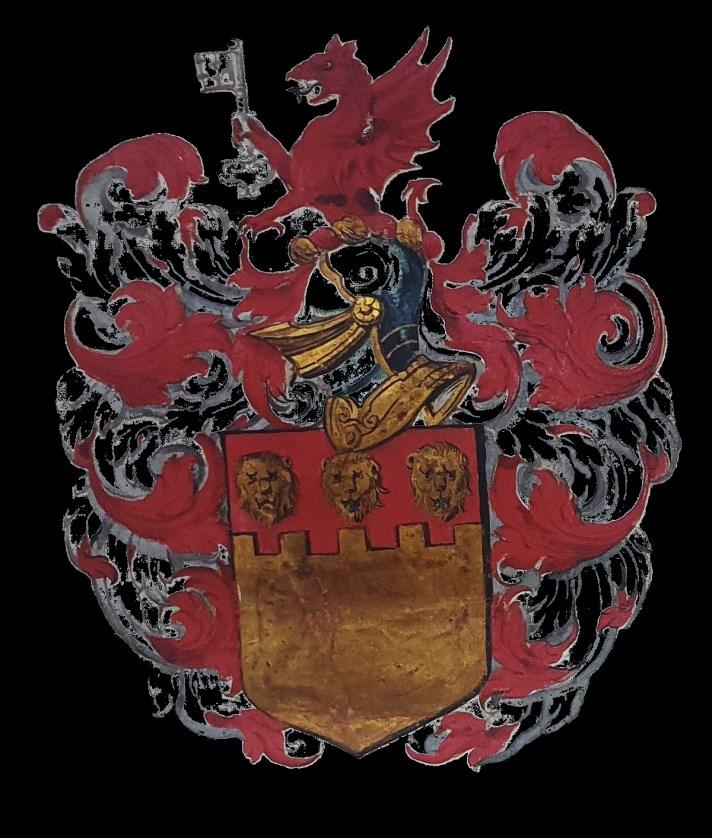
2.< https://www.oxforddnb.com/display/10.1093/
ref:odnb/9780198614128.001.0001/odnb-9780198614128-e-5280?
rskey=GnI6Xw&result=2>
3.Ibid.
4.< https://www.oxforddnb.com/display/10.1093/
ref:odnb/9780198614128.001.0001/odnb-9780198614128-e-28475?
rskey=XTf5qe&result=2>
I specialise in interesting and unusual manuscripts and antiquarian books that record their histories as material forms, through the shaping of objects and the traces left on the surface, by the conscious and unconscious acts of their creators and users.

Dean Cooke Rare Books Ltd



125 York Road, Montpelier, Bristol, BS6 5QG, UK
+44 7747 188 125


www.deancooke.org
dean@deancooke.org
@invisibl_inks
invisibl_inks

















































 £750 Ref: 8111
£750 Ref: 8111








 Thomas Browne Dr of Physick.
Thomas Browne Dr of Physick.


 Thomas Fale.
Thomas Fale.






























 £1,250 Ref: 8155
£1,250 Ref: 8155

































